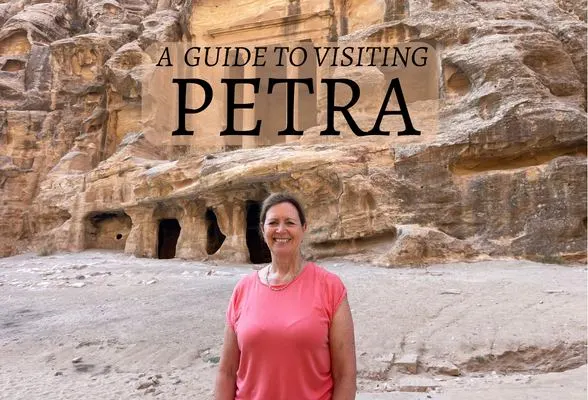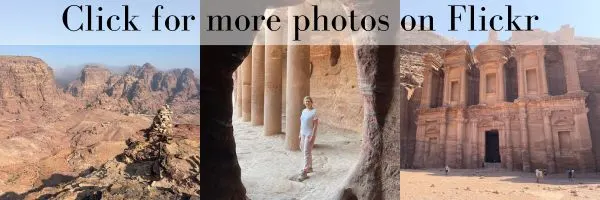Visiting the ancient city of Petra is a magical highlight of any trip to Jordan. Discover the top things to do in Petra, some hidden gems and our 1 and 2 day itineraries for how to make the most from your visit.
Follow in the footsteps of merchants on the Silk Road, as the narrow gorge of the Siq opens up to reveal a mysterious glimpse of the Treasury. There’s so much to see at this huge archaeological site, with hundreds of tombs, temples and hiking trails.
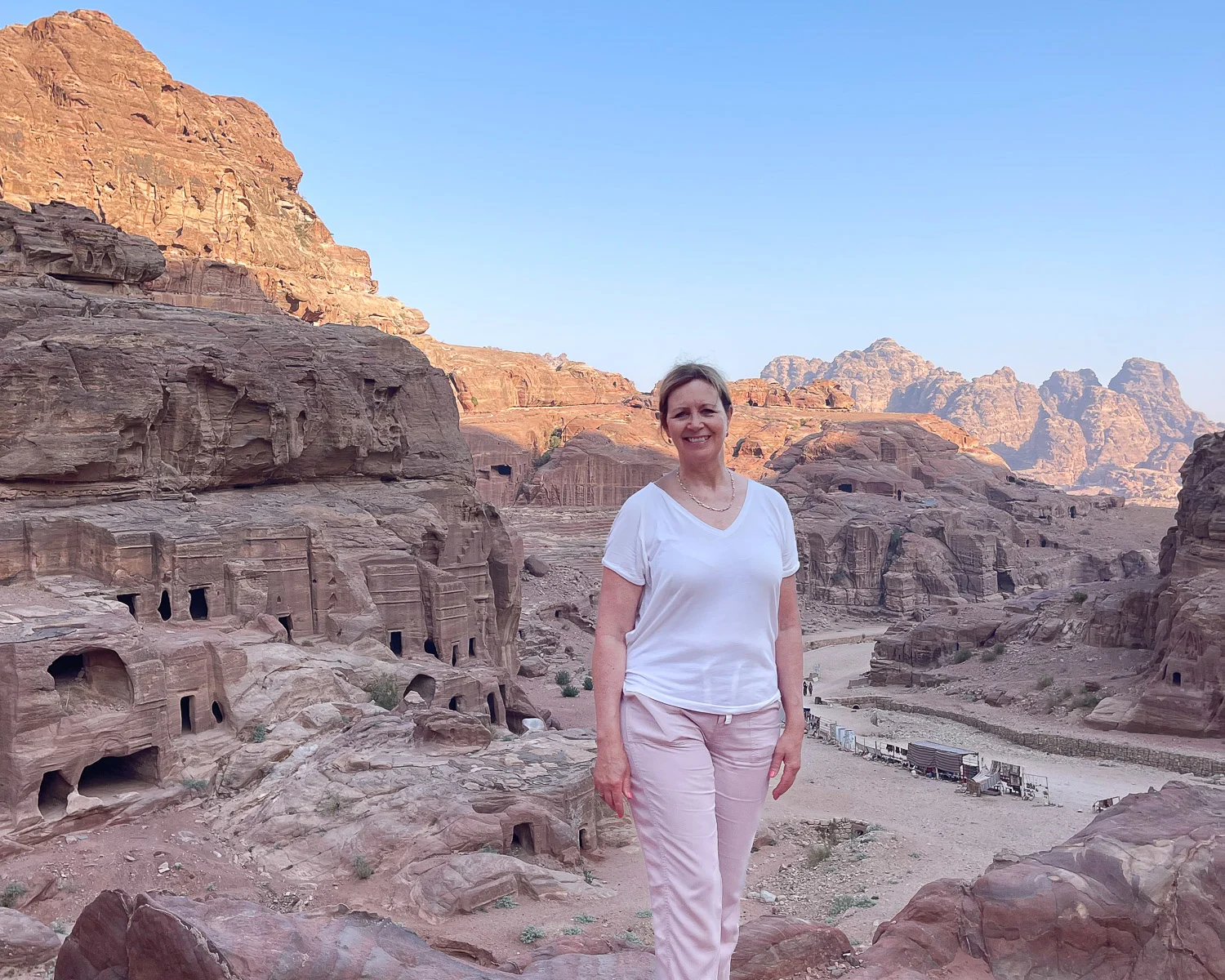
This article may contain affiliate links that provide commission on purchases you make at no extra cost to you. As an Amazon Associate I earn from qualifying purchases.
A short history of Petra
Most of the notable monuments and tombs of Petra were built by the Nabataean people, who dominated the region in the 1st and 2nd century AD. Originally pastoral nomads, the Nabataeans built up a trade network to control the lucrative overland spice trade from Asia to the Mediterranean. Their capital, Petra was built from the 1st century BC and in its heyday housed 30,000 people.
Petra was a major city on the Silk Road, where merchants could rest safely in a protected valley, before continuing across the desert. The Nabataeans were skilled engineers, creating dams and water channels, that provided the city with fresh water and irrigation, to grow crops in the surrounding area.
As the spice trade shifted westwards to easier routes along the Red Sea and Dead Sea, the Nabataean Empire declined and the Romans eventually annexed their territory. Petra continued as a thriving Roman settlement, until an earthquake in the 4th century AD destroyed much of the city.
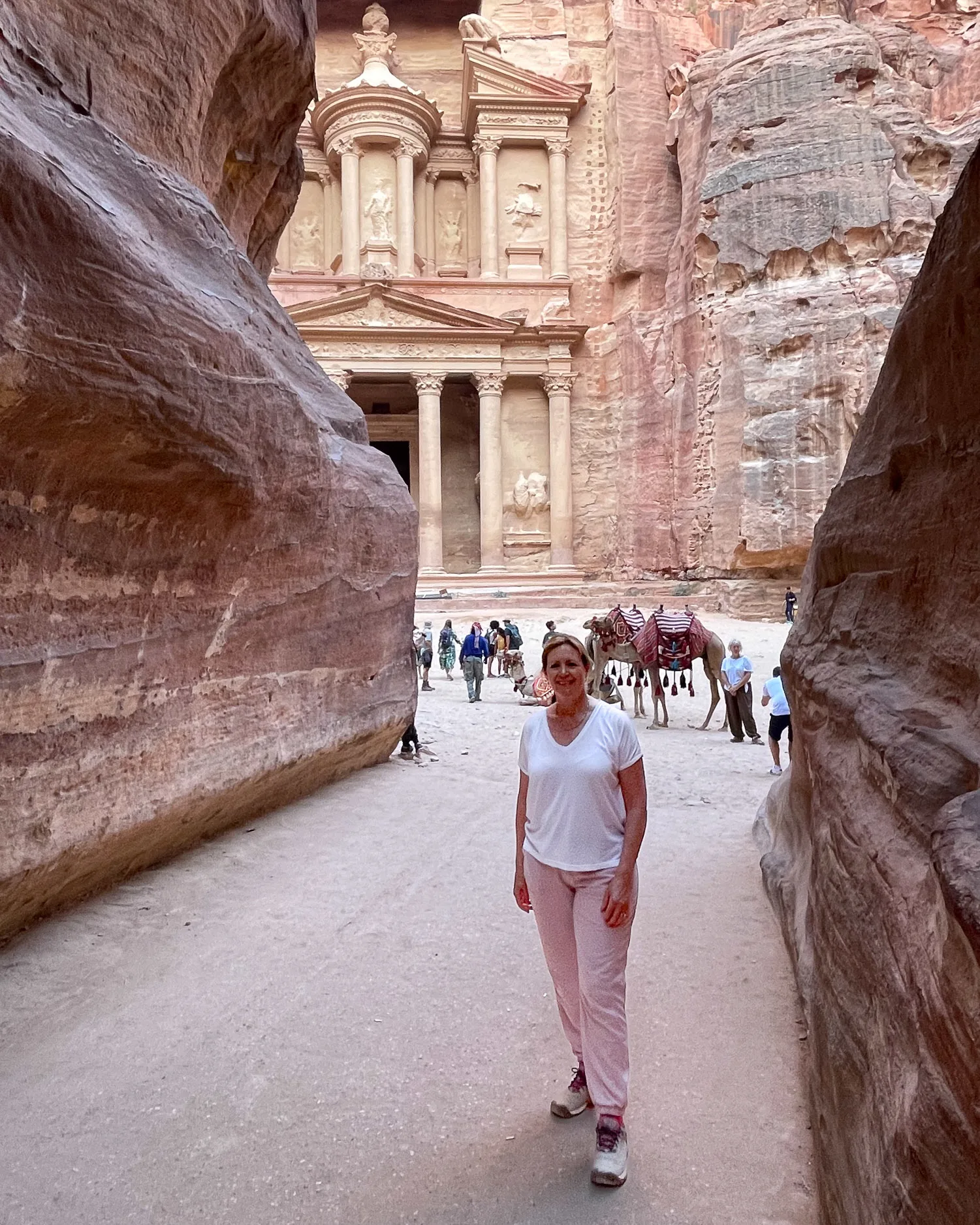
Petra is ‘rediscovered’ by European travellers
In later centuries Petra was abandoned and taken over by local Bedouin who used some of the tombs and buildings as houses. But a visit in 1812 by the Swiss Explorer Jean Louis Burckhardt, who entered the city disguised as an Arab pilgrim, awakened the interest of 19th century European travellers in Petra.
Artists such as David Roberts who visited Petra in 1839, created lithographs that are still sold in Petra today. His images put the ‘Rose-Red City’ on the wish list for many Victorian travellers. In 1985 Petra was declared a UNESCO World Heritage Site, and in 2007 was voted one of the 7 Wonders of the World.
In this article we’ll be covering the best things to do in Petra, but we also have another article about Petra, that offers tips and advice to help you plan your visit, such as when to go, prices, weather, avoiding scams, what to wear. Read about Visiting Petra in Jordan – the ultimate travel guide
Top things to do in Petra
Since Petra is a huge open air archaeological site, if your time is limited to one day or less, you’re unlikely to see everything. With this in mind here are the must see attractions in Petra.
Read about our canyoning adventure at Wadi Mujib in Jordan
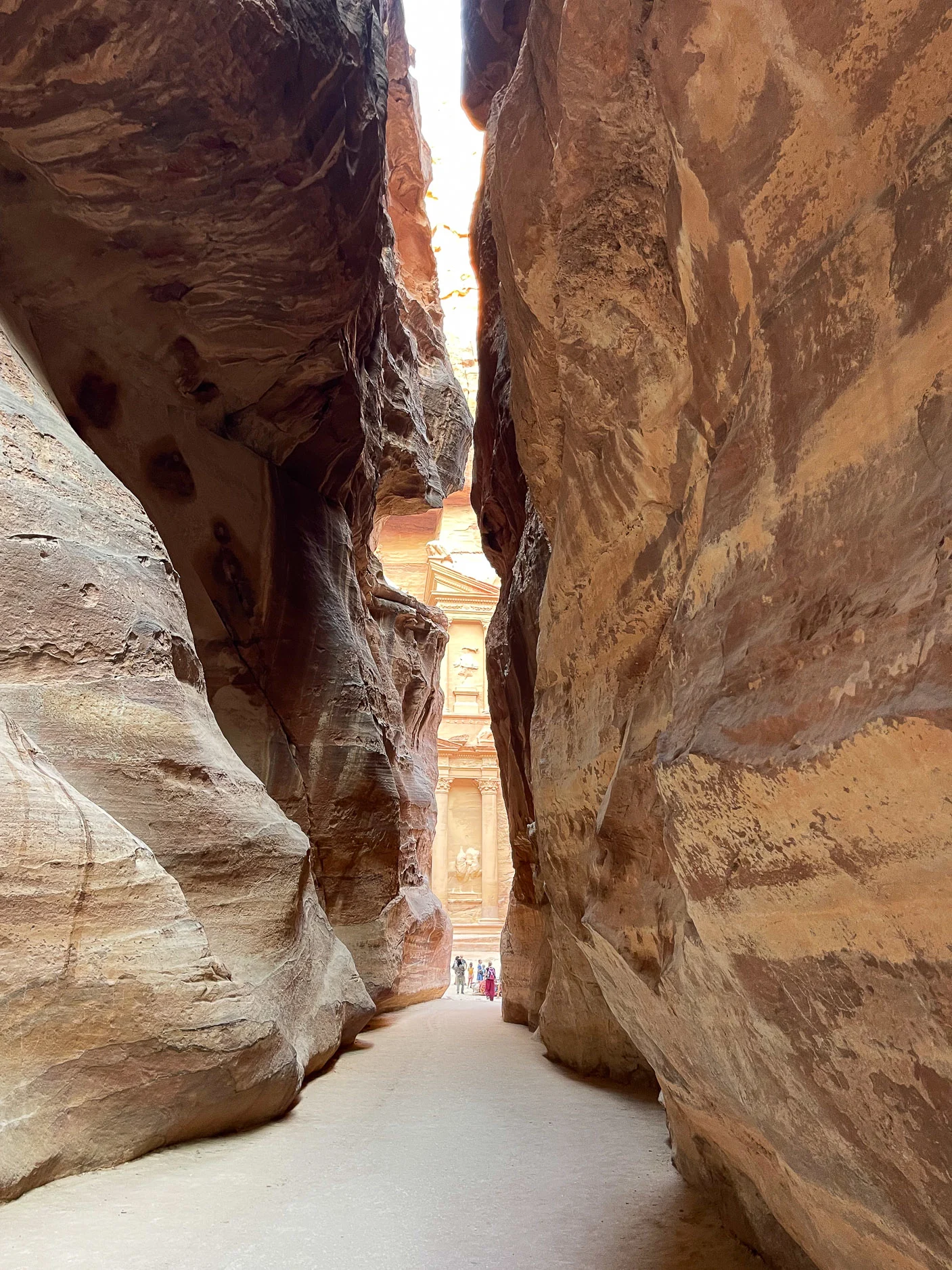
The unmissable highlights of Petra
- Al Siq – the narrow gorge that leads you into Petra, ending at the Treasury
- Treasury (Al Khazna) – Petra’s most famous view of the enormous carved facade of this rock tomb
- High Place of Sacrifice – a beautiful and easy to follow hike trail leading to wonderful views over Petra’s ancient “city centre”
- Royal Tombs – a series of stunning tombs carved into the side of a cliff
- The Monastery (Ad Deir) – A tomb with a carved facade that rivals the Treasury, reached by an arduous hike of over 800 steps
- Petra by Night – Lanterns light the sides of the Siq and Treasury for a cultural and light show
- Little Petra (Siq Al-Barid) – a short drive from the main Petra site, this gorge contains beautifully carved tombs
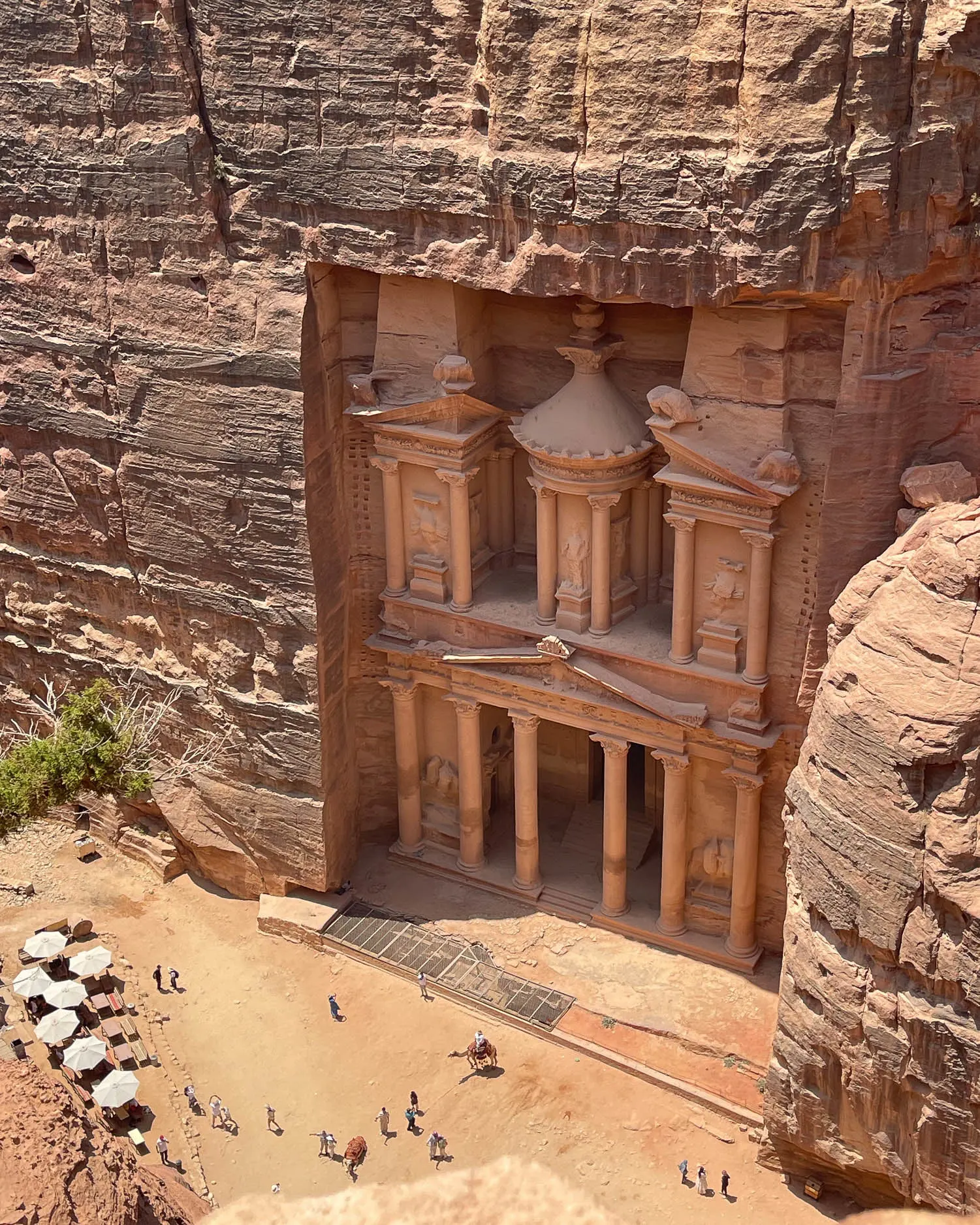
More things to do in Petra if you have time
If you have additional time after covering the key highlights above, here’s what you should see.
- The Theatre – built in the 1st century AD by the Nabataeans and later expanded by the Romans
- Great Temple – remains of the ancient temple complex with columns and stone walls
- Colonnaded Street – columns from the main shopping street in the ancient city of Petra
- The Church – remains of a 5th century church with mosaic floors
- Treasury Viewpoint – View the Treasury, for photos from the cliffs above, in two different locations
- The Petra Museum – an excellent modern museum with all the artefacts from Petra
- The hike from Little Petra up to the Monastery – a stunning hike that brings you to the Monastery by Petra’s ‘Back Door’
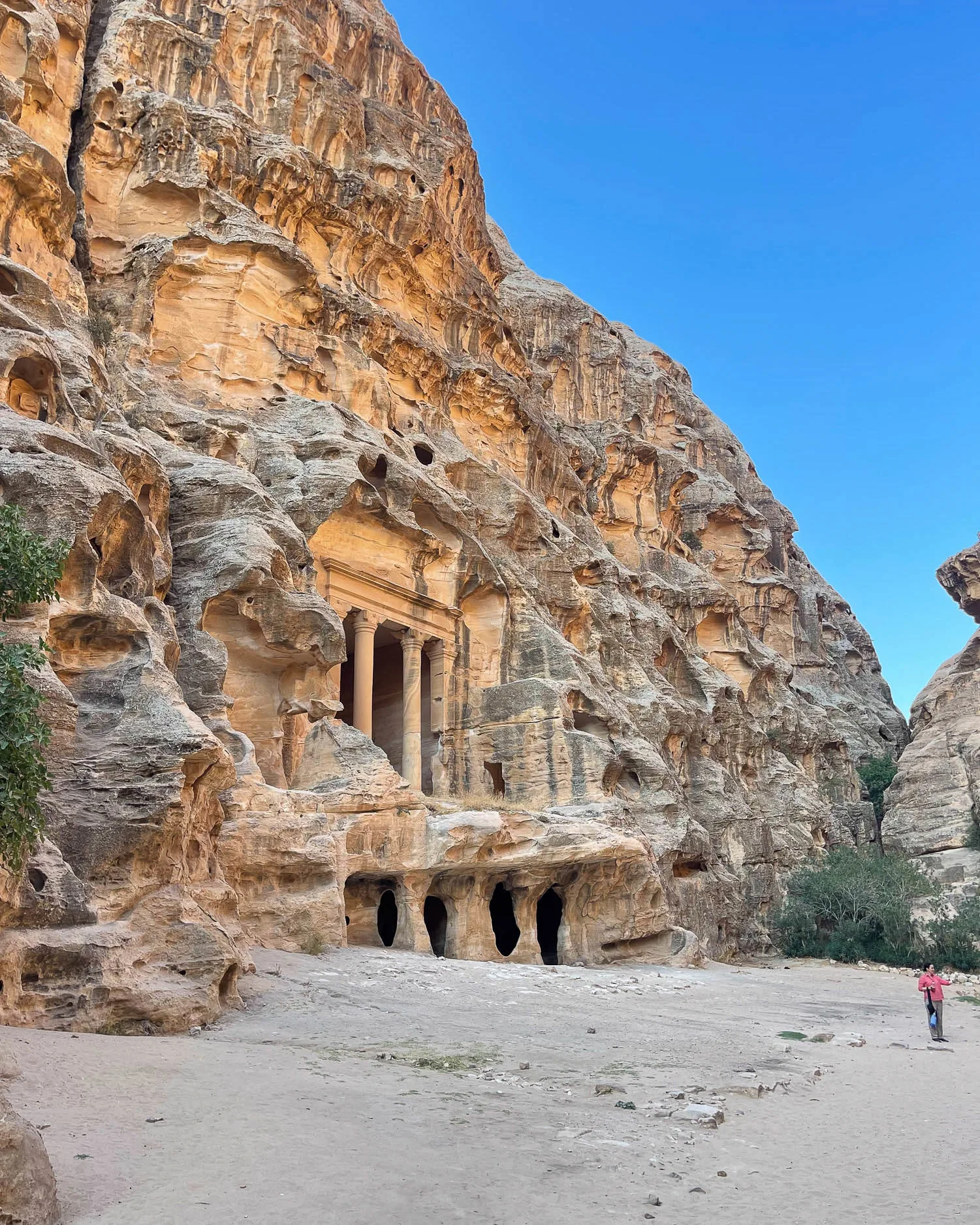
You’ll find more information about the top things to see in Petra, later in this article. But first let’s consider how best to spend your time at Petra.

Need help to design your dream holiday? We’ve partnered with UK travel advisor Luxeco Holidays to create your personalised itinerary
A 1 day itinerary for Petra
If you only have a day in Petra, we recommend starting as early as possible, ideally when the site opens at 6am. Expect a long day, with lots of walking, so take breaks when you need them.
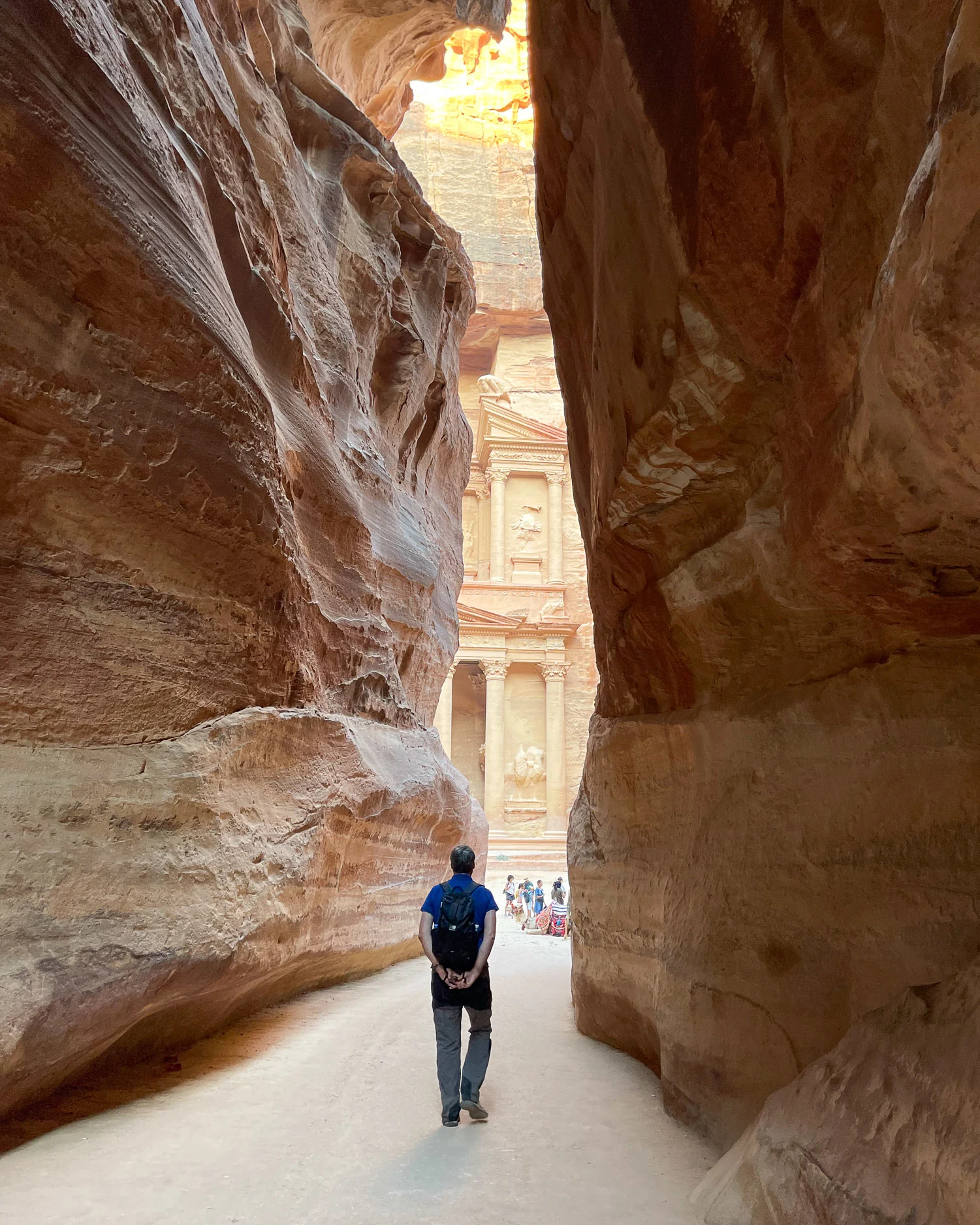
Day 1 – Morning
- Walk from the Visitor Centre along the trail, through the Siq and arrive at The Treasury
- Pause at the Treasury to take photos and enjoy the view
- Turn right along the valley floor until you reach the turning for the High Place of Sacrifice
- Climb the trail to the High Place of Sacrifice and take in the views, return by the same route
- Walk through the Petra’s ancient “city centre” area without spending too much time to look at the ancient ruins and take lunch around the Basin area
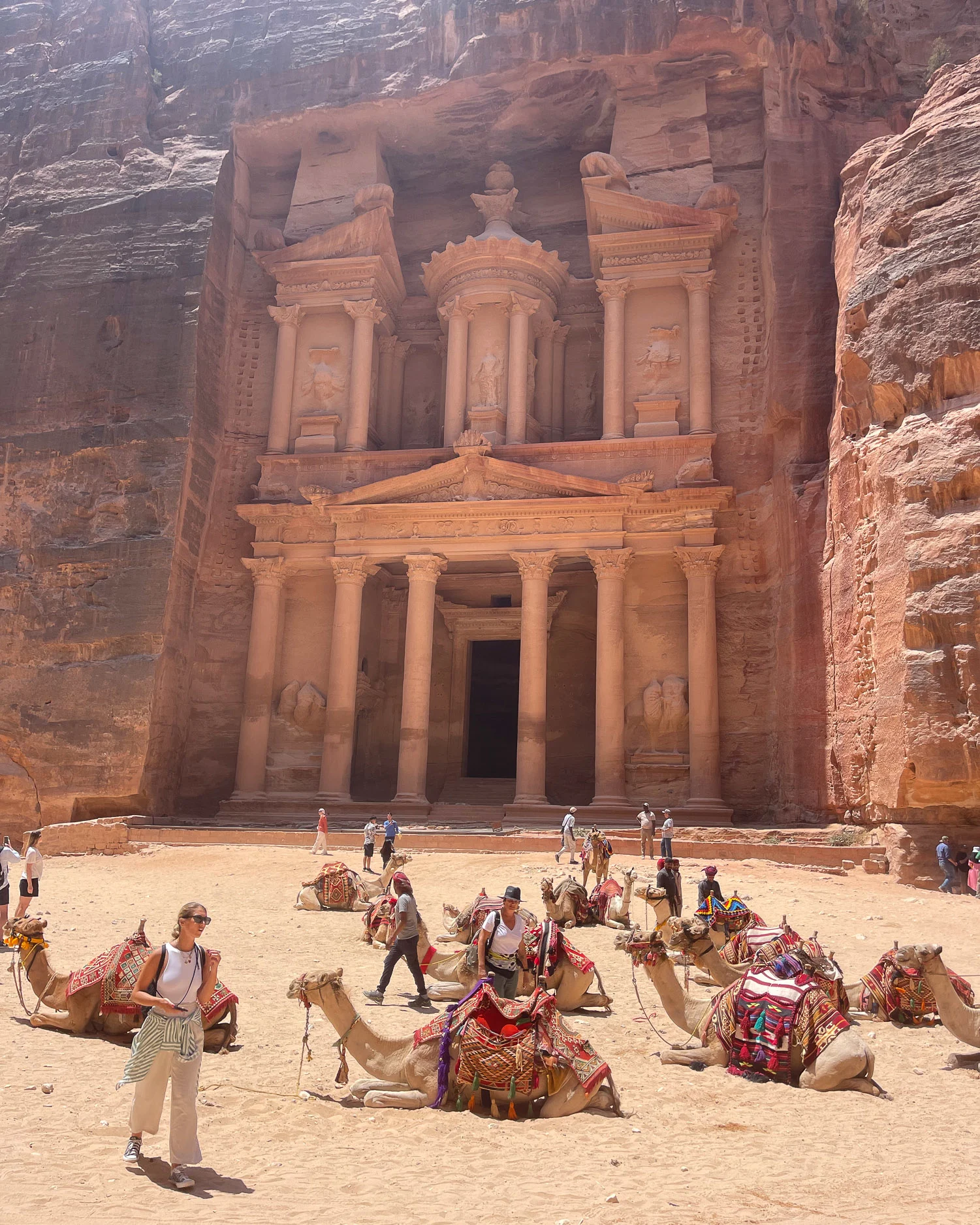
Day 1 – Afternoon
- After lunch and a rest, tackle the 800 steps up to the Monastery, enjoying the views on the way up
- Look around the Monastery and take photos from some of the viewpoints up the hill
- Return down the 800 steps to the Basin area and after a rest continue back up the valley towards the Royal Tombs
- If time permits, take a look at the ruins of the Great Temple, Qasr al-Bint and Colonnaded street, as you pass by.
- Finish your day exploring the Royal Tombs.
- Allow at least an hour to walk back to the visitor centre via the Treasury and Siq before it closes (6pm in summer, 4pm in winter).
A 2 day itinerary for Petra
On Day 1 you’ll see the main sites in the traditional order, starting with the Siq and Treasury. Day 2 will bring you into Petra by the “back door”, so you’ll enter the site from the opposite end and work your way back to the Treasury.
Day 1
Day 1 – Morning
- Walk from the Visitor Centre along the trail, through the Siq and arrive at The Treasury. (1 hour)
- Pause at the Treasury to take photos and enjoy the view. (1 hour) You can also walk up from here to a Treasury viewpoint on the cliff face opposite, but you may need to pay one of the local Bedouin to show you the way. (1 hour)
- Turn right along the valley floor until you reach the turning for the High Place of Sacrifice. (15 minutes)
- Climb the trail to the High Place of Sacrifice and take in the views, return by the same route. (1.5 hours)
- Take a look at the Street of Facades and Theatre as you pass by. (30 minutes)
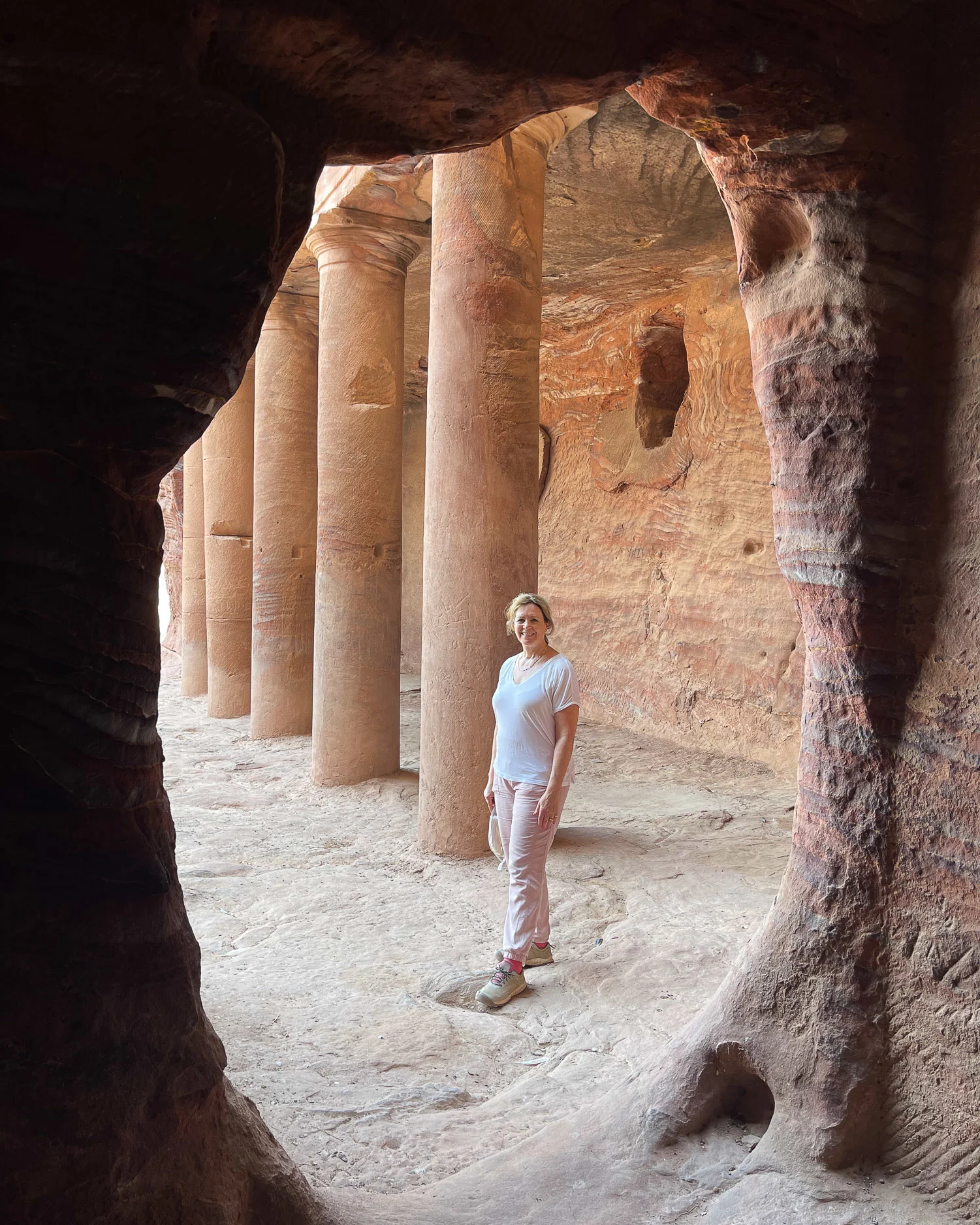
Day 1 – Afternoon
- Explore the Royal Tombs. This would be a good place to find a shady spot for a picnic and rest. (1 hour)
- If you still have time, you can walk through the Petra Old City area taking a look at the ruins of the Great Temple, Qasr al-Bint and Colonnaded street, as you pass by. Alternatively, as you’ll visit these tomorrow, you can return to the Treasury.
- If you walk down to the Basin area, there are carriage rides, camels and horses available for hire near the Basin Restaurant. You can hire one of these, to give you a ride back to the Treasury.
- From the Treasury, walk through the Siq and back along the trail to the visitor centre. There are horse rides available at the end of the Siq to take you back to the Visitor Centre if you’re too tired. (1 hour)
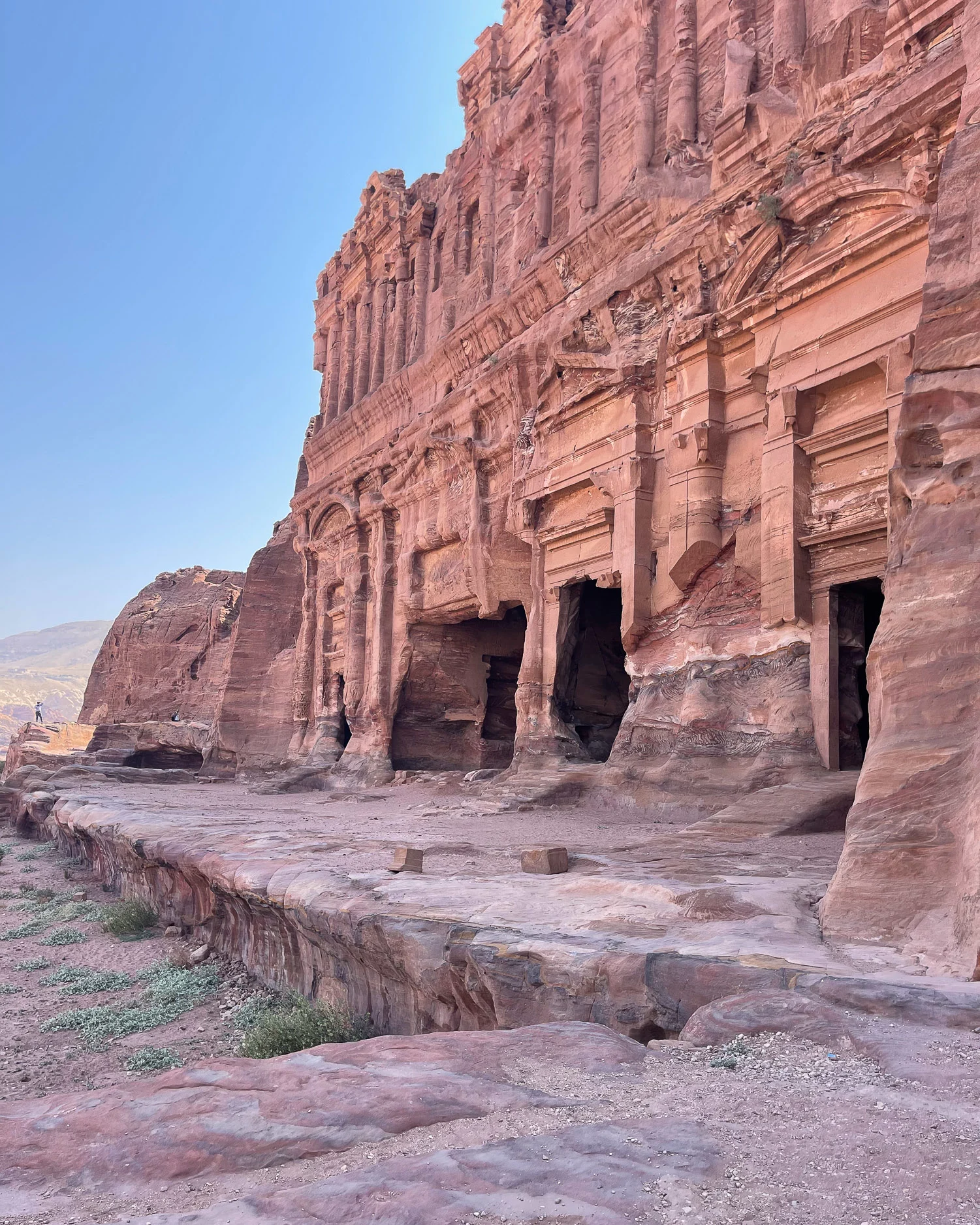
Day 2
On your second day, you’ll visit Little Petra, then enter Petra by the “Back door”. Check at the Visitor Centre the day before that this route is open and ensure you have a 2 day ticket for Petra, as tickets are not available at Little Petra.
Day 2 – Morning
- Take the first minibus shuttle at 7.30am (free) to Little Petra, from the back of the Petra Visitor Centre. (20 mins drive)
- Explore Little Petra (1 hour)
- Take the next 4 wheel drive shuttle from Little Petra to the start of the Monastery hike (Costs 5JD cash paid to driver). (20 mins drive)
- From where the 4 wheel drive vehicle drops you, follow the hiking trail up to the Monastery ( 1 hour)
- Look around the Monastery and take photos from some of the viewpoints up the hill. This is a good place to stop for a picnic (1 hour)
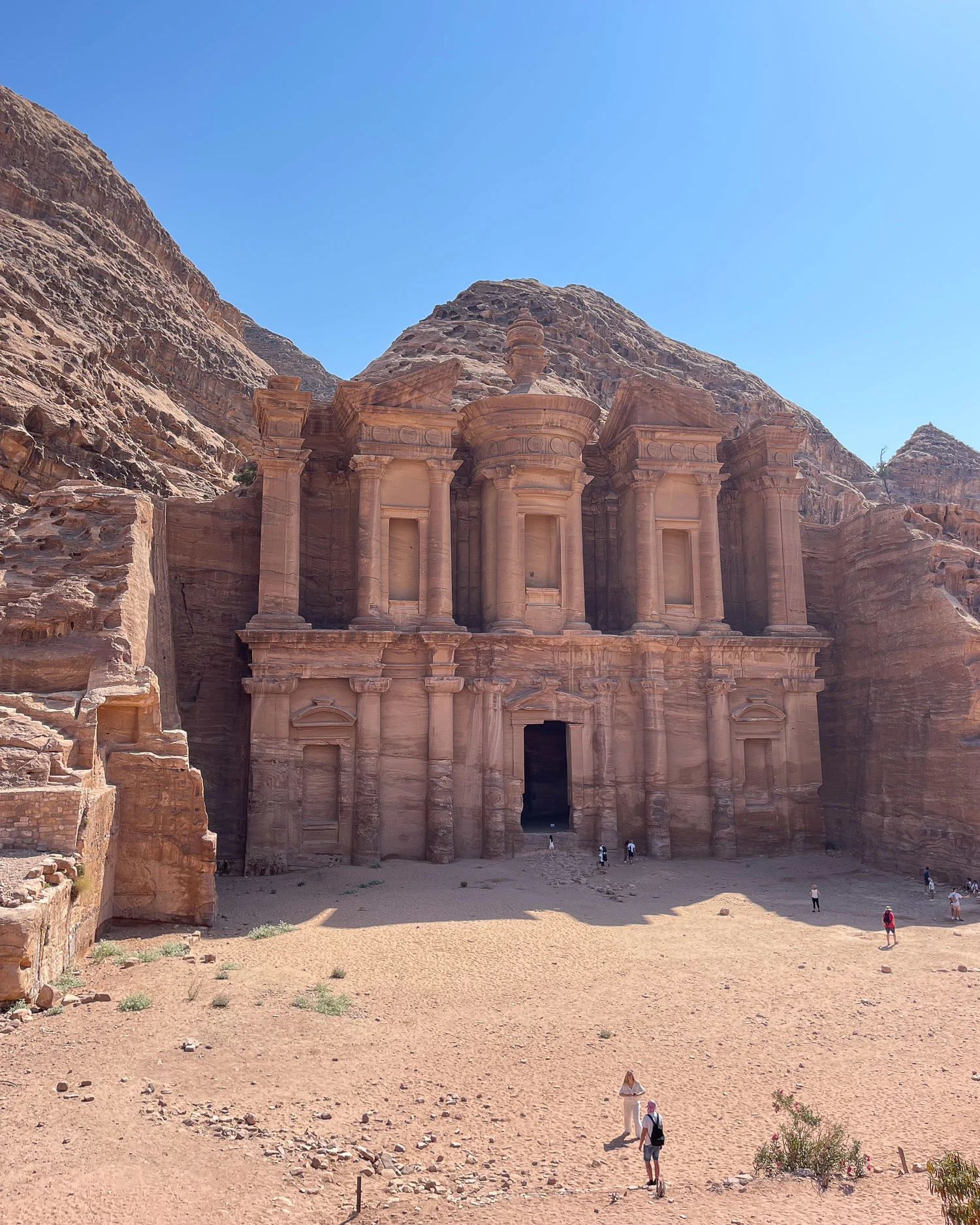
Day 2 – Afternoon
- From the Monastery climb down the 800 steps to the Basin area and take some refreshments at one of the two restaurants. (1 hour)
- In the afternoon, make your way through the Petra Old City area taking a look at the ruins of the Great Temple, Qasr al-Bint and Colonnaded street. Continue past the Street of Facades and Theatre. (1.5 hours)
- From here, allow at least an hour to walk back to the visitor centre via the Treasury and Siq. (1 hour)
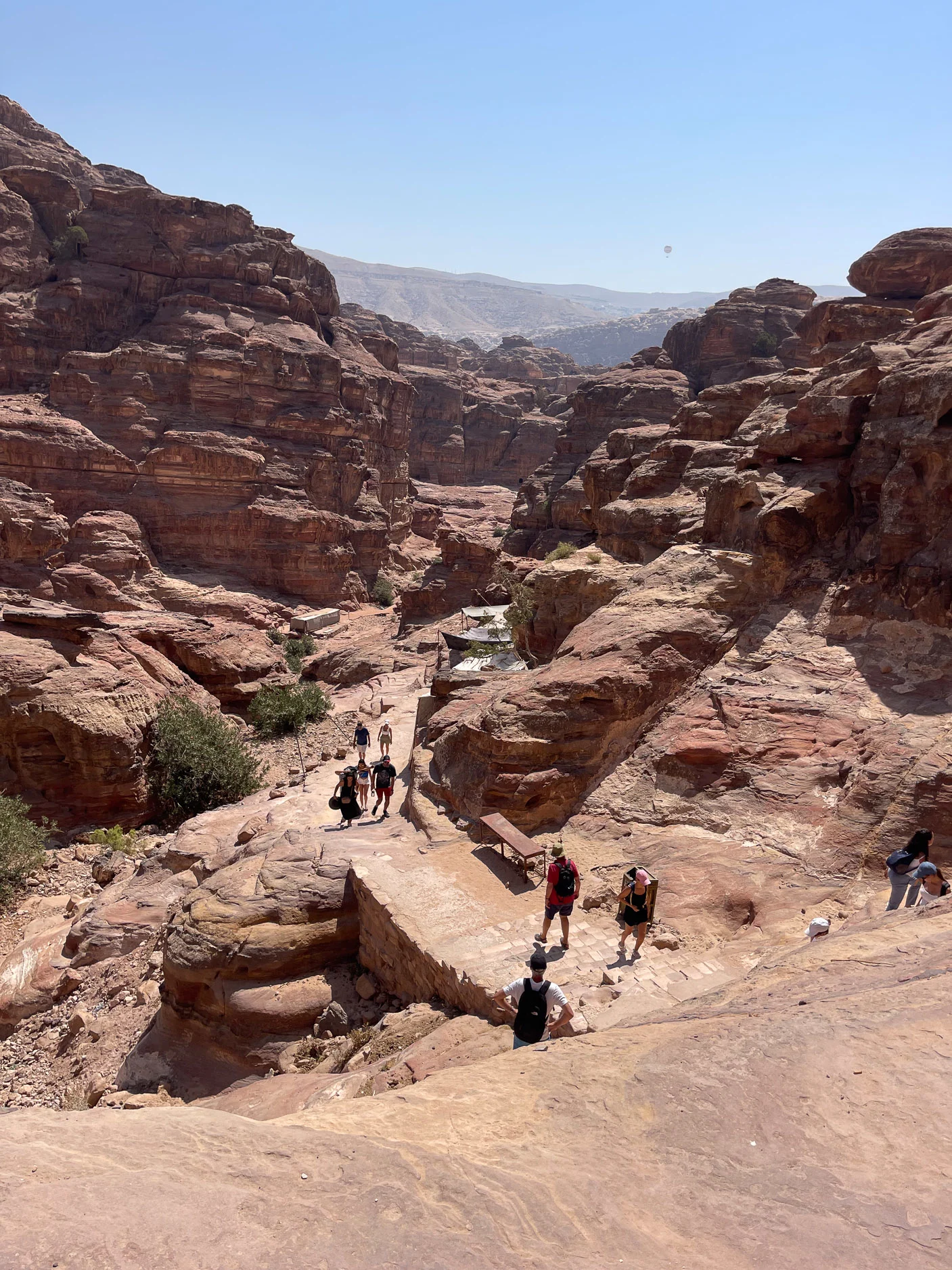
What to do on Day 3 in Petra
If you have a third day to explore Petra, there are several interesting hikes you can make, to explore the less visited parts of the site. As an example you could:
- Climb up to the High Place of Sacrifice, but instead of returning by the same route, continue along the Wadi Al Farasa trail bring you back to the Basin area.
- Climb up behind the Royal Tombs on the Al-Khubtha trail to take you up to the highest viewpoint for the Treasury.
- Engage a guide to take you on the Jabal Haround Trail or Wadi Sabra Trail (see our later section on hiking trails in Petra)
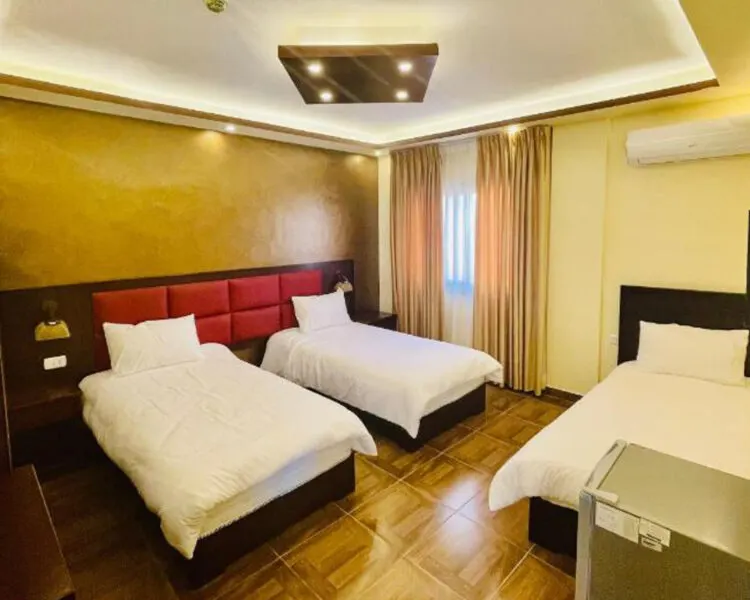
Esperanza Petra – A good budget hotel with rooftop restaurant in the lower town of Wadi Musa (we stayed here)
Group Tours to Petra
If your whole holiday has been arranged as part of a tour, then transport will be taken care of. But if you arrive in Jordan as an independent traveller with no fixed plan, you can still take a group tour like the ones below.
3 day tour of Jordan from Amman – This tour includes an overnight stay and visit to Petra. The second night is spent in a desert camp at Wadi Rum, with a visit to the Dead Sea on the way back to Amman.
2 day tour of Jordan from Amman – This tour includes half a day visiting Petra, with an overnight stay and visit Wadi Rum and a quick stop at the Dead Sea.
Petra full day tour from Amman – For those with very limited time, this day trip from Amman is a good option, although bear in mind the drive is 2.5 -3 hours each way, so this will be a long day.
Petra full day tour from Aqaba – This day trip from the Red Sea resort of Aqaba allows for a 3 hour tour of Petra, so you’ll only get to see a few highlights.
Most tours start in Amman and take in Petra, Wadi Rum and the Dead Sea over the 2-3 day period. This could be a good option for solo travellers, but bear in mind you may only get half a day to see Petra.
Top things to see in Petra – more detail
Here’s a bit more information about all the things to do in Petra, listed in the order that you’ll typically encounter them.
1. The Petra Visitor Centre
The Petra Visitor Centre is the point of entry to the Petra archaeological site, located in the town of Wadi Musa that serves Petra. Around its courtyard are several souvenir shops and cafes, with toilets, an ATM outside and the bus station and free car parks nearby.
This is where you’ll find the Petra ticket office, to buy your ticket or exchange your Jordan Pass for a ticket. In the same hall as the ticket counters is a booth, where you can engage one of the official guides at set rates that are posted on the wall.
Also within the Visitor Centre is a counter for sale of Petra by Night ticket, but these only go on sale a few hours before the event itself.
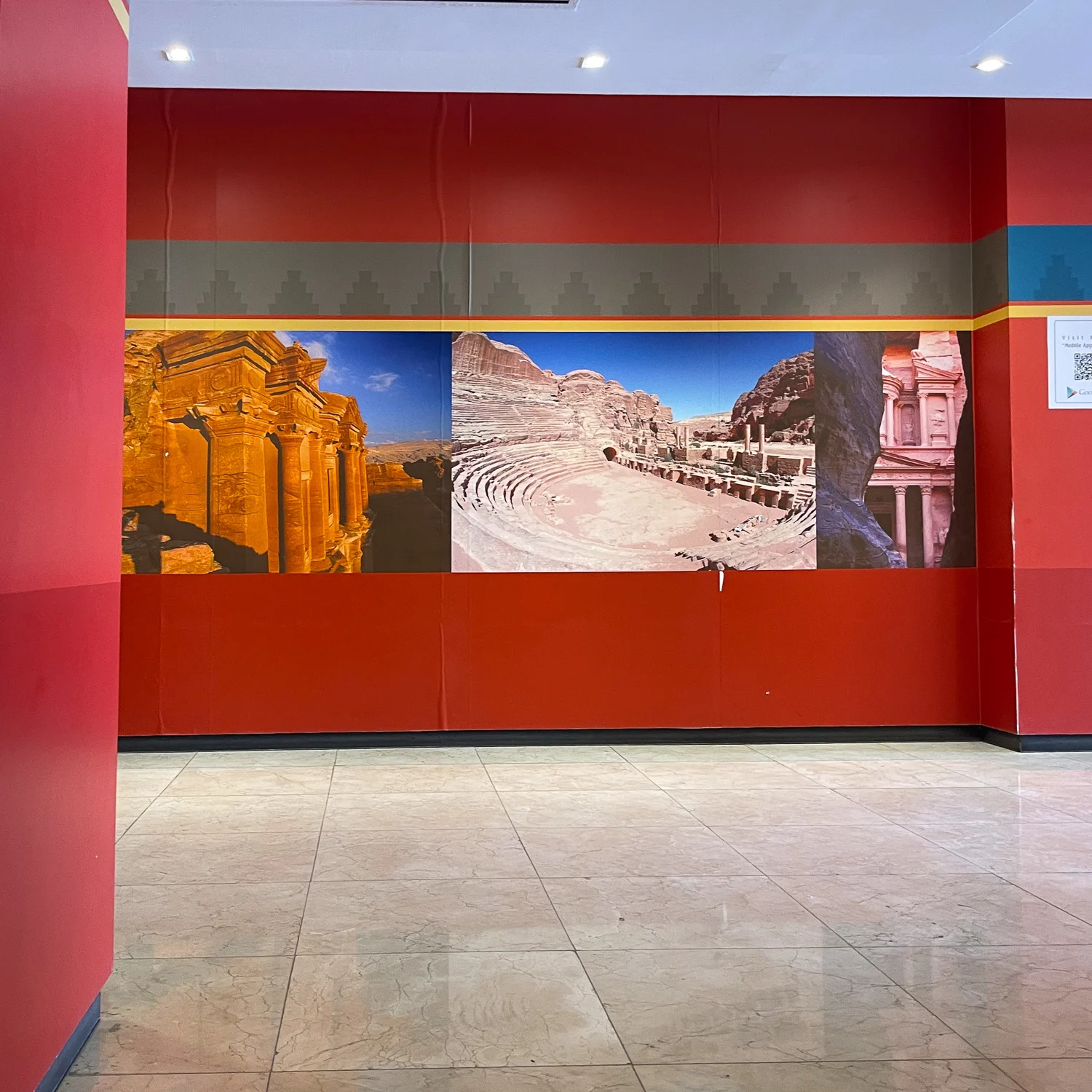
At the back of the visitor centre is an information counter and exhibition hall which gives background about the history of Petra. This is a useful place to stop on the way out, if you don’t have time to visit the Petra Museum, which is right by the Visitor Centre and also free.
For more tips and advice to help you plan your visit, such as when to go, ticket prices, weather, avoiding scams, what to wear, read our other article about Visiting Petra in Jordan – the ultimate travel guide
After leaving the visitor centre, your ticket will be checked as you enter the Petra archaeological site, then you have a 20 minute slightly downhill walk to the start of Al-Siq, the famous gorge that leads you into Petra.
2. The Siq
After walking 15 minutes from the visitor centre, you’ll enter the Siq, a narrow gorge leads the traveller into Petra. The 1.2 km gorge was created by a natural split in the rocks and you can observe the layers of coloured stone on both sides of the 200 metre high walls.
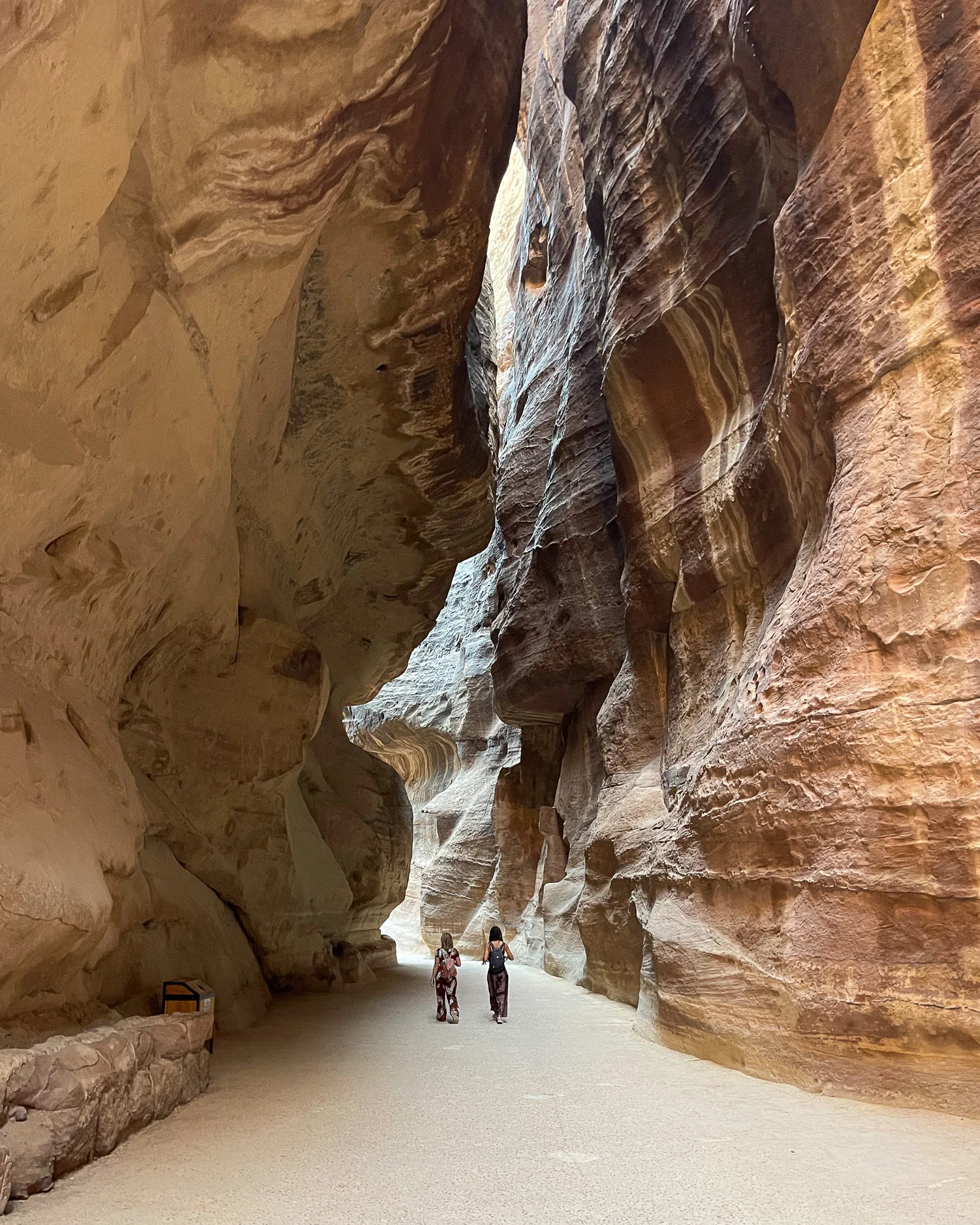
The gorge is still partly paved with stones laid down by the Romans, so you can really feel the layers of history here. On your walk through, look out for carved niches and the water channels that the Nabataeans used to bring water into the ancient city.
3. The Treasury (Al Khazna)
At the end of the Siq, arrive at the Treasury, easily the best known view of Petra. This 20 metre high monument, carved into the face of the cliff, reveals itself as you emerge from the Siq into an open area where camels await for a photo opportunity.
The tomb’s carvings include Corinthian columns influenced by those of Ancient Greece, with friezes and a central urn at the top. The small rooms behind the facade were made as the tomb for one of the Nabataean kings in the 1st century, although you can’t go inside. The name derives from the legend that treasure was once concealed in some part of the building, perhaps the urn at the top.
The best time to photograph the Treasury is between 9am and 11am when the sun lights up the facade. In front of the monument you may be approached by local Bedouin who will offer to take you up to a much photographed viewpoint that can be accessed from this area.
Camels are also available, either for a short ride or a photo in front of the Treasury. Of course payment is expected for these services, so be sure the amount is agreed before you accept.
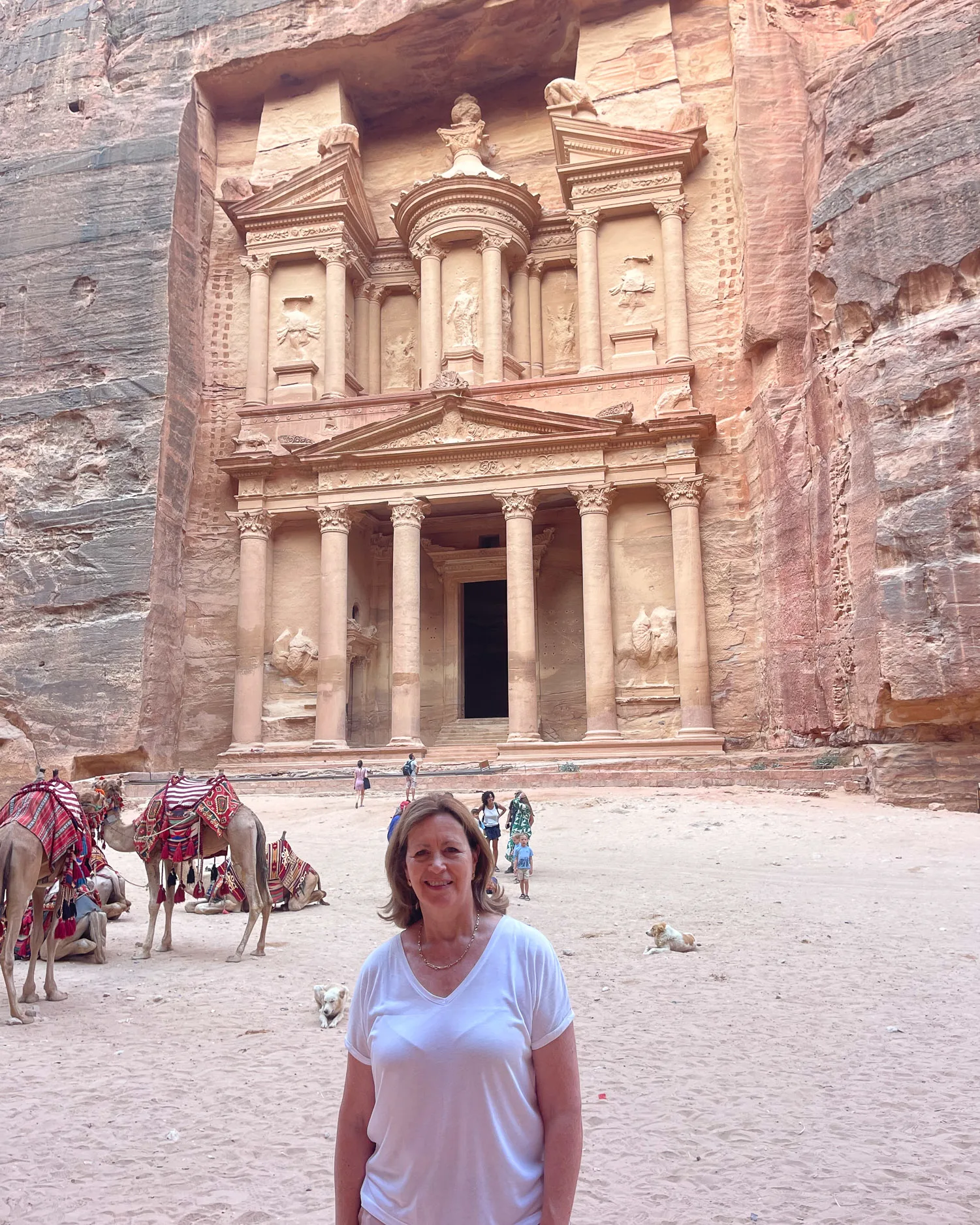
4. The Treasury Viewpoint
I’ve already mentioned that you can access the lower of the two viewpoints, from paths that start in front of the Treasury. If you are facing the Treasury, you’ll see steep steps leading up to the left and these will bring you around to a viewpoint.
Because of the clambering involved and some steep drops, you do need a Bedouin guide to take you, but be sure to agree the price before you start. We didn’t go to this viewpoint ourselves but read it takes around 30 minutes to get there.
There is a second longer and more arduous path, that brings you from the Royal Tombs to a higher viewpoint (which is the one we tried). This is the Al-Khubtha Trail and you don’t need a guide to get there.
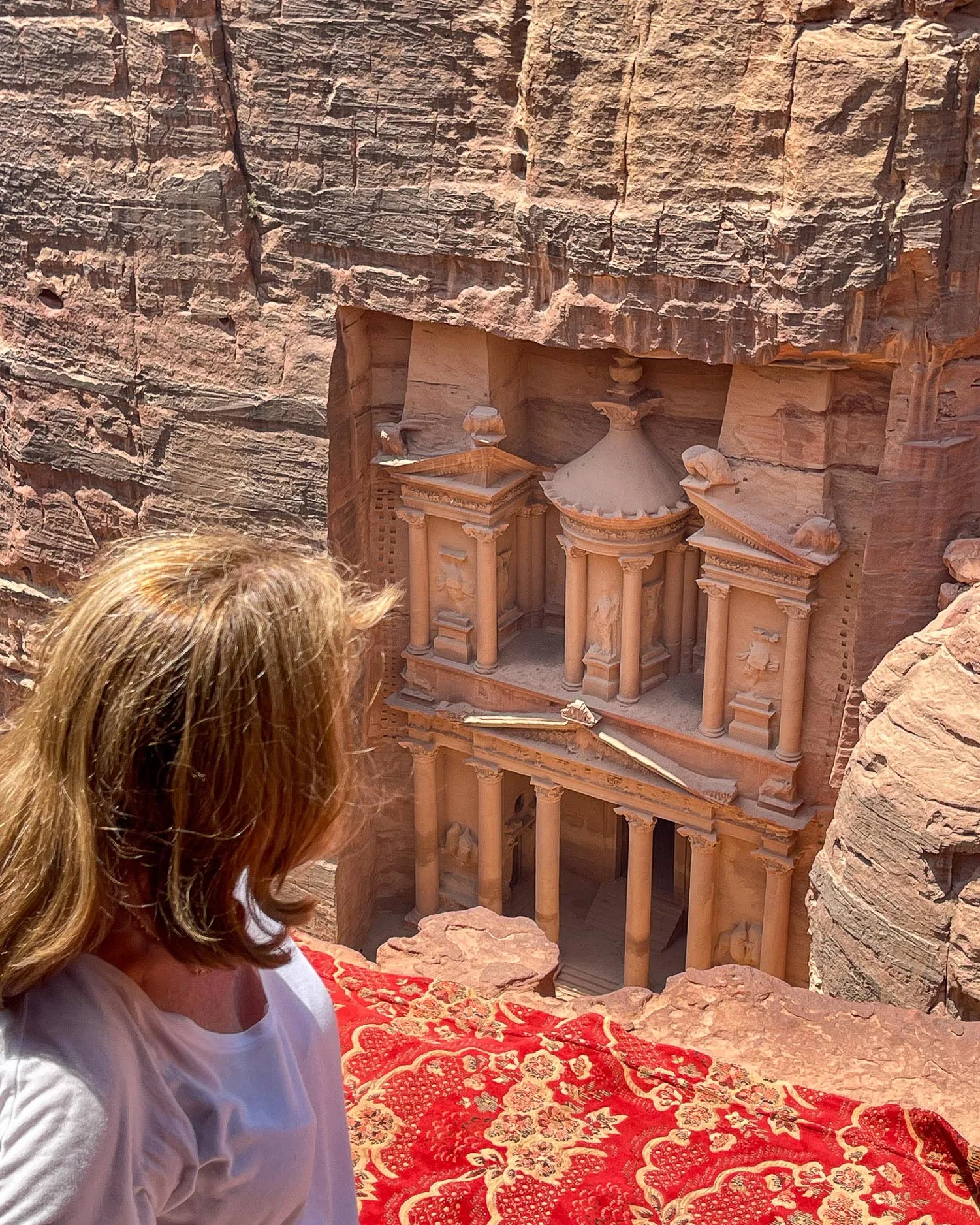
To the left of the Royals Tombs as you face them is the start of a trail which takes you on stone steps up to a viewpoint looking down on the Theatre. After a further scramble downhill to a Bedouin tent on the cliff edge, you get a view over the Treasury. Be warned it’s an arduous trail that takes 2-3 hours round trip.
You can read more about the Al Khubtha Trail later in the article in my section on hiking trails.

Need help to design your dream holiday? We’ve partnered with UK travel advisor Luxeco Holidays to create your personalised itinerary
5. High Place of Sacrifice
After the Treasury, the gorge widens out and the path takes you gently downhill to the turning for the High Place of Sacrifice. At this point, stone steps take you upwards along the side of a smaller gorge, initially offering some lovely views of the Street of Facades.
After around 40 minutes you’ll reach a cluster of Bedouin stalls. If you fork right here, the path brings you to a plateau with amazing views of the ancient city below.
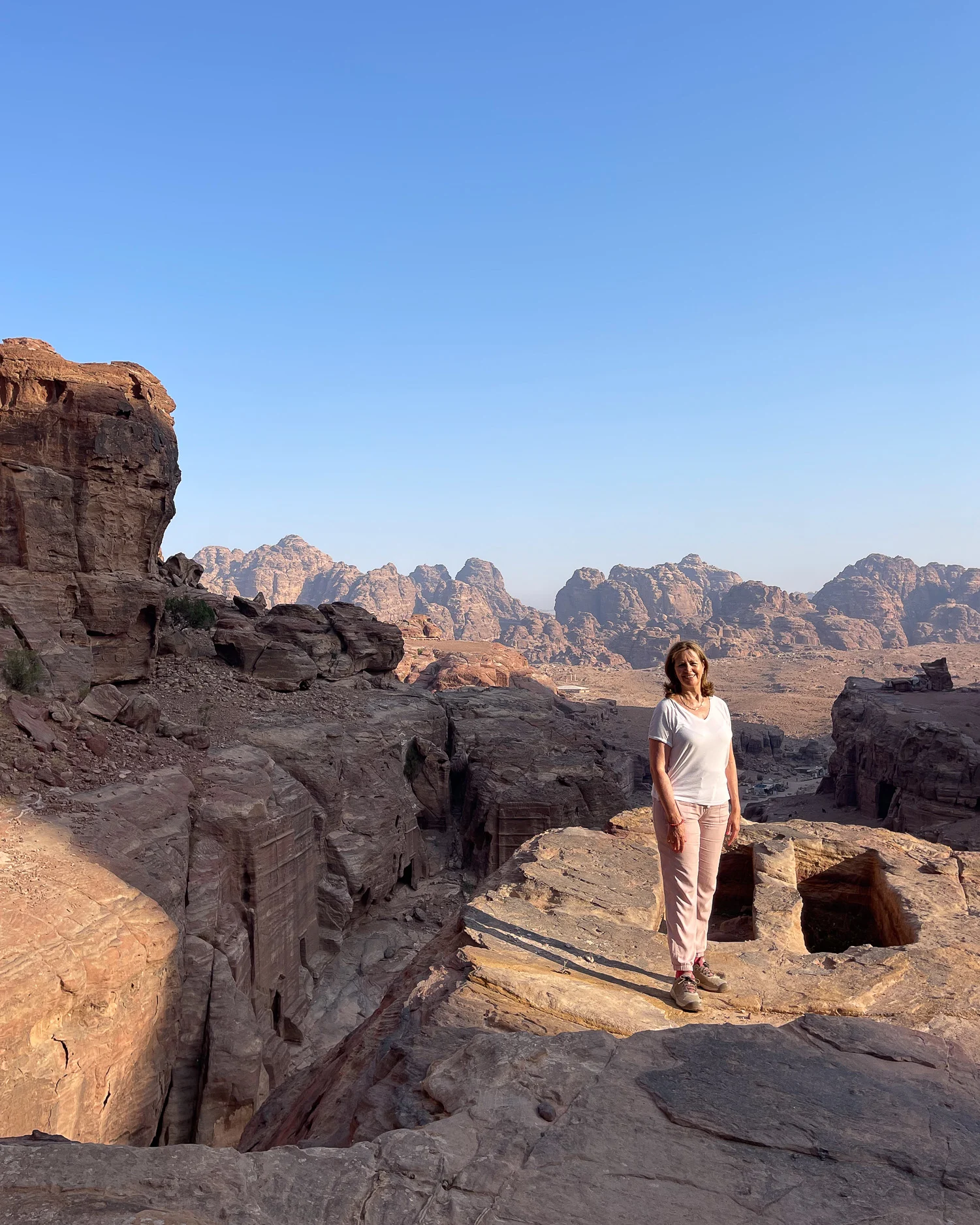
At the highest point, marked by a flag, is a rock altar that was used for religious ceremonies and sacrifice. To be honest we completely missed walking up to this highest point, but it was still a wonderful walk with amazing views from the top.
Read more about this walk later in the article, in my section about hiking trails at Petra.
6. Street of Facades
Just past the turning for the High Place of Sacrifice, are the row of around 40 Nabataean tombs, known as the Street of Facades. Although you could probably explore inside these tombs, they are all empty and some seemed to be used by the local Bedouin, who keep their animals nearby.
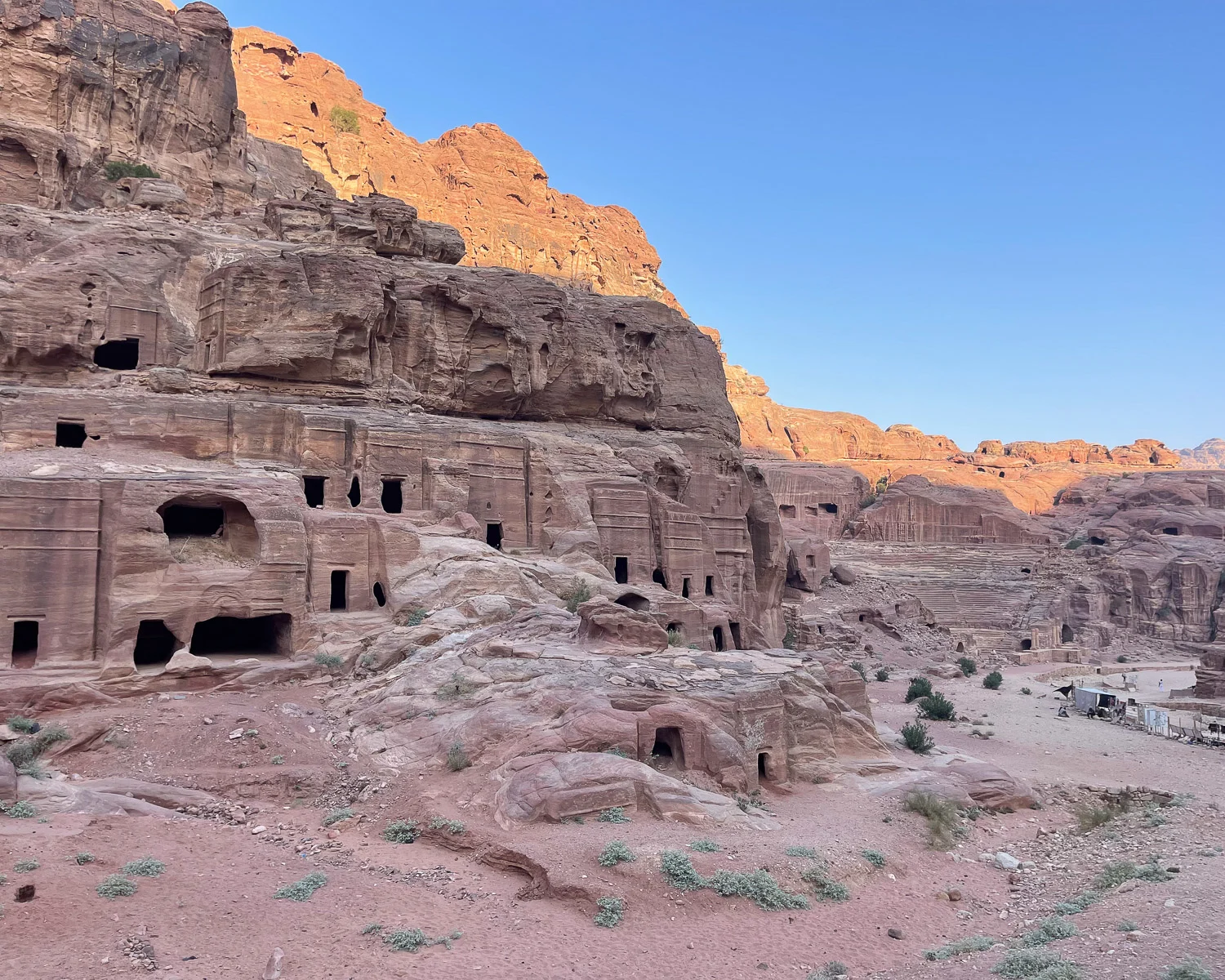
7. The Theatre
As the valley opens up, your walk along the main trail brings you to the Theatre, which was carved directly into the rock by the Nabataeans and repurposed by the Romans.
At its peak, the theatre could hold up to 4000 spectators. Observe how the Romans added additional rows of seats at the top, cutting into the original Nabataean Tombs. The Romans also added the back wall of the stage, where you can stand and look into the Theatre, although you cannot climb on the rows of seats.
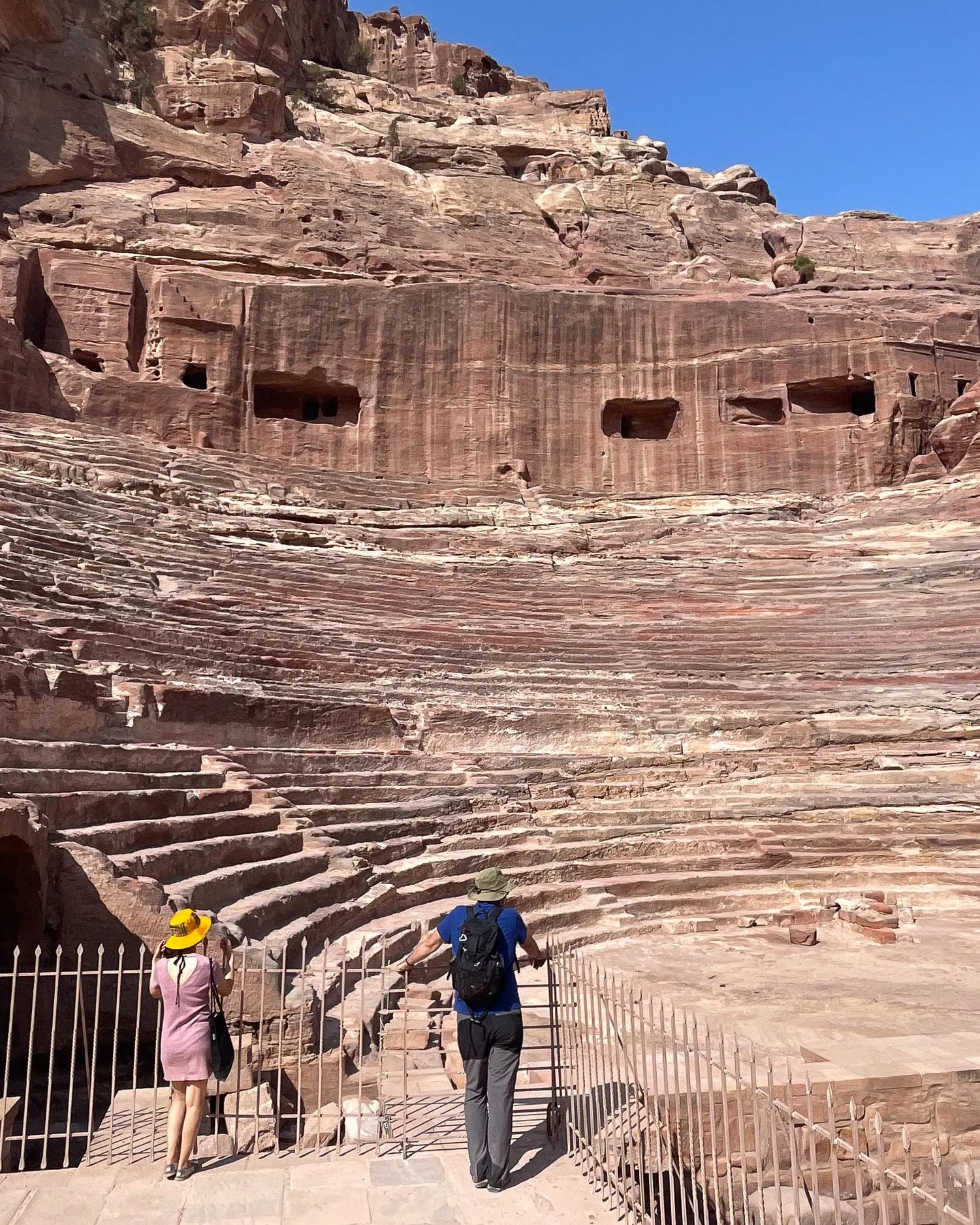
8. Royal Tombs
Carved into the cliff face are four major tombs, with large chambers that you can enter, although they are now empty. You’ll admire the intricate rock carving from the 1st and 2nd century AD and the swirling coloured layers of stone.
The large but now empty rooms behind the facade of the tombs, were used by the Nabataeans for funeral celebrations and memorial banquets to remember the dead.
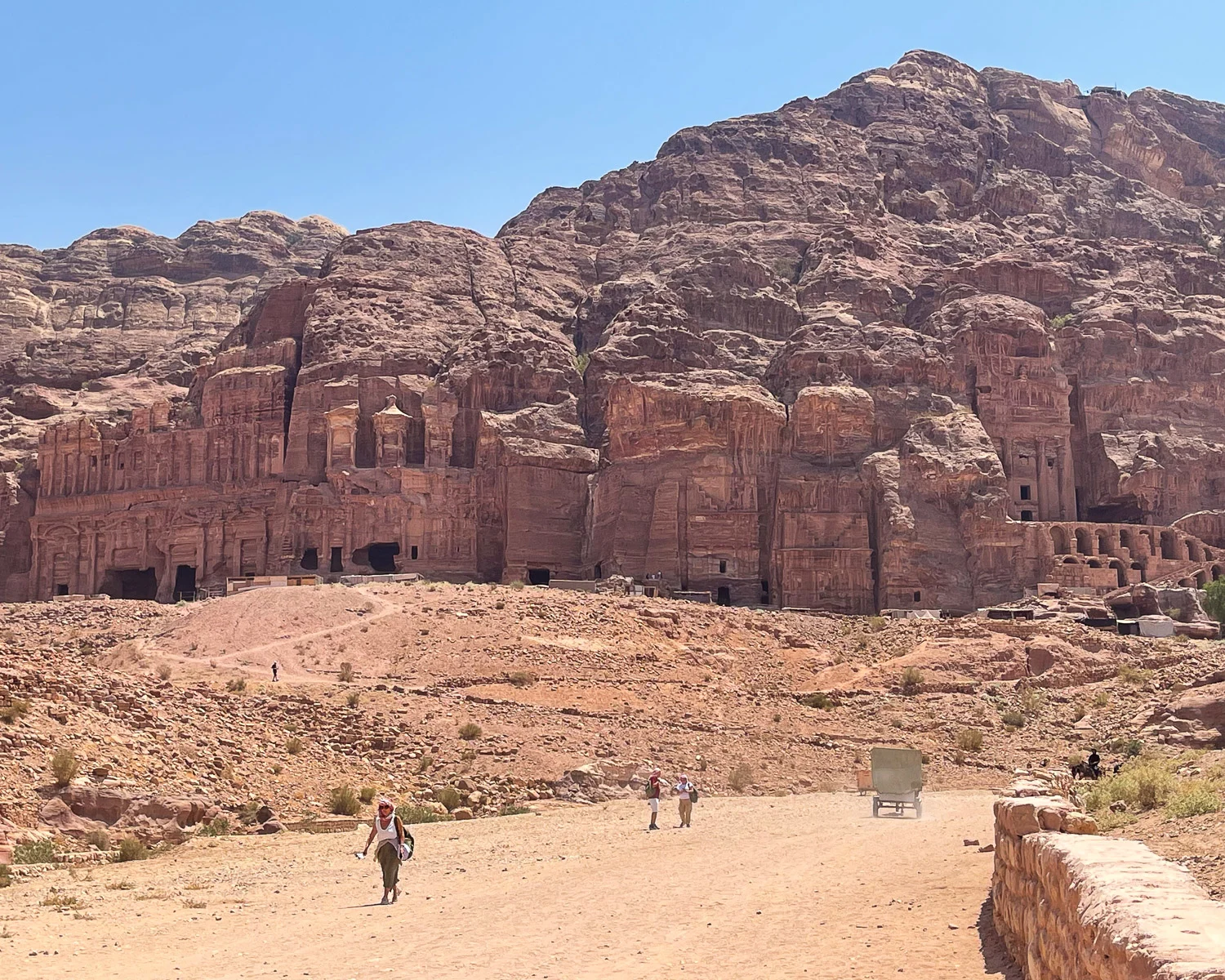
To explore the Royal Tombs close up, take the obvious path from the main trail and climb up the steps, with further steps in the rock at the front of each tomb. The Royal Tombs are best photographed in the late afternoon when the sun lights up the west facing facades. The main tombs are known as:
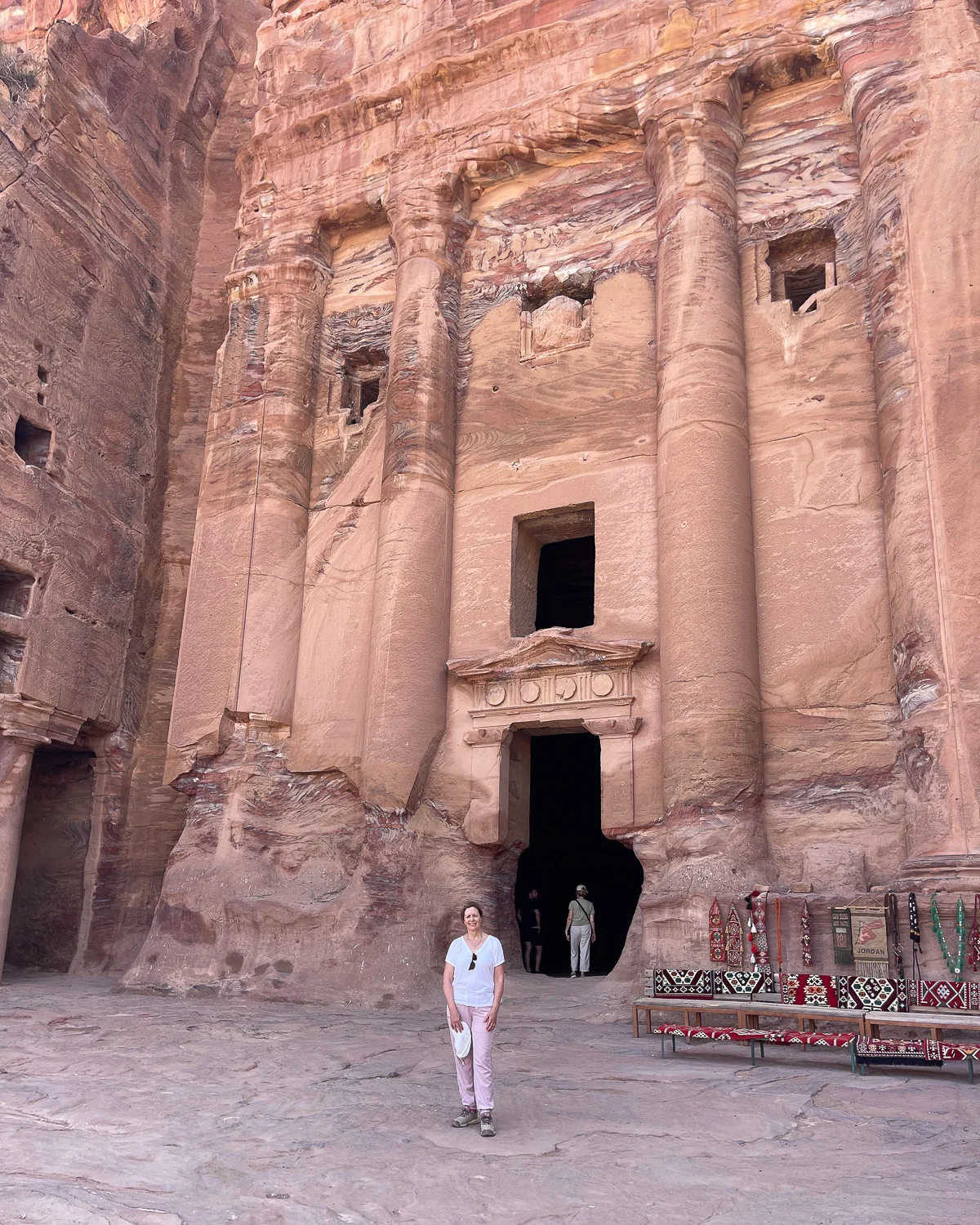
Urn Tomb – named for the urn at the top of the pediment, this tomb has an impressive facade. You can walk inside the tomb and there’s a large courtyard in front with a colonnade to the side. Above the entrance you’ll spot three smaller openings to additional burial chambers.
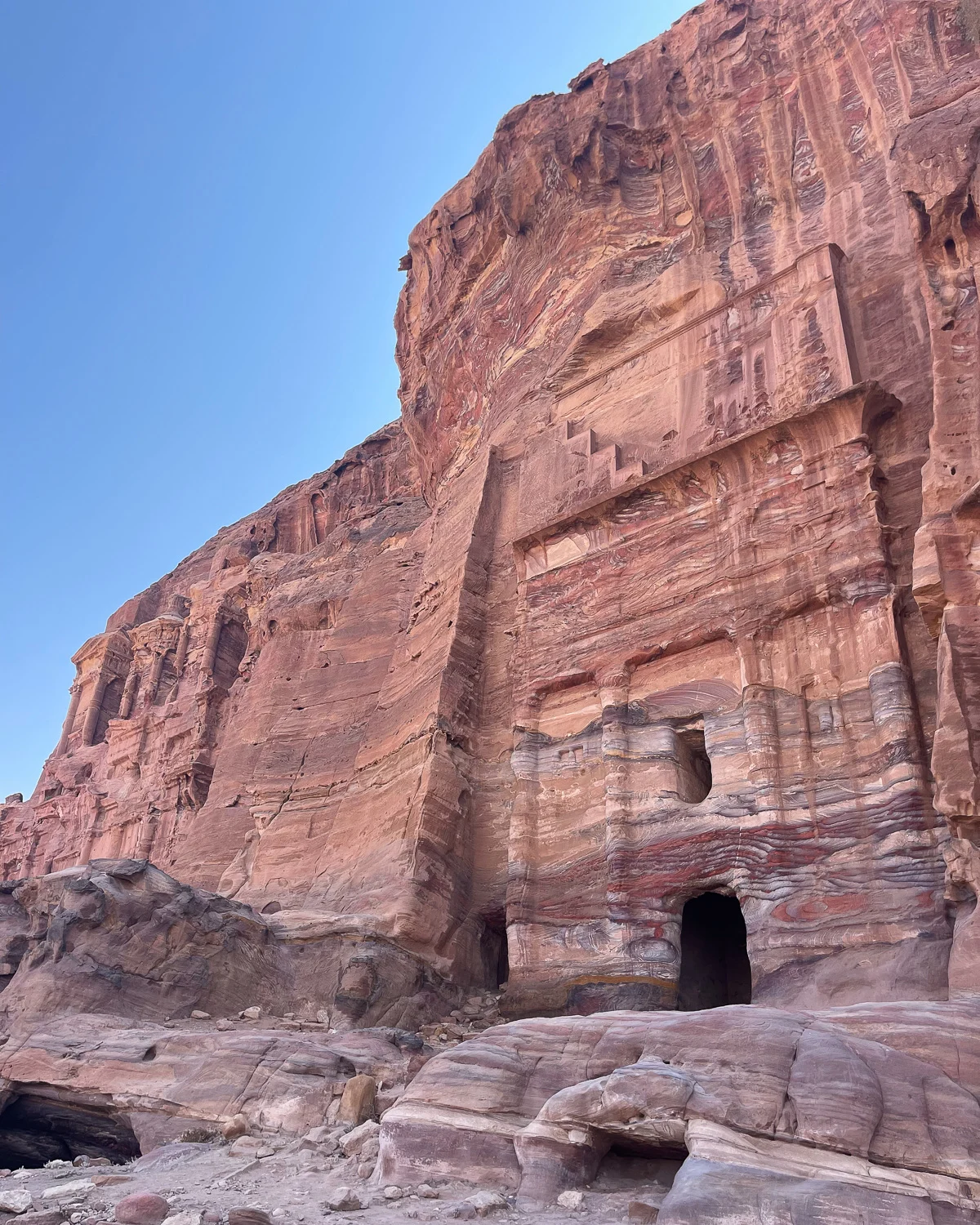
Silk Tomb – the face of this tomb is marked by beautiful swirls of coloured rock.
Corinthian tomb – One of the largest and most impressive tombs with a facade that’s similar to the Treasury, but much more eroded.
Palace Tomb – constructed in the 2nd century AD, the tomb has a grand 5 story facade.
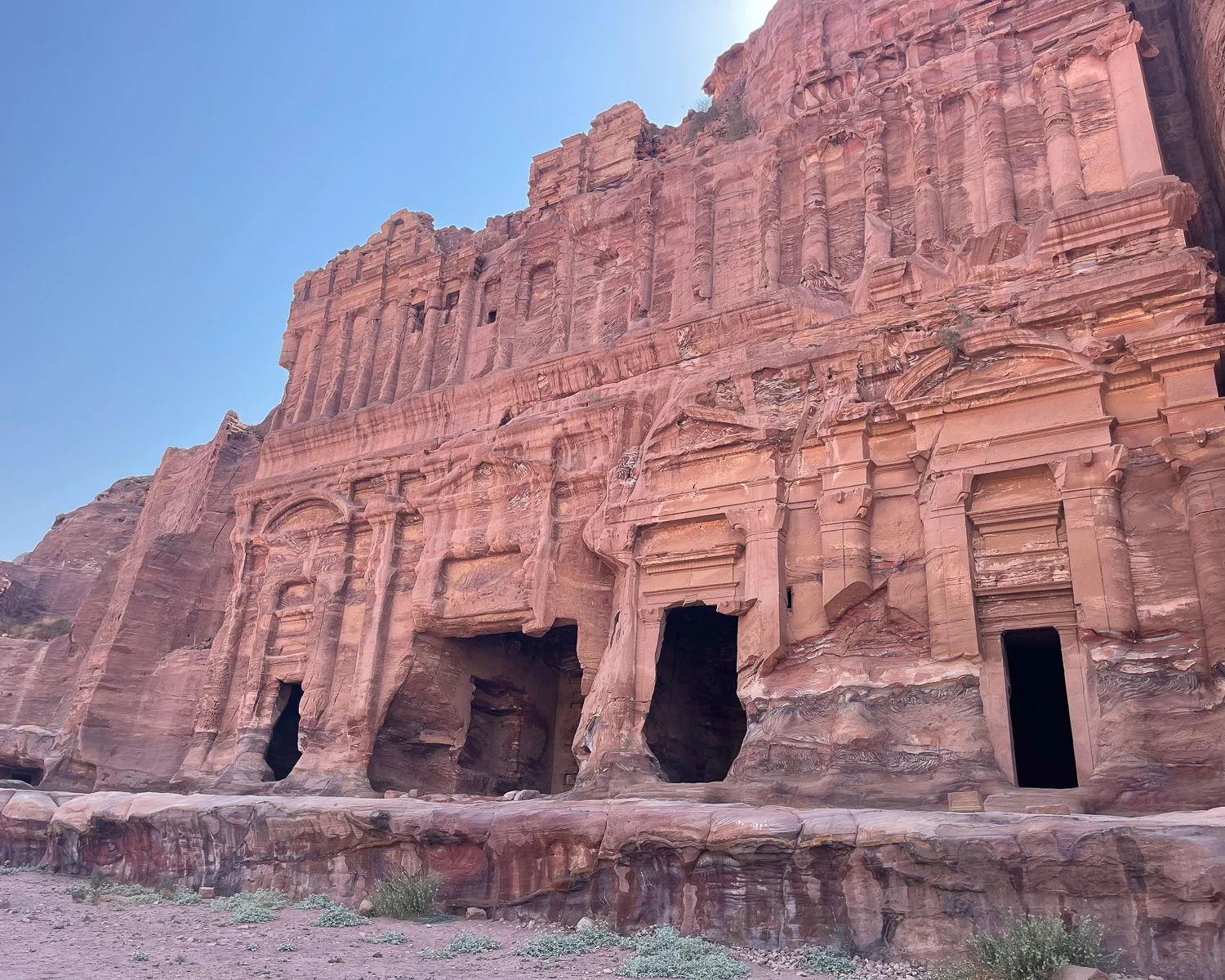
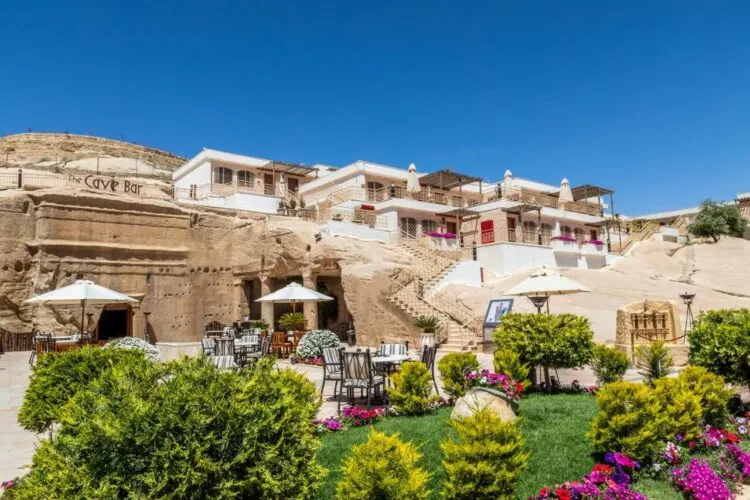
Petra Guest House Hotel – A mid range hotel with famous cave bar located next to the Petra Visitor Centre
9. The Colonnaded Street
This is the remains of a colonnade that was built by the Nabataeans as the city’s main shopping street and continued in use under Roman occupation. What remains today is just a row of columns, but if you look back up the valley, they make a nice photo with the view of the Royal Tombs in the distance.
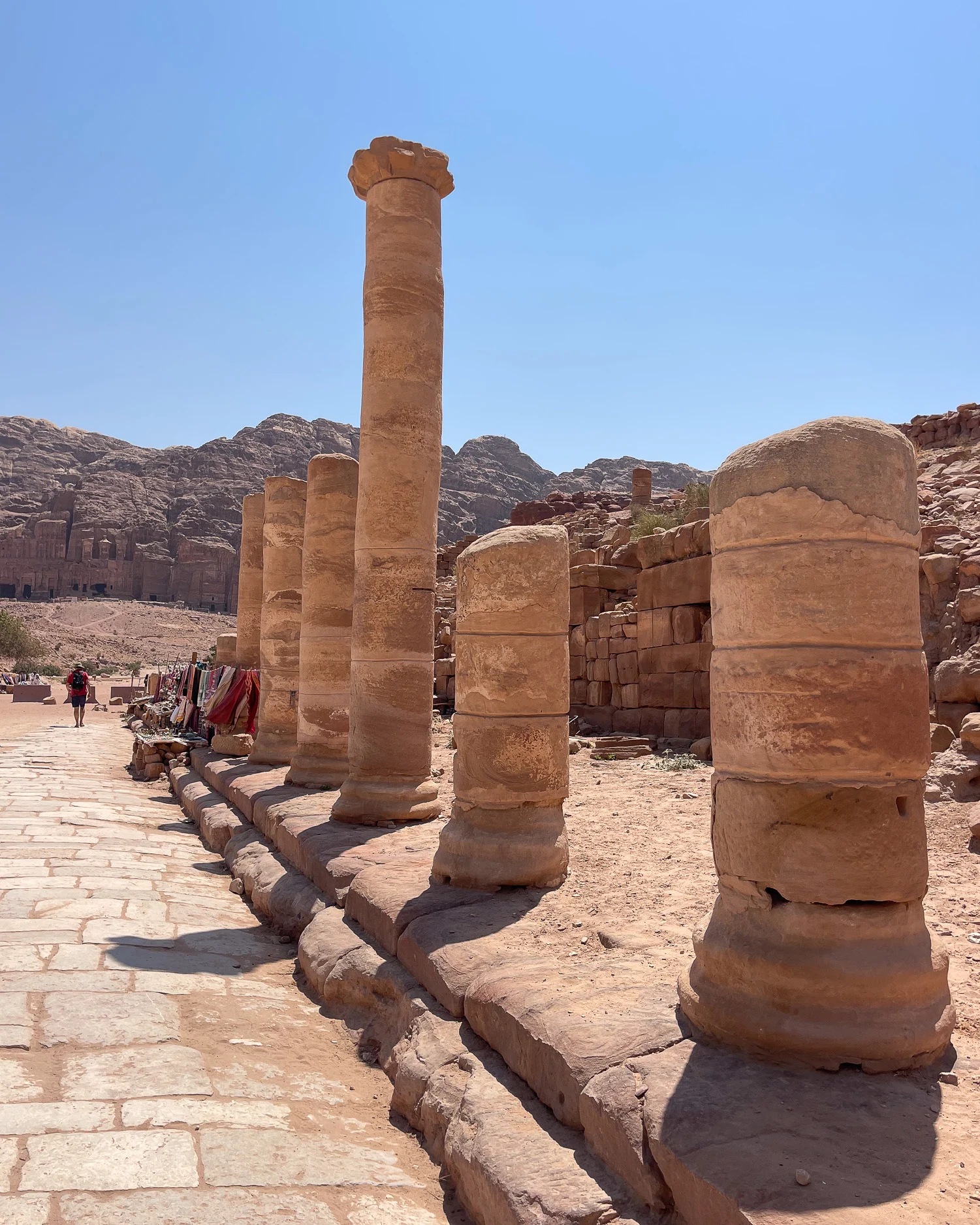
10. The Nymphaeum
This is a bit of a “blink and you’ll miss it” spot, just a few stone steps by a 450 year old pistachio tree, that offers about the only shade in this section of the site. You may find yourself resting under the tree, without even realising that this is all that remains of a semi-circular public fountain, that was fed from a water tank in the mountains.
11. Great Temple
The remains of the ancient temple complex with columns and remains of the stone walls, built in the 1st century BC by the Nabataeans. The temple was once 18 metres high, but was severely damaged in an earthquake although it continued in use by the Romans as a public space. You can walk up the steps of the temple ruins, for a better look at the entrance gateway and colonnades.
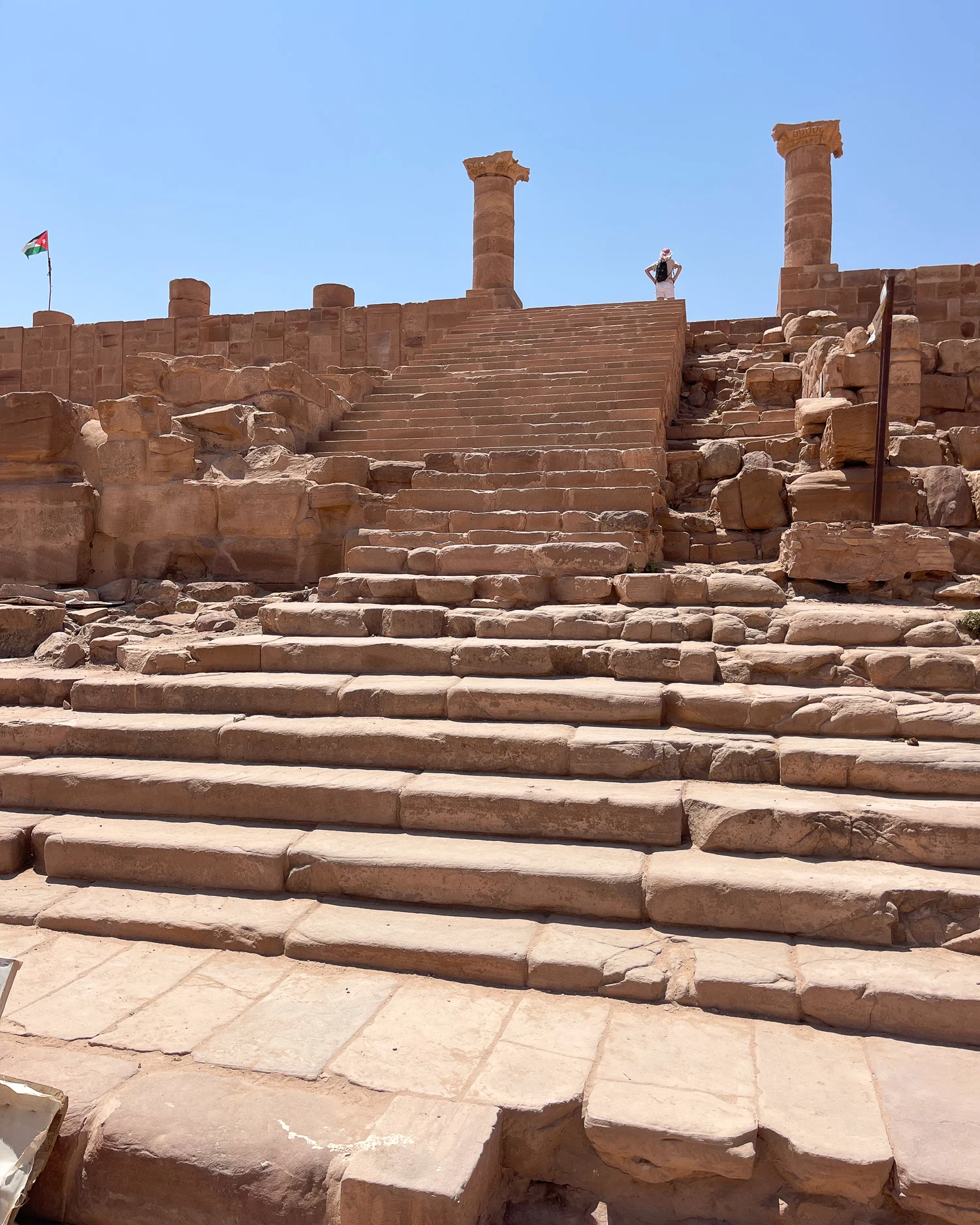
12. The Church
The remains of a Byzantine church from the 5th century AD, are set a little up the hillside from the valley floor, opposite the Great Temple. The remains are covered by a canvas roof, designed to protect the well preserved mosaic floor.
13. Qasr al-Bint
The remaining walls and columns of an important temple, with 23 metre high walls that hint of the impressive size of the buildings of the Nabataean 1st century city. Some of the stone reliefs from the temple are now preserved in the Petra Museum. Like other structures, you are not allowed to walk within the temple, but have to observe it from the valley level.
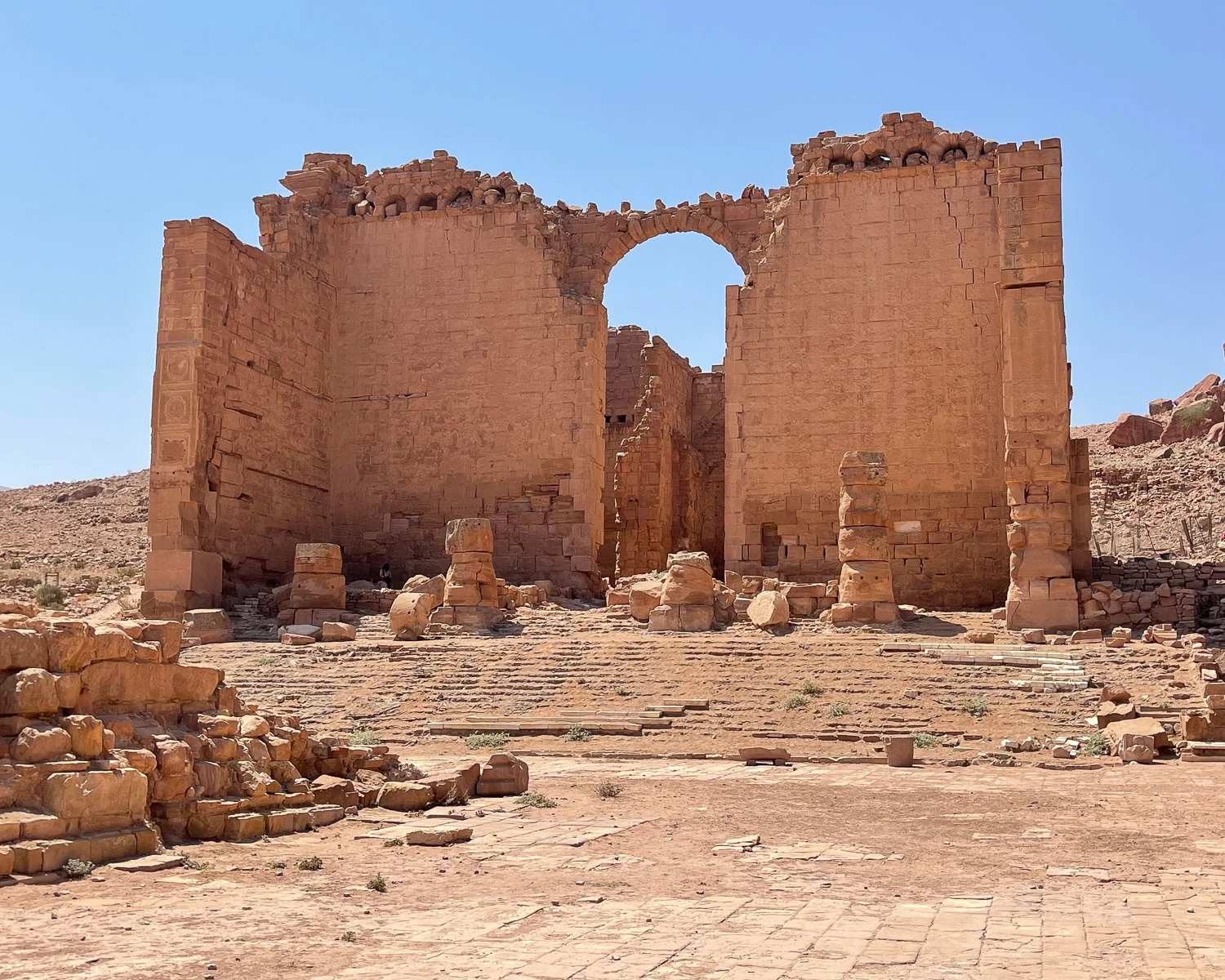
14. The Basin Area
At the end of the cluster of monuments in the “Petra City Centre” (The Great Temple, Colonnaded Street, Qasr al-Bint) you’ll arrive at the Basin area. This is not part of the archaeological remains, but a service area with two restaurants, The Nabataean Restaurant and Basin Restaurant. While you can buy drinks throughout Petra, these are the only two proper restaurants in the site that serve food.
Here you’ll also find public toilets and a cluster of animals that are for hire, either to take the weary traveller back to the Treasury, or to ascend the steep steps to the Monastery. If you plan to continue your visit with a climb up to the Monastery, this is a good place to stop, rest and refresh before you tackle the 800 steps and arduous hour’s climb ahead.
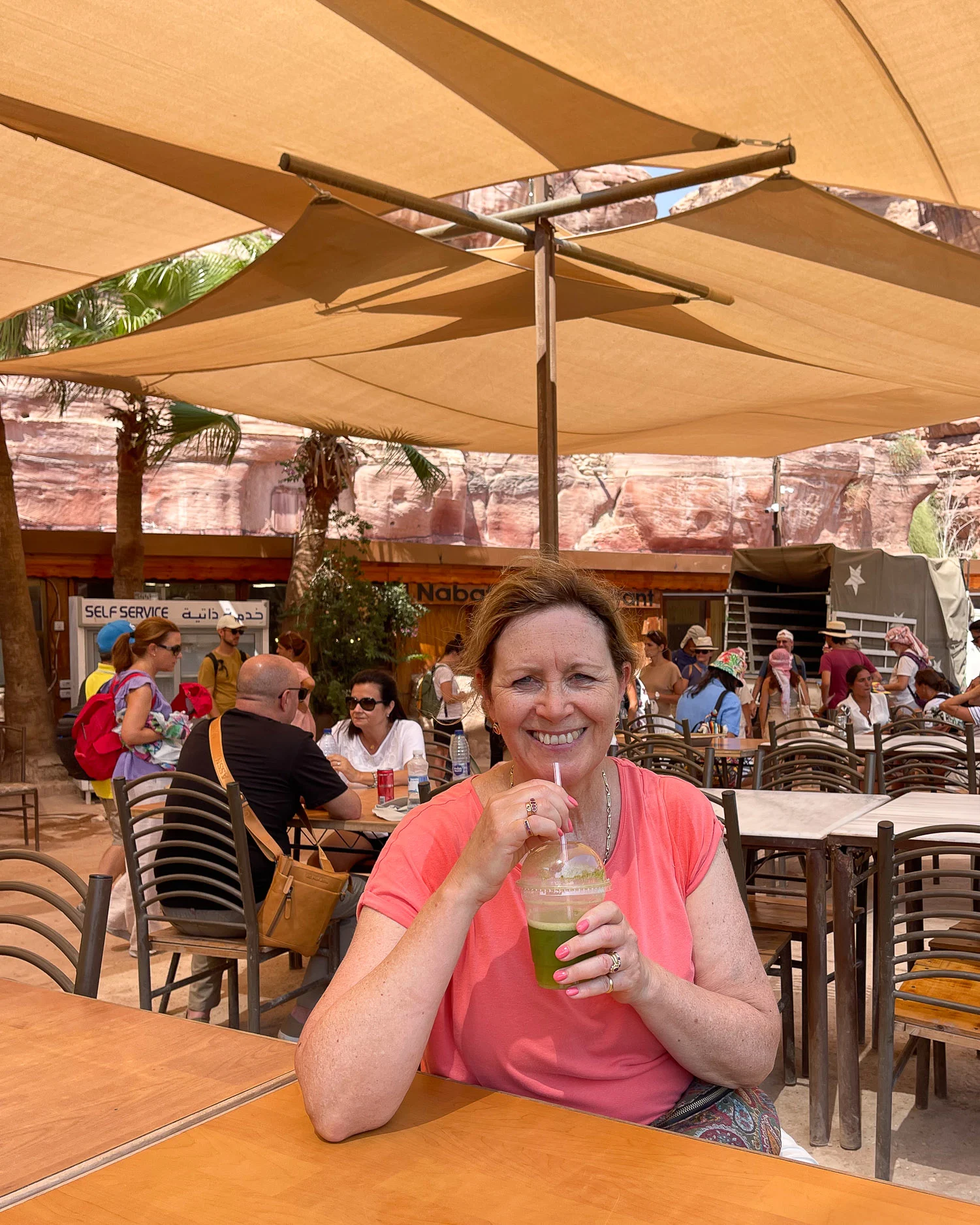
15. The Monastery (Ad Deir)
Once you arrive in the Basin area, you’re at the furthest end of the main Petra site from the Treasury. From here, over 800 steps lead up a gorge on an arduous hike to the Monastery. This carved facade of a tomb is 48 metres high and rivals the Treasury in its size and magnificence. Dating back to the 2nd century AD, it’s a real highlight of Petra, so despite the arduous climb, is worth trying to fit into your visit.
It’s so called because in later centuries, the tomb was used as a Christian church, with crosses carved into its rear wall. Like the Treasury you can’t enter the tombs themselves, but they are in any case empty and you can get close enough to peer inside.
The best views of the Monastery are from the slopes of the small hill opposite, where there are signs directing you to various viewpoints. There’s also a cafe right opposite, to rest with a lovely view of the Monastery. The best time to take photos of the Monastery is in the afternoon when the facade catches the sun.
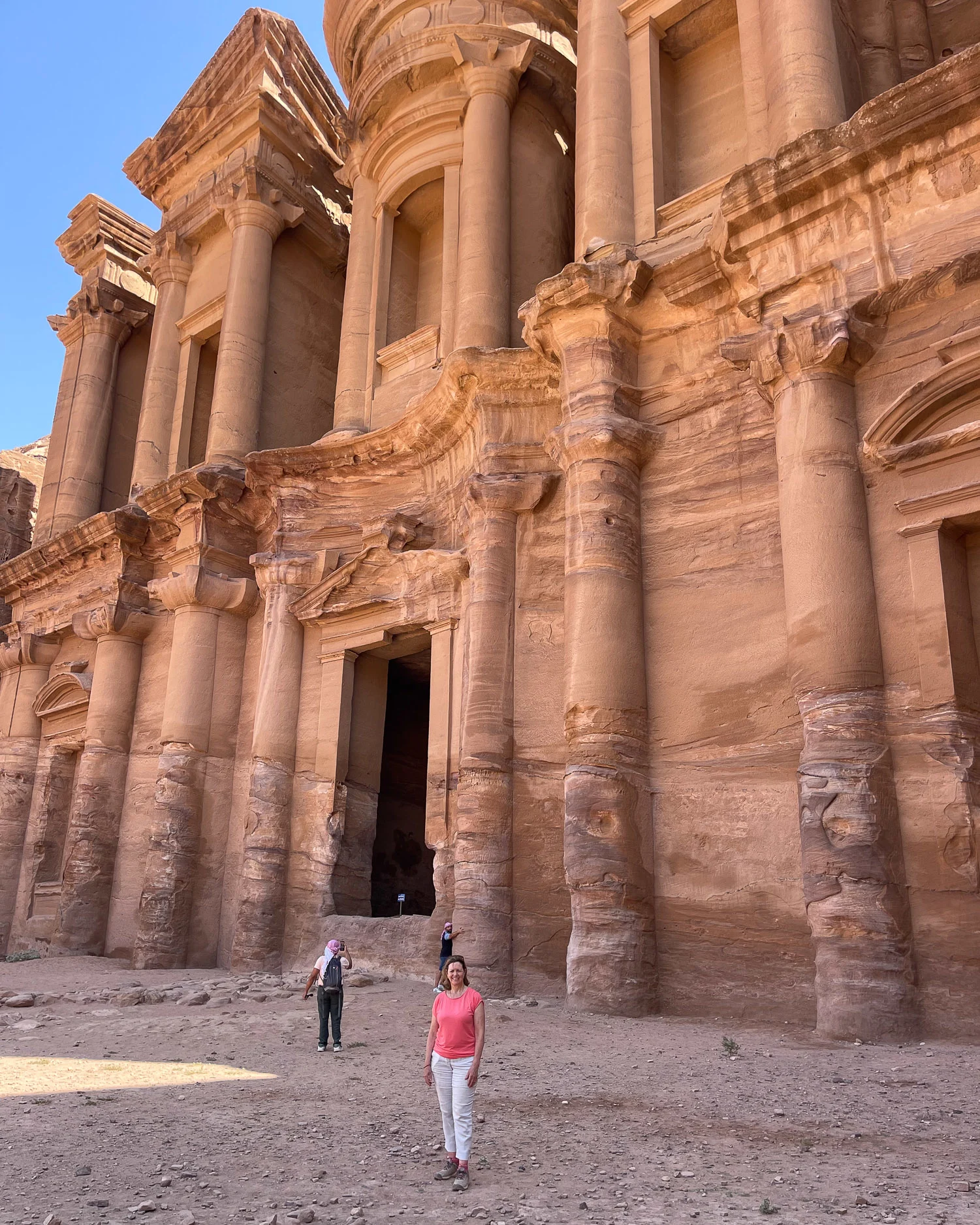
16. The Petra Museum
This excellent modern museum is right by the visitor centre and is free to visit. It tells the story of the Nabataeans and history of Petra, with all the main artefacts that were found at the site. We enjoyed the exhibitions and audio-visual displays that really helped to put the history of Petra in context.
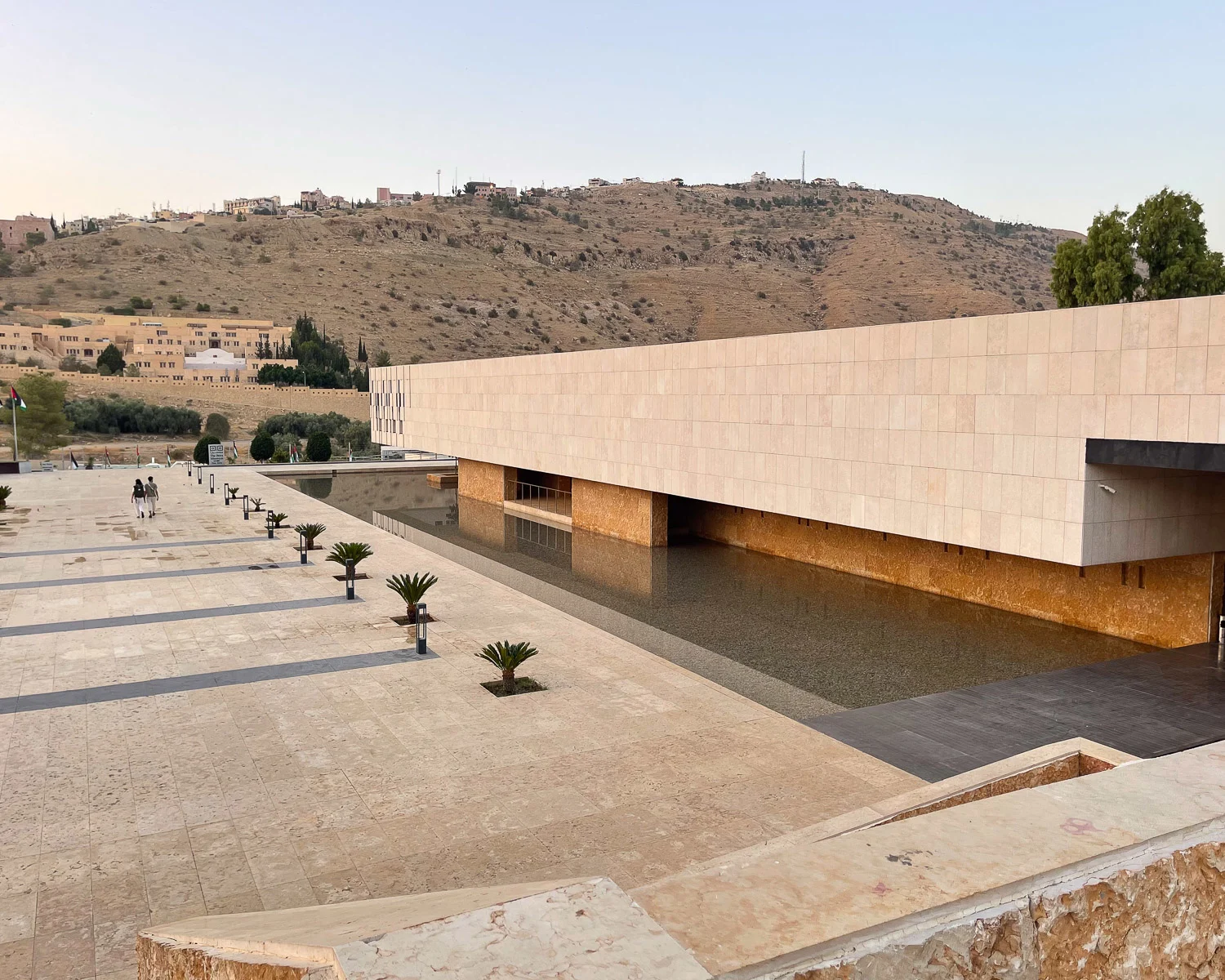
The Museum stays open quite late, allowing you to visit after your day at Petra. Outside are shallow pools, a plaza and well tended grass that seemed a favourite place for locals to gather in the evening or to have a picnic.
Petra Museum Opening Hours: The museum is open daily 8.30am – 8.30pm and is free
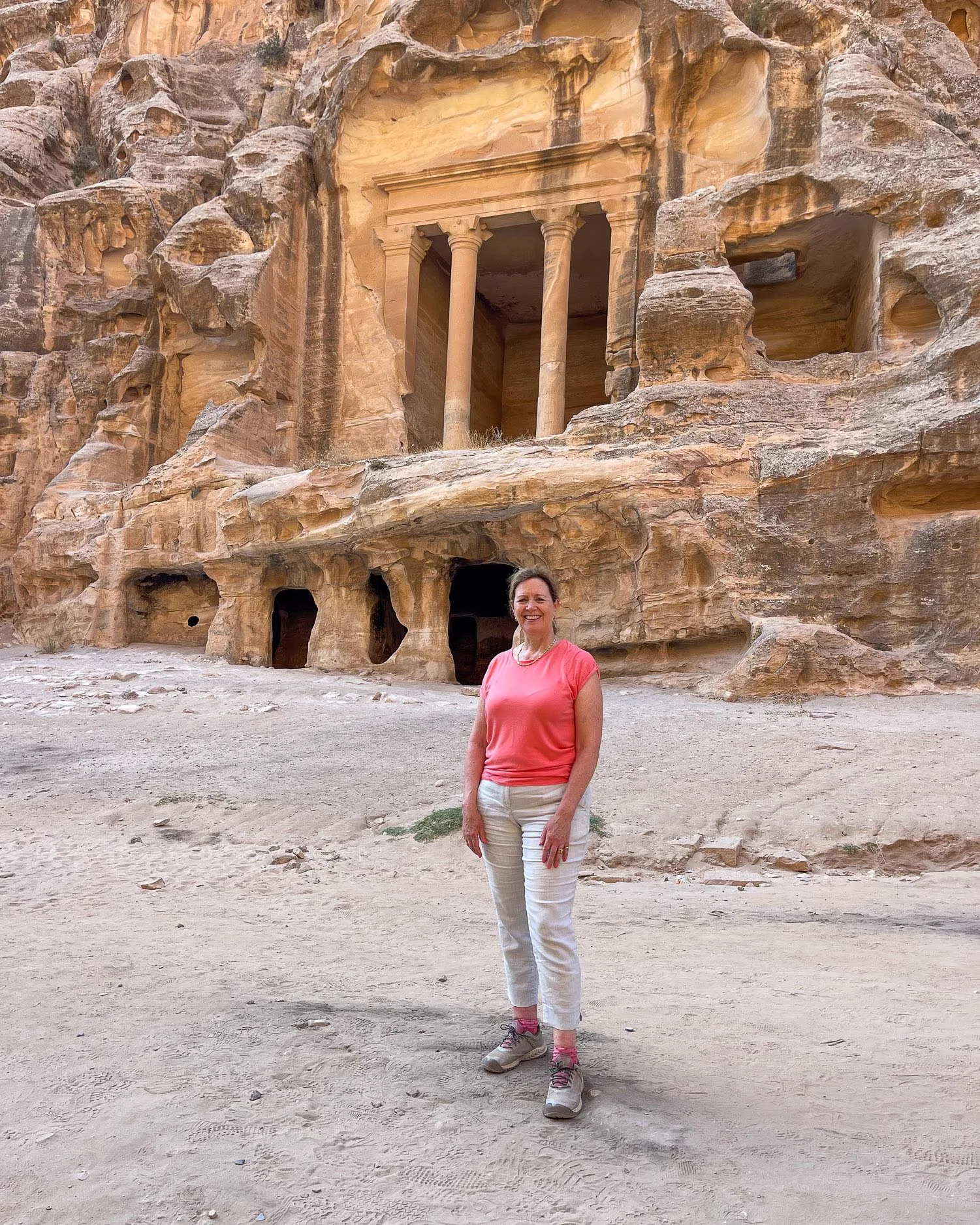
17. Little Petra (Siq Al-Barid)
This smaller gorge area with carved tombs and facades is an 8km drive from the main Petra site and is much quieter. It’s well worth a visit and there’s a free car park, or a free minibus shuttle that will take you there from the back of the Petra Visitor Centre (first shuttle 7.30am).
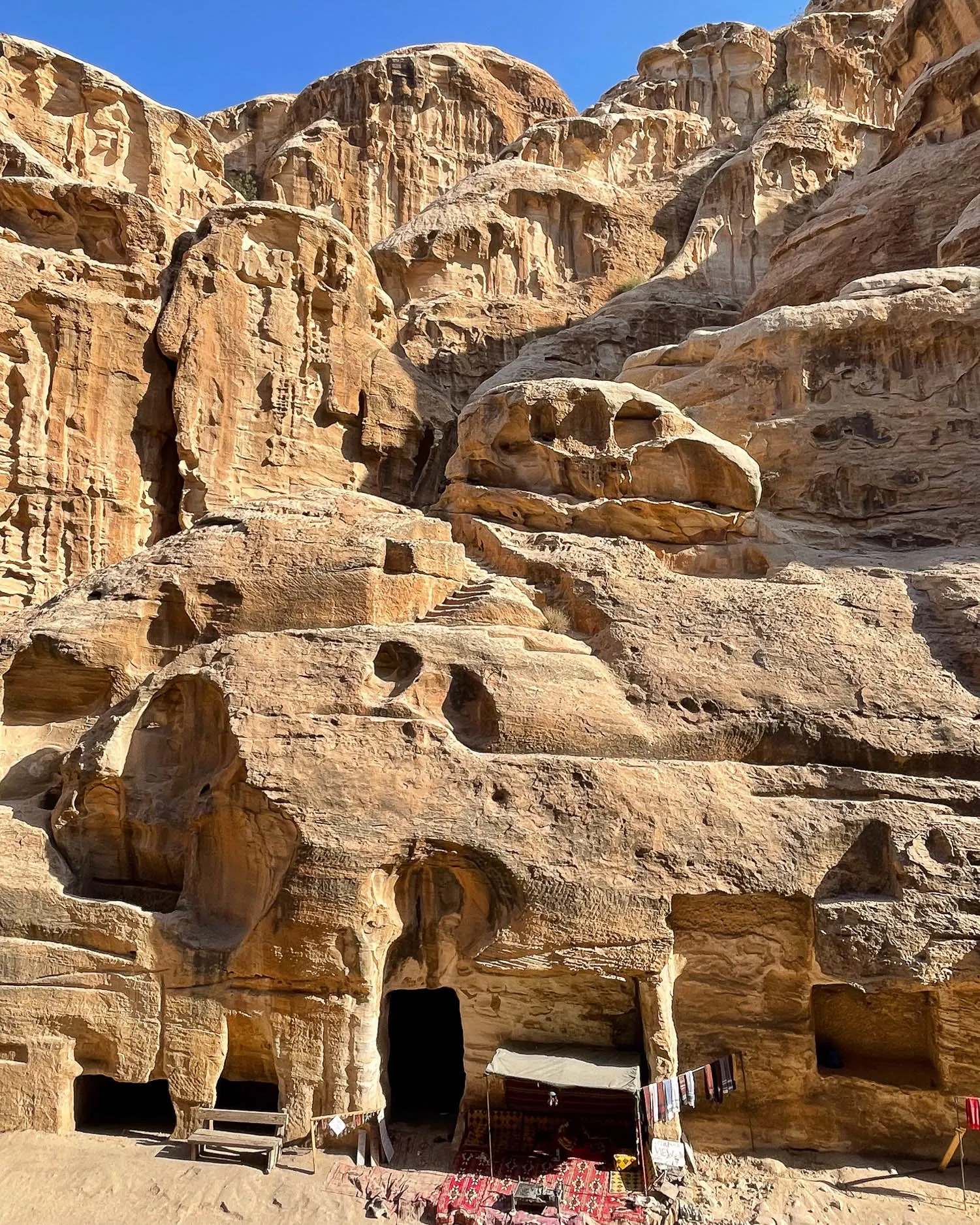
On entering the gorge area, tombs can be seen on both sides of the cliffs. Most notable is the large chamber with columns, known as the Painted Biclinium (dining room). On climbing the stone steps, the remains of an intricate painting of vines, flowers and nymphs can be seen on the ceiling.
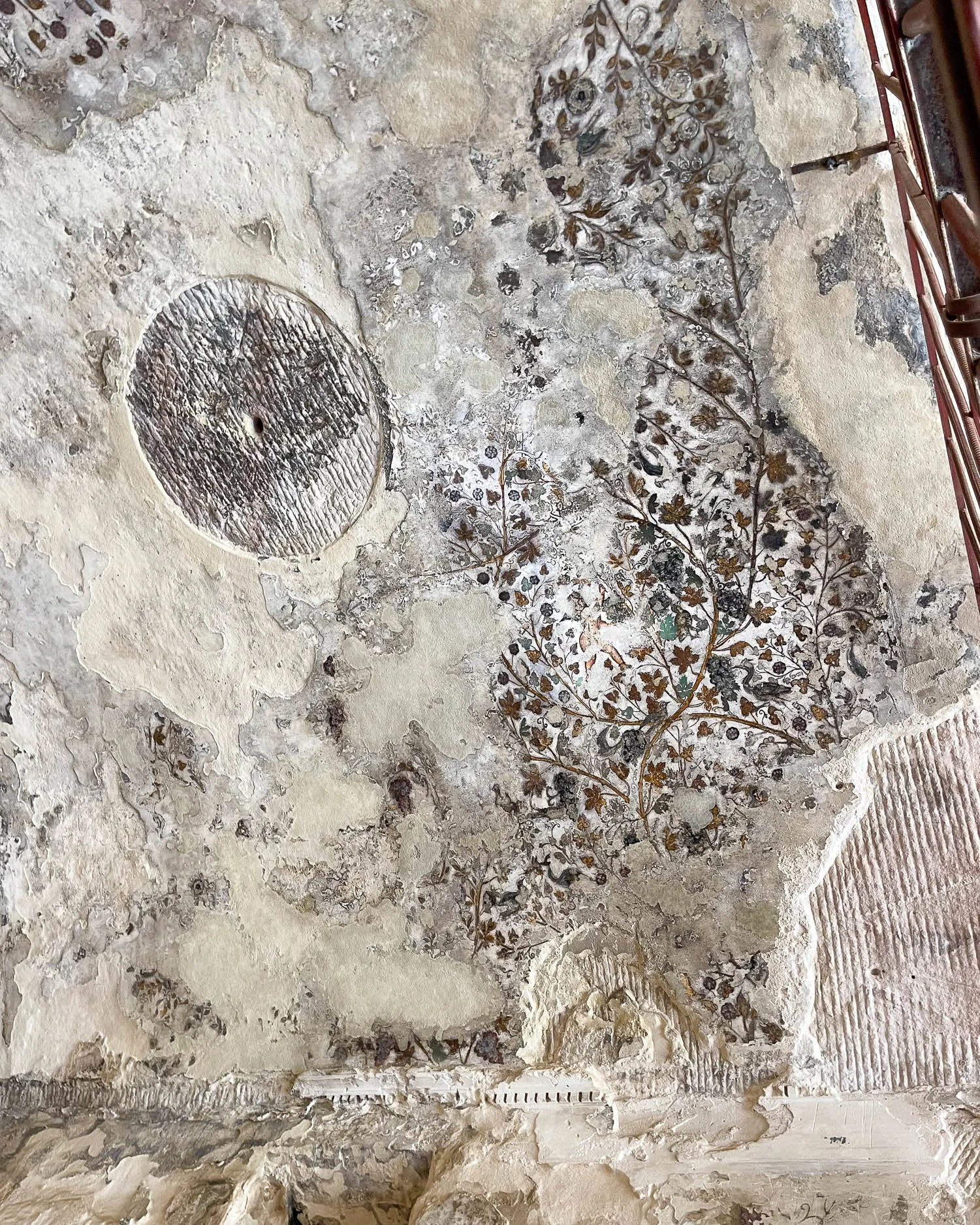
At the end of the valley area, steps cut into the rock lead up to a viewpoint over another Wadi, with a pleasant Bedouin cafe, where you can rest and take a mint tea before returning back the same way.
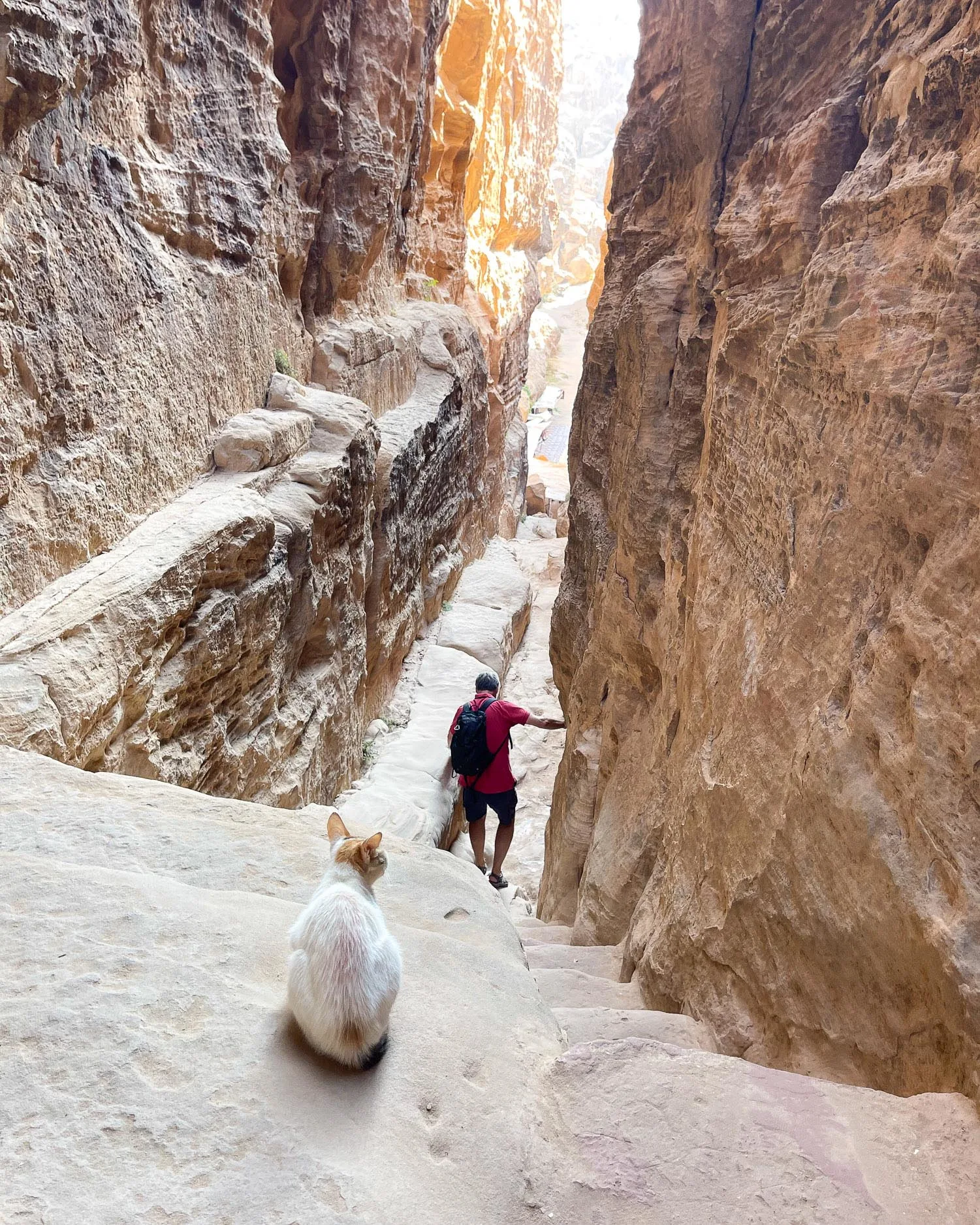
For more tips and advice to help you plan your visit, such as when to go, ticket prices, weather, avoiding scams, what to wear, read our other article about Visiting Petra in Jordan – the ultimate travel guide
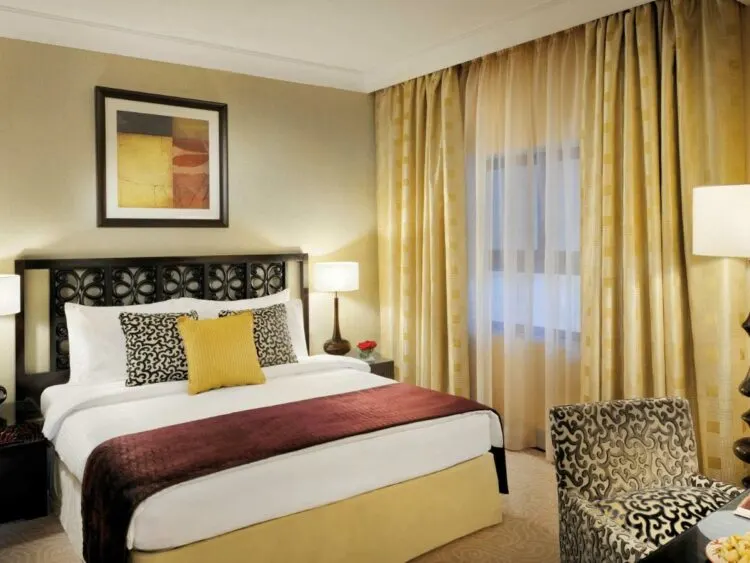
Mövenpick Resort Petra – A luxury hotel with swimming pool that’s opposite the Petra Visitor Centre
18. More things to do in Petra – Petra by Night
Petra by Night tickets
Petra by Night is a chance to experience the area in front of the Treasury after dark, lit up by hundreds of flickering lanterns. The event happens every Monday, Wednesday and Thursday, so it’s worth timing your visit for one of these days.
The experience starts at the visitor centre at 8.30 pm when you are allowed to walk down the track, into the Siq and on towards the Treasury. The event is finished by 10.30pm, when you leave the Treasury area to walk back to the visitor centre.
You need to have a general ticket for Petra to attend, and you need to buy an additional Petra by night ticket. The cost of the Petra by night ticket is 17 JD with children under 10 going free.
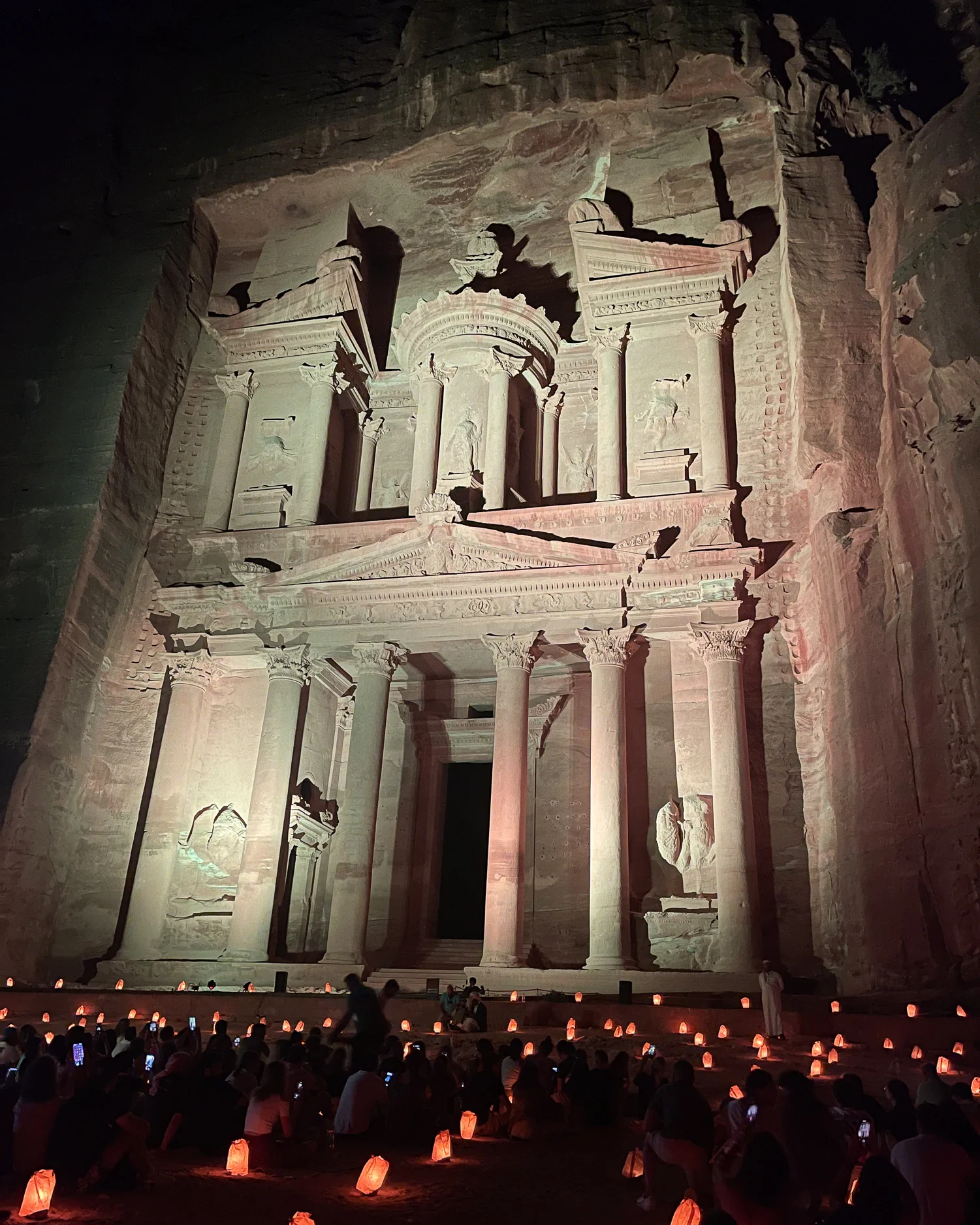
Our Petra by Night experience
We had a fun experience and were glad that we had done Petra by night, but it’s not quite the magical, mystical experience that you might expect from the photos posted on social media.
For a start, there seems to be no limit on numbers, so you’ll probably find yourself jostling with several hundred others, all trying to get the perfect photo. We’d recommend that you arrive 20-30 minutes early at the visitor centre, and then walk fairly briskly through the Siq and on to the Treasury.
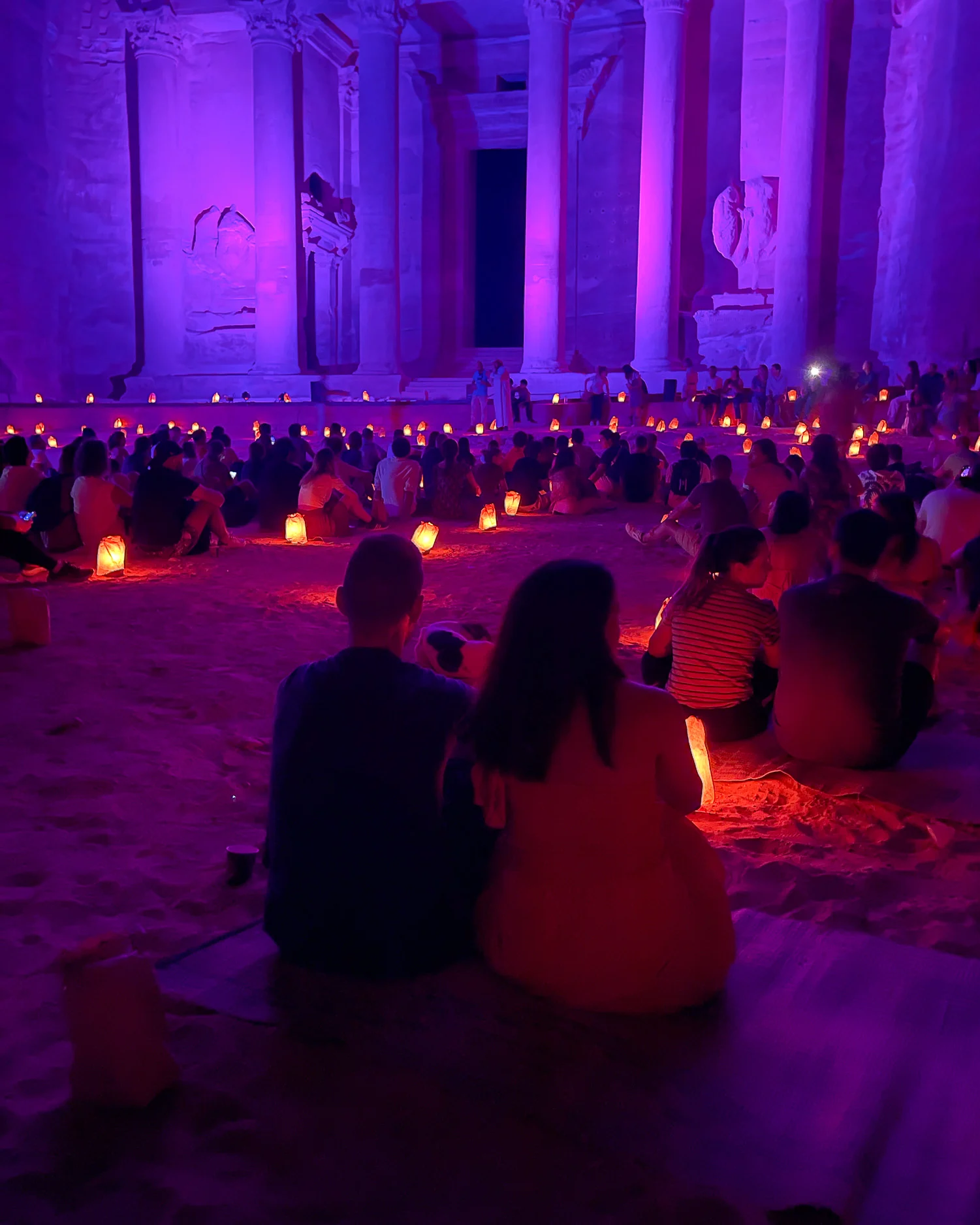
By arriving early, you’ll be able to take photos of the treasury, lit by flickering lamps, before too many people arrive to crowd the space. Next, try to bag seats in the front row of the stools that are laid out, so you’ll have a better view during the performance. Once these seats are taken, you’ll be sitting on mats in the main area of the Treasury.
The performance involved an introduction to the history of Petra, followed by a performance of some traditional music. We were also served a complimentary cup of mint tea. Throughout, the Treasury was lit up with a succession of different colours.
During the whole performance, people were chatting and taking photos, so it wasn’t quite a silent and reflective as you might expect. Latecomers were constantly being ushered in to find a seat in front of us, which we found quite distracting. Nevertheless, Petra by Night is an enjoyable and highly recommended experience as part of your visit to Petra.
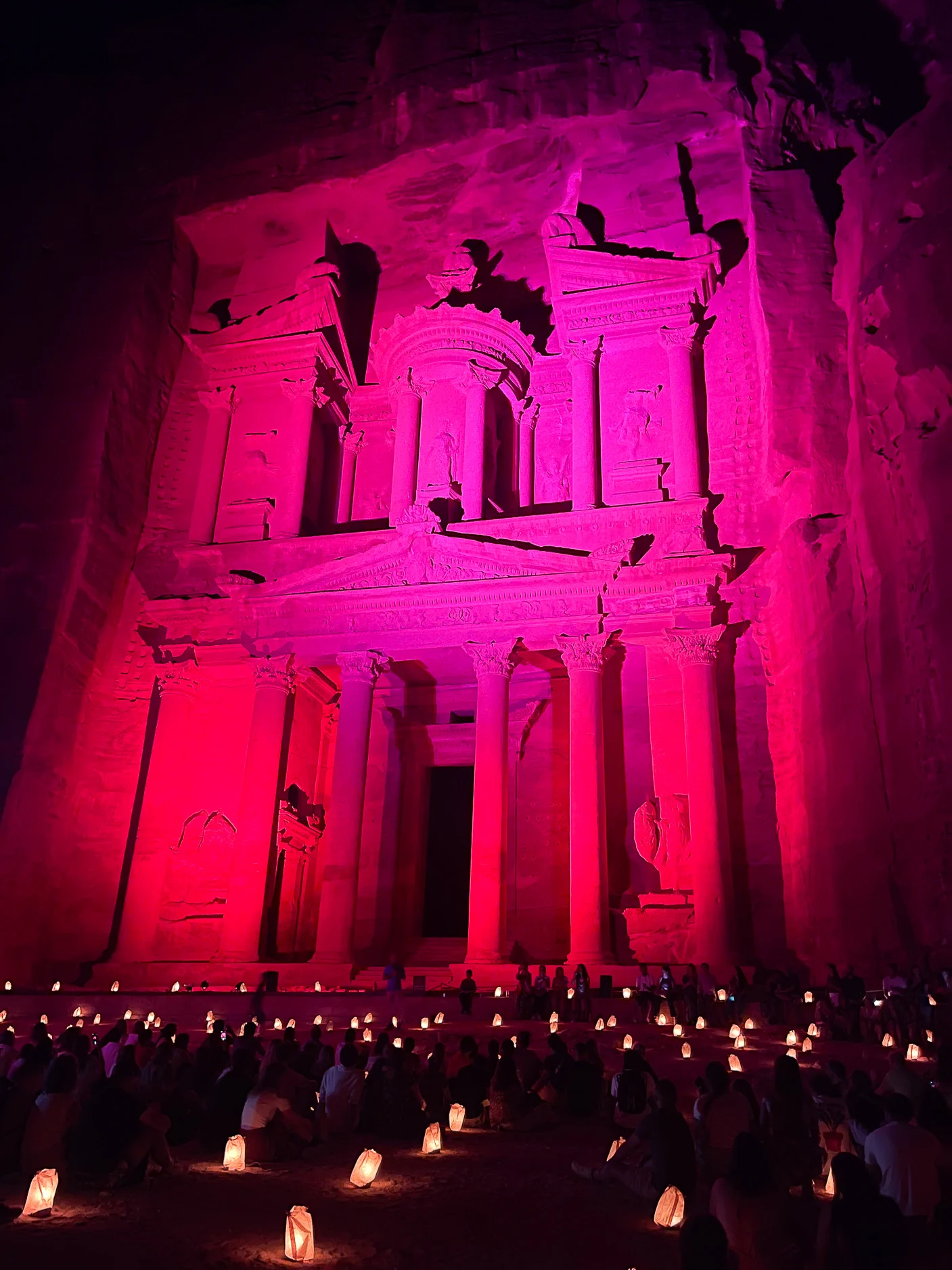
19. Hiking Trails in Petra
Most of the hiking trails in Petra are easy to follow and can be walked without a guide. There are a couple longer or more remote trails that do require a guide, which can be arranged at the Petra Visitor Centre, ideally with a day’s notice.
Main Trail
The Main Trail is the one that most visitors will walk. From the Petra Visitor Centre there’s a 20 minute walk along an open track to the start of the Siq. The trail then enters the narrow gorge of the Siq, bringing you after 20 minutes to the stunning Treasury view.
From here you follow the valley floor as it opens out, past the Theatre and Royal Tombs. The trail leads into the area known as Petra City Centre (the heart of the ancient city). Here are located the Great Temple and Colonnaded street.
At the end of the valley is the “Basin area” where two restaurants are located at the foot of the trail leading up 800 steps to the Monastery. The Main Trail is 8km, flat and easy, running gently downhill from the Treasury to Basin area.
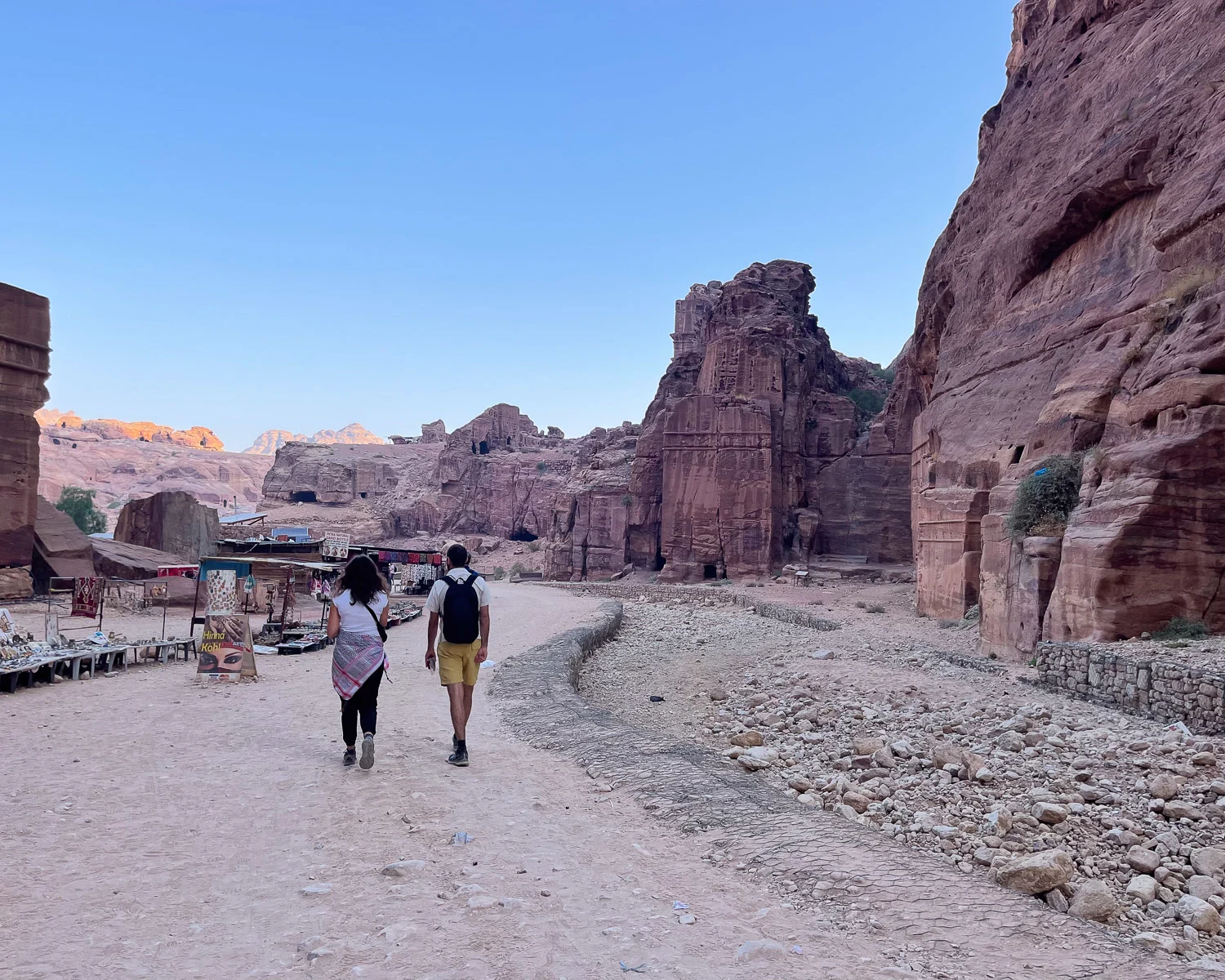
High Place of Sacrifice Trail
The start of the High Place of Sacrifice Trail is a short walk from the Treasury and before the street of the Facades, where you’ll see a cluster of cafes and the public toilets. This trail takes you up a gorge on a stepped path, with lovely views back over the Royal Tombs.
At the top near a cluster of Bedouin stalls, the trail bears right onto a small plateau with stunning views over the valley below. Up some further steps from here, marked by a flag are some carved rocks, the site of religious ceremonies and sacrifices.
The quickest route to return is by the same way you came up. This 3km trail is stepped and requires moderate fitness. It took us around 2 hours to go up and back.
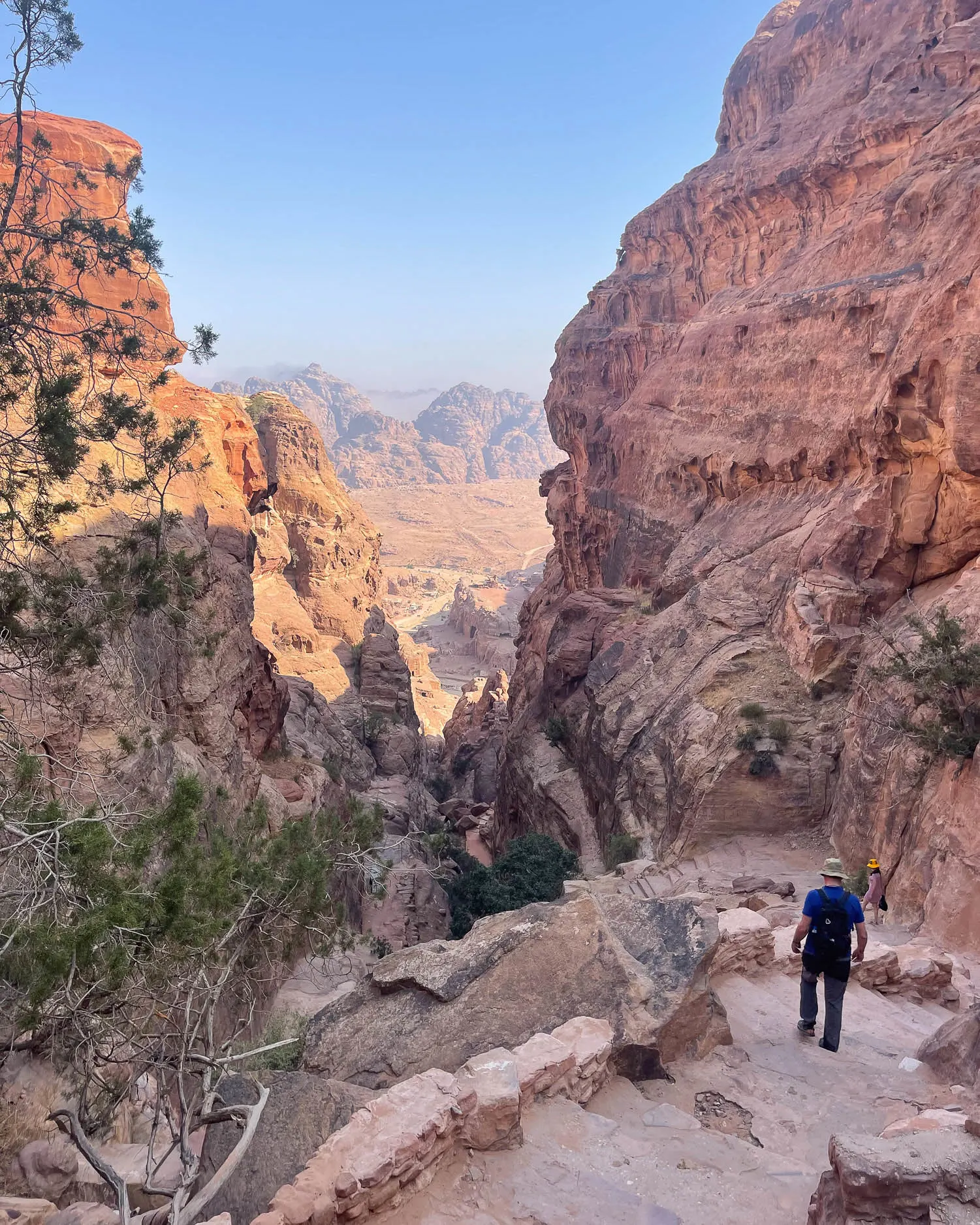
From the High Place of Sacrifice via Wadi al Farasa
Once you have visited the High Place of Sacrifice, you also have the option to continue on a trail through Wadi al Farasa. A side trail branches off, bringing you down to the valley floor, behind the Theatre.
Alternatively you can continue all the way along Wadi Farasa through the ‘Garden Valley’ to the Basin area. We did not take this trail, but heard that it is very beautiful with the pink oleander blooming in spring and some striking tombs to see on the way. It should take 2.5 – 3 hours to walk up to the High Place of Sacrifice and continue through Wadi al Farasa to the Basin area.
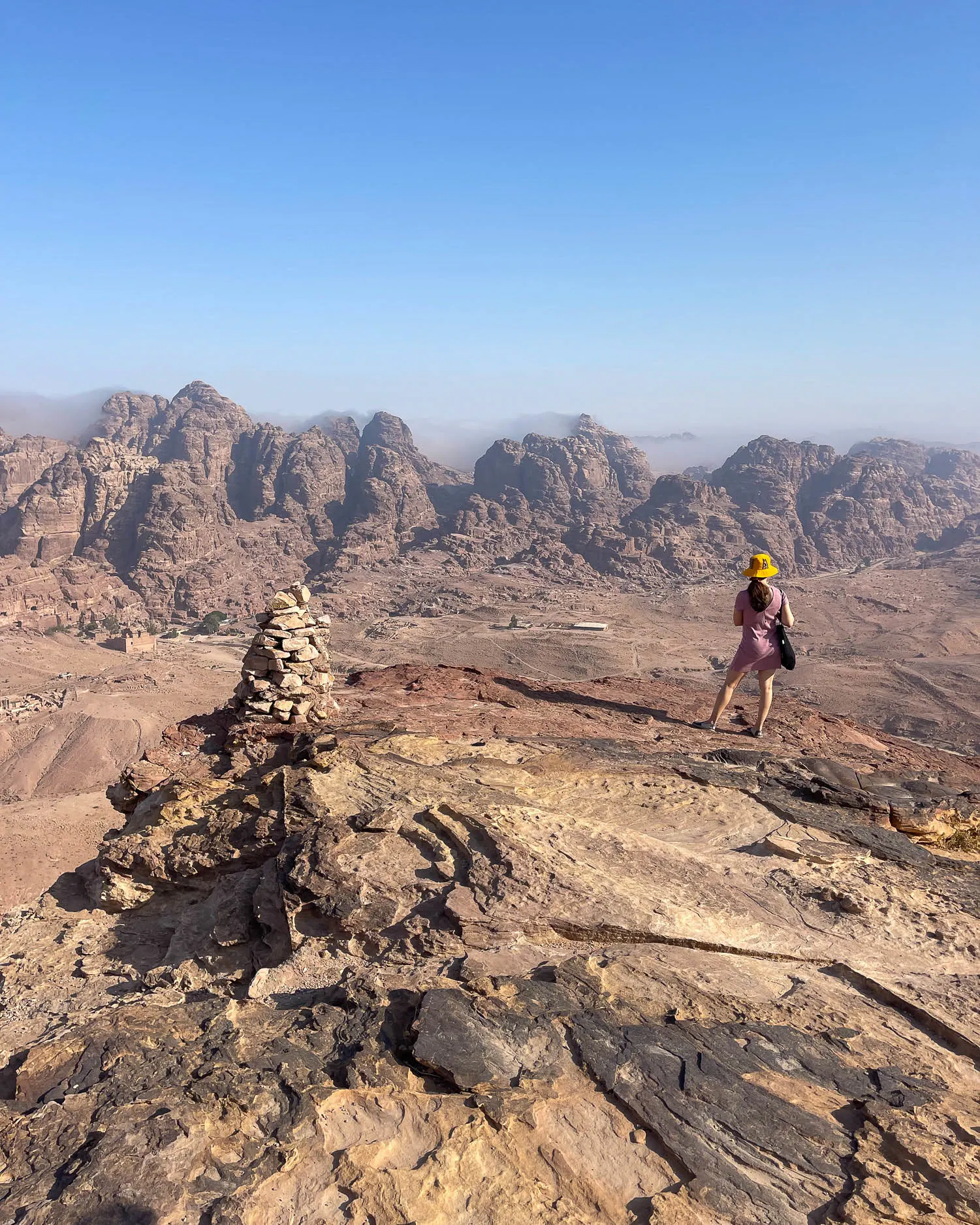
Ad Deir (Monastery) Trail
This well travelled trail is the one that takes you up from the Basin area to the Monastery. It starts behind the Basin Restaurant and you will easily spot the numerous people coming down the trail. Running up a gorge, over 800 irregular steps twist and turn in a relentless uphill climb. In just under an hour you’ll arrive at the Monastery, a 47 metre high carved tomb to rival the Treasury.
The upper part of the trail is lined with souvenir stalls, where you can easily buy drinks. If you feel it’s too much to walk, you could hire a donkey to take you on the way up. However I would personally recommend walking rather than riding a donkey for the way down since the trail is so steep.
The 2.5 km trail takes around 45 – 60 minutes to climb up to the Monastery, plus time to look around. I’d rate this as a moderate trail, since although it’s steep, the steps are well maintained and easy to follow all the way.
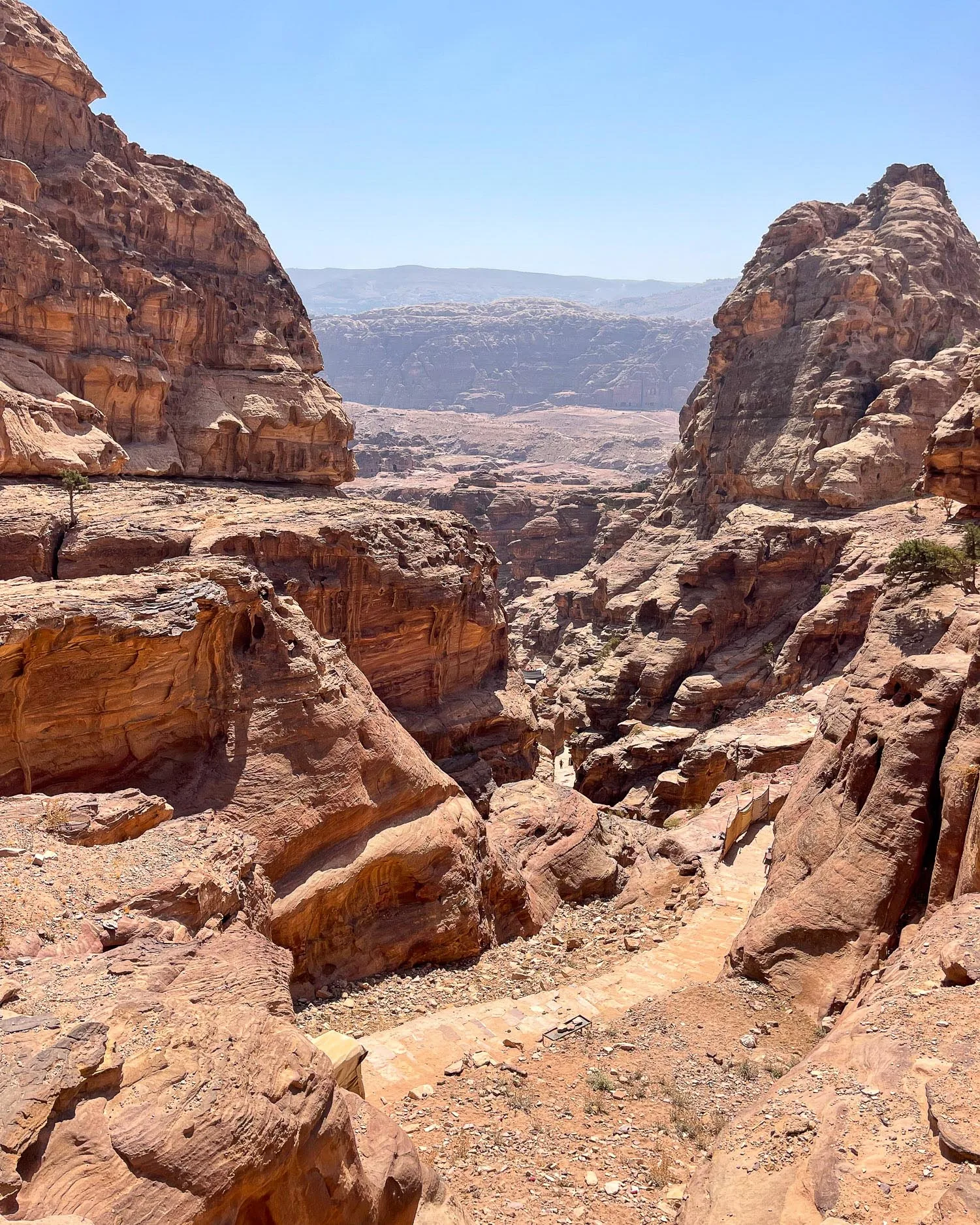
Al-Khubtha Trail to Treasury viewpoint
If you stand facing the Royal Tombs, the start of the Al-Kubtha Trail is to the left of the last tomb. The first part of the trail climbs on well maintained steps, although with little shade. The path twists and turns as you gradually climb to the top of the cliff, until you reach a viewpoint where you can look down on the Theatre in the valley below.
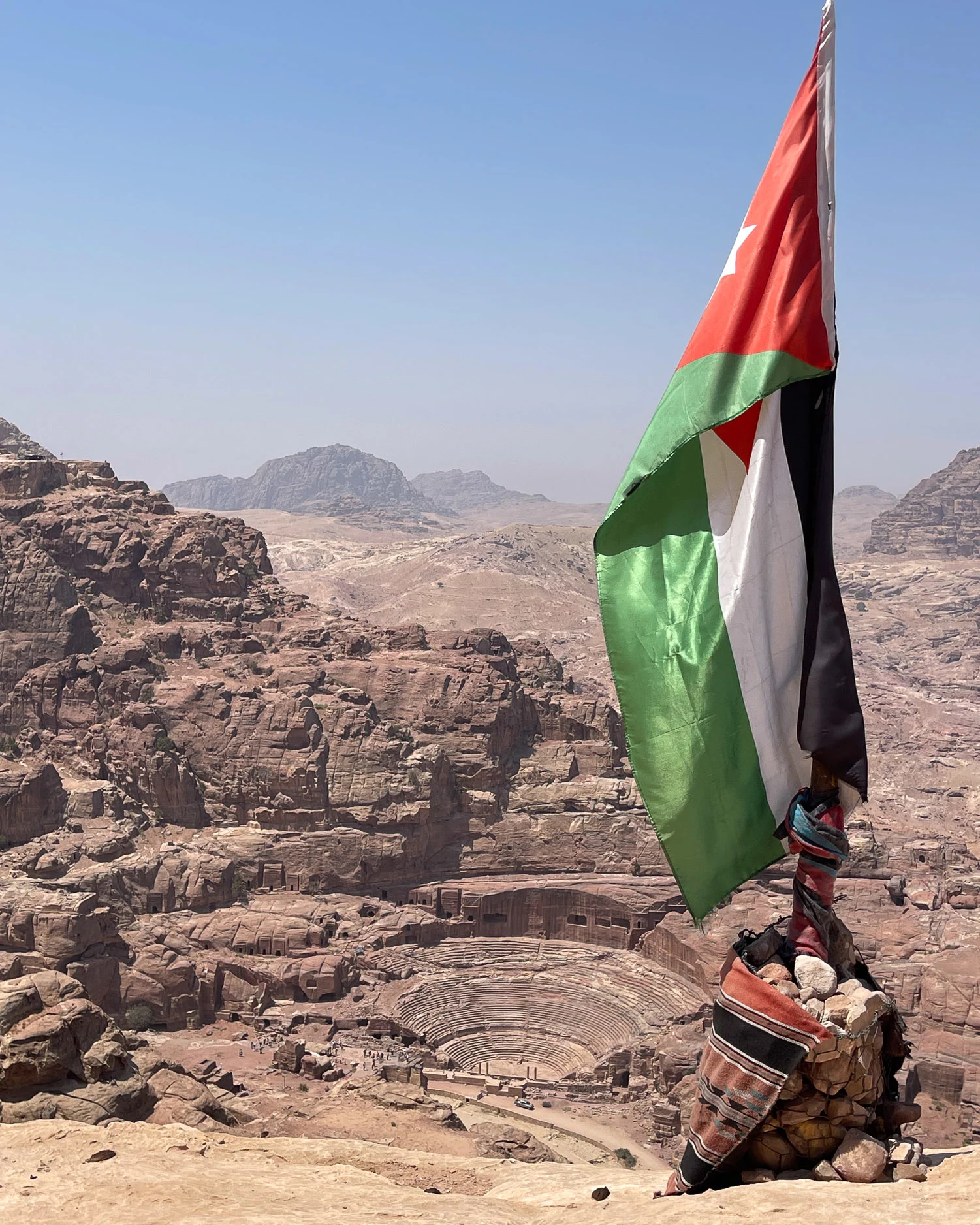
A short distance further is a tea tent, with a few viewpoints that seemed to have been abandoned. Then take some steps cut into the rock next to the tea tent to descend down a faint path of rock and gravel, which brings you to the viewpoint overlooking the Treasury.
You actually need to go into the Bedouin tea tent that’s pitched in front of the viewpoint and buy an obligatory drink, in order to see the view. There are rugs laid out for you to sit and take a photo, but take care as it really is on the edge of the cliff, with nothing between you and a sheer drop.
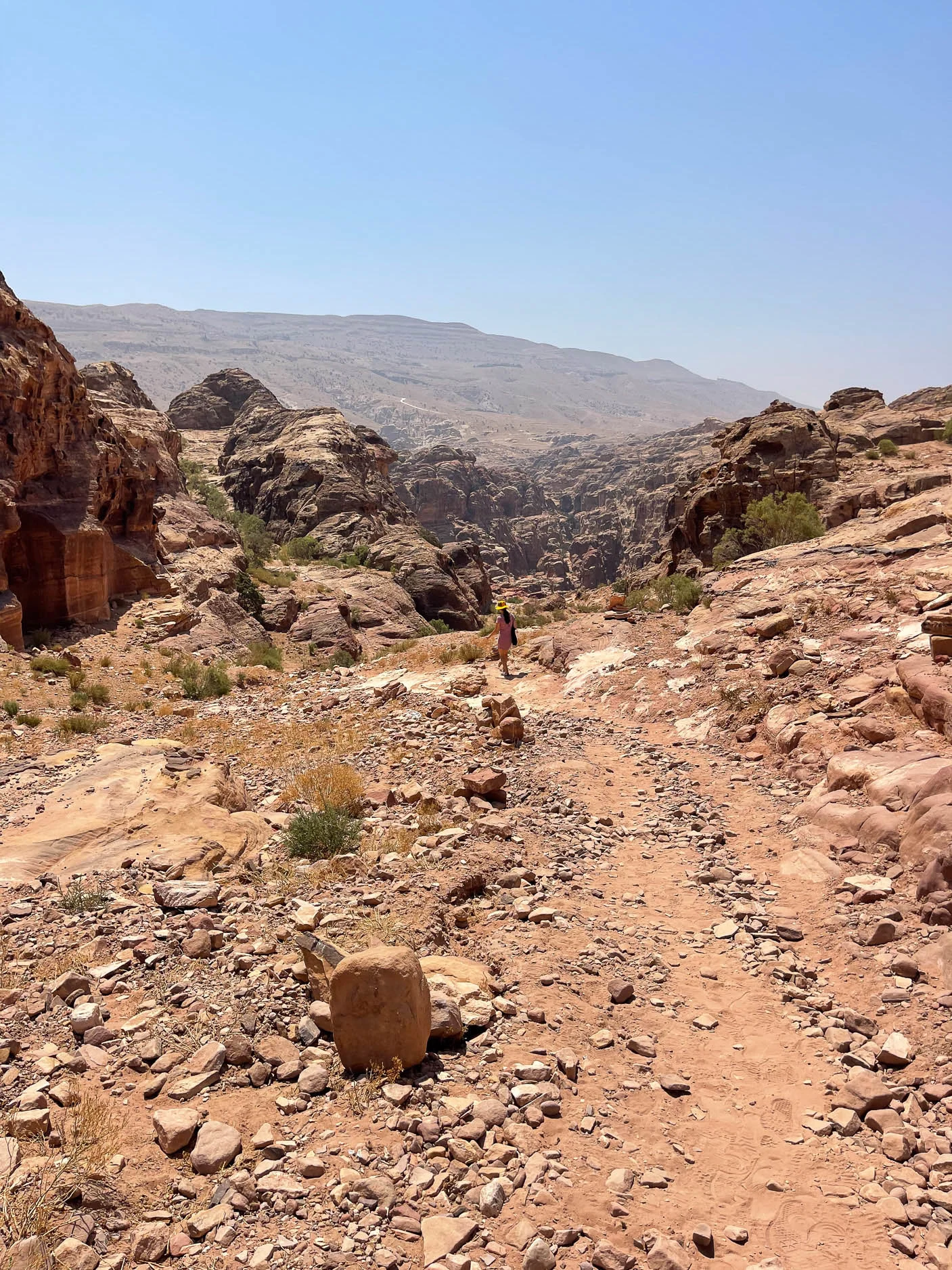
This trail took around 2.5 hours round trip from the Royal Tombs. I’d rate it as arduous, because the steps are steep and there’s an element of scrambling on slippery rocks to find the viewpoint at the end.
Umm al-Biyara Trail / Jabal Harounn Trail / Wadi Sabra Trail
From the Basin area the Wadi Sabra trail runs up behind the Qasr-al-Bint and the Great Temple. After a few kilometres it branches up a valley as the Umm al-Biyara Trail, with steep steps taking you up to a mountain peak overlooking the Petra City Centre. If you continue on the Wadi Sabra Trail, it also branches off to Jabal-Haroun, which is another high mountain peak.
We did not take either trail, but read that the Sabra Trail runs for around 10km. Due to its length, the Sabra trail is often taken on horseback, although you may wish to dismount on steeper sections. If you enjoy horse-riding, this could be a fun experience.
You do need a guide for the Wadi Sabra trail, due to the risk of losing your way, although probably not for the shorter Umm al-Biyara trail. Guides can be booked at the Petra Visitor Centre with at least 24 hours notice, since not all guides will do this trail. Expect to pay around 150-200 JD for the guide but check if horses are included. The trail will take you most of the day, so this is one for the more adventurous hiker.
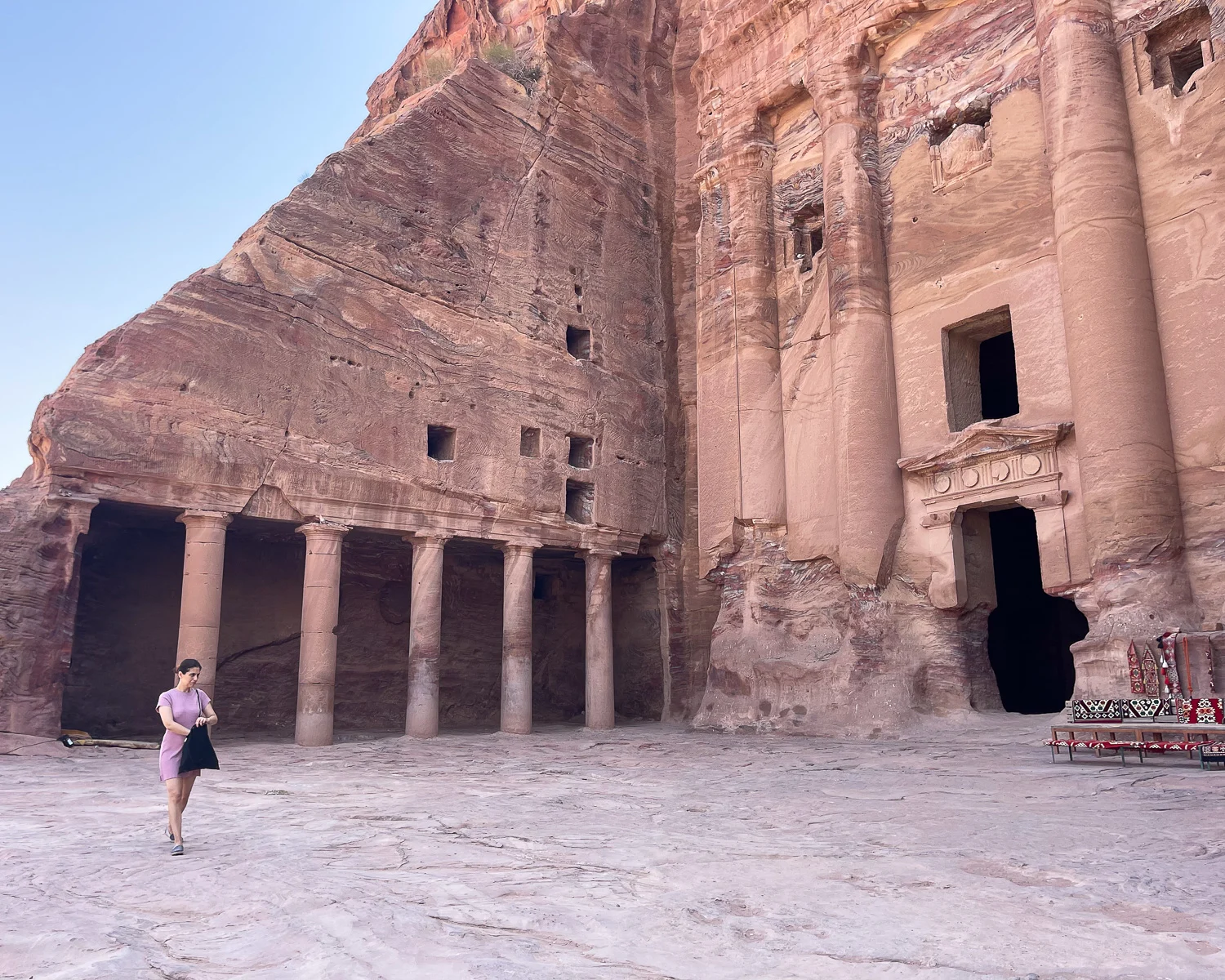
Wadi Muthlim to Royal Tombs Trail
Due to the sometimes narrow paths and risk of flash floods, a guide is mandatory for this hike, which provides an alternative route into Petra, if you have already walked through the Siq. Walking down from the Petra Visitor Centre, you’ll branch off right before the entrance to the Siq.
There’s an 88 metre long tunnel, carved by the Nabataeans, after which you follow the route along the river bed of Wadi Muthlim. Large boulders block the way in places, another reason you need a guide to help you climb over them.
As the path joins Wadi Mataha it narrows and depending on the season, you may need to splash through pools of water in the river bed. The hike to the Royal Tombs should take 1.5 – 2 hours. Check at the Visitor Centre whether this hike is open and book a guide at the official guide’s kiosk.
For more tips and advice to help you plan your visit, such as when to go, ticket prices, weather, avoiding scams, what to wear, read our other article about Visiting Petra in Jordan – the ultimate travel guide
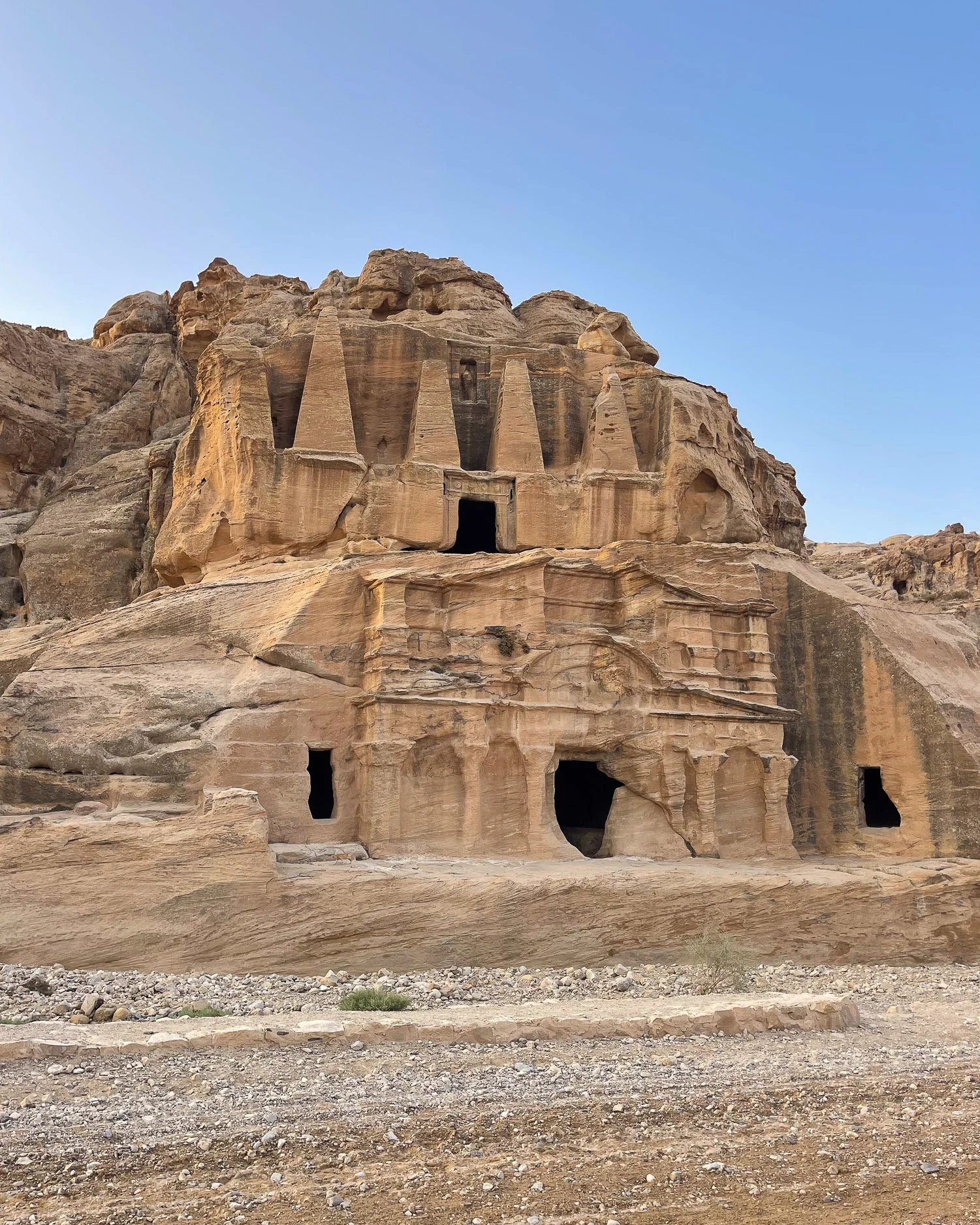
20. Little Petra to Monastery trail (Petra Back Door)
We took the free minibus to from the back of Petra Visitor Centre to Little Petra, which runs throughout the day (first bus at 7.30am). After looking around Little Petra, we boarded a 4 wheel drive vehicle with around 20 seats, which took us along a dirt track for 15-20 minutes to a point where the trail starts to wind uphill. You could also walk along this track from Little Petra, but there’s a slight danger of getting lost since the trail splits in several places.
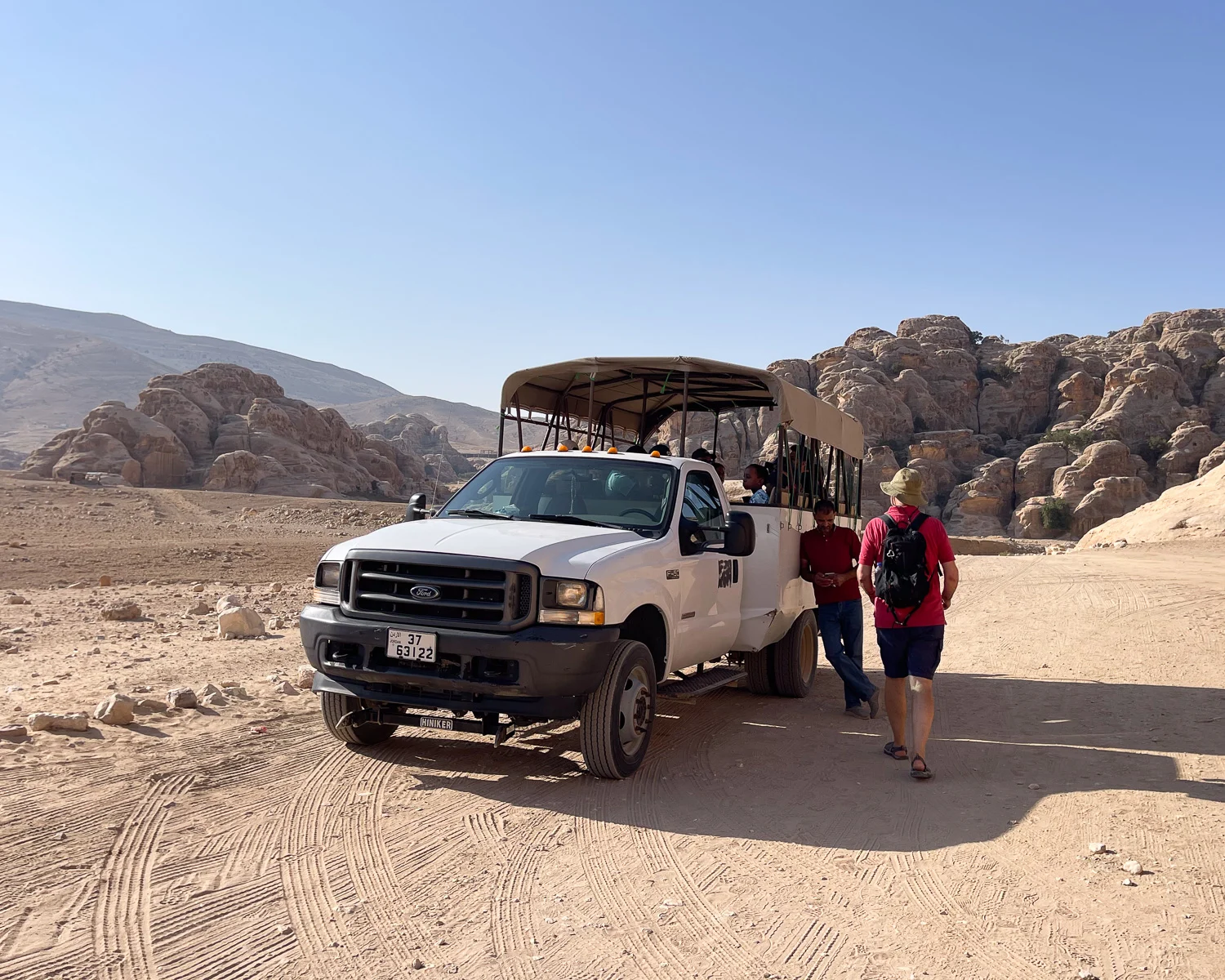
From the drop off point, we followed a well maintained path, winding along the side of the cliff, climbing gradually with steps in places. The views over the desert landscape were stunning.
Although there was a steady stream of walkers, there are no souvenir stalls or crowds on this route. We really enjoyed the trail, which I’d rate as moderate difficulty, and it took us around an hour to reach the Monastery.
If you walk the whole trail from Little Petra to the Monastery it should take around 2.5 hours. It’s also possible to walk in reverse from the Monastery to Little Petra. However you’d need to plan to walk the whole trail. The 4 wheel drive vehicle is not guaranteed to be available to take you part of the way. You would also need to pre-plan a pickup from Little Petra back to the Visitor Centre, or check whether the free mini bus transfer will be running.
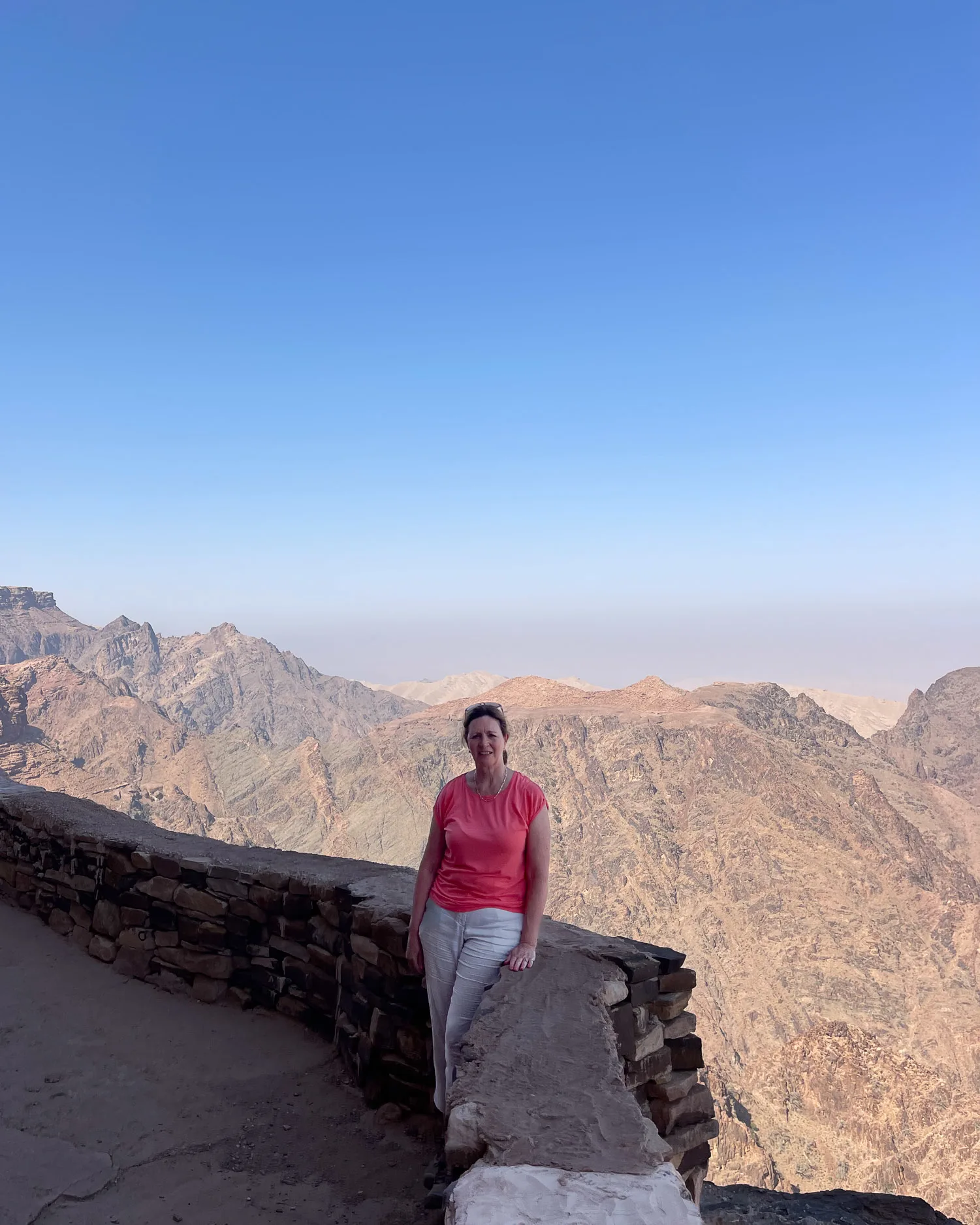
Guided tours of Petra
There are many organised group tours within Jordan. These take you to Petra and other key tourist attractions, such as Wadi Rum and the Dead Sea. However, many of these only allow you half a day at Petra. Unless you are very pressed for time, you may prefer to visit independently and allow a couple of days for your visit.
Once you arrive at the Petra Visitor Centre, there’s an official guide kiosk opposite the ticket counters. One of the guides will be available to answer questions. Prices are clearly posted on the wall of the kiosk and start at 50 JD, for a 3 hour tour with an official guide to explain the history the main sites of Petra.
The price is per guide, rather than per person. So while not the cheapest, hiring a guide is a good option if there’s a small group of you, or you have very limited time to see the site.
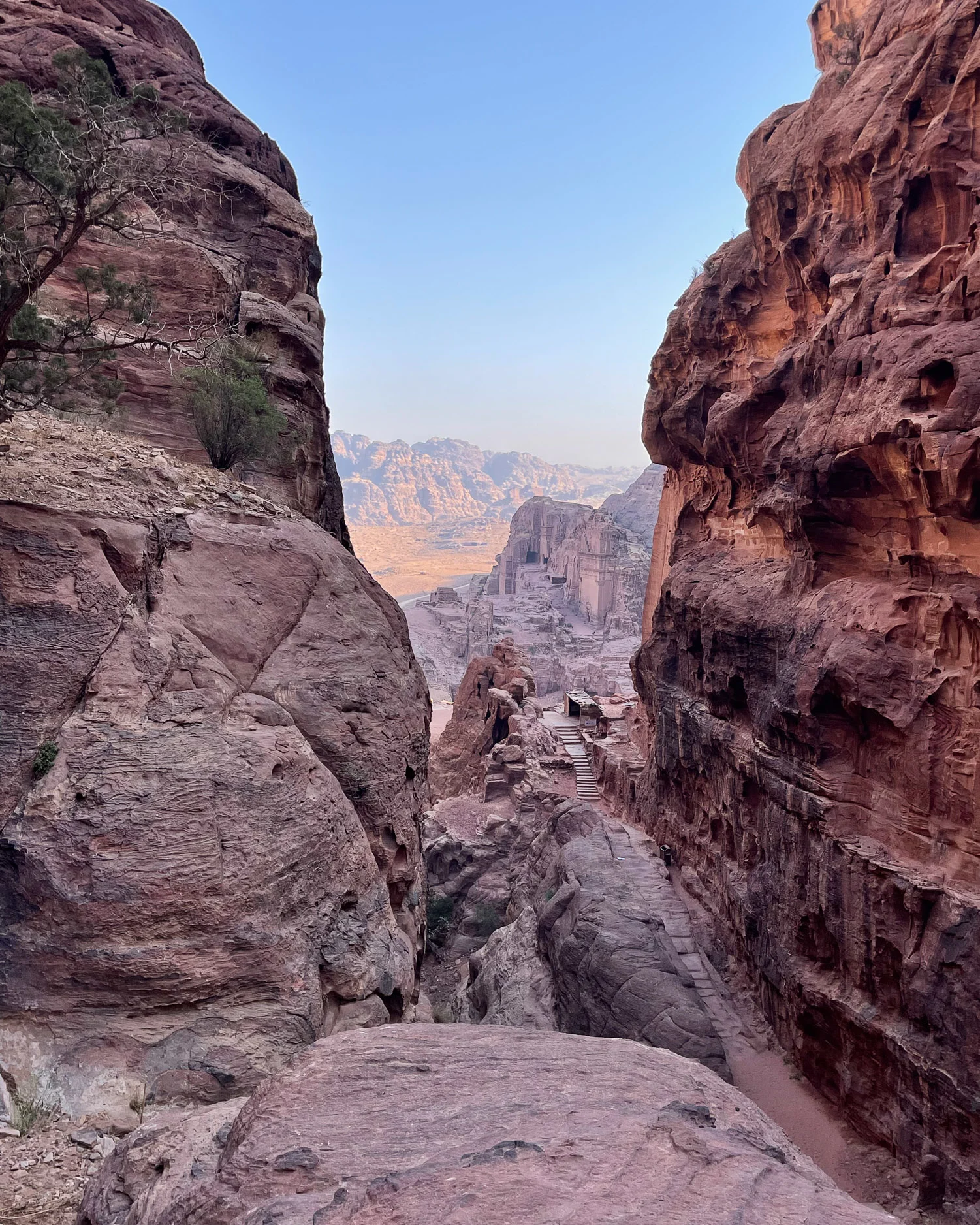
Because there were just two of us, and we had plenty of time, we decided to rely on the explanations in our guidebook. Most of the trails around Petra can be walked independently without any guides and the paths are easy to follow. However, we saw limited information boards offering any explanation of the main sites. So, we’d recommend taking a guide book or picking up a visitor map at the Visitor Centre.
There are a few longer or more remote trails where it is either mandatory or advisable to hire a guide. The price of a guide for the different trails varies but as an example a 5 hr trail costs 120 JD or a 6-8 hr trail costs 150 JD, based on the prices posted at the Visitor Centre.
Map of Petra Archeological site
Paper maps of Petra are available in several languages including English from the Petra Visitor Centre. We could not find any copy of this map online, so we’ve taken a photo of it below.
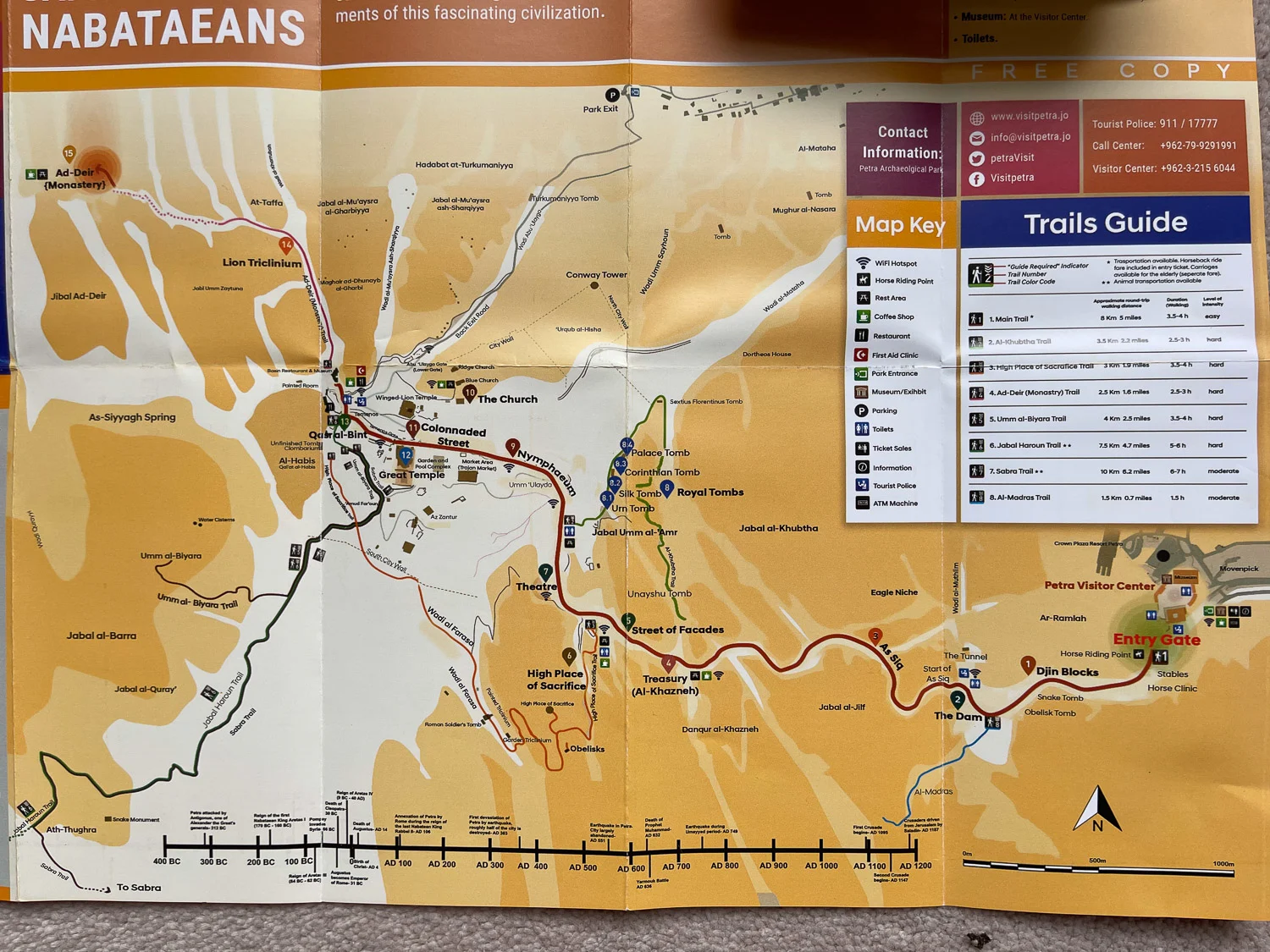
Below is our own map showing locations of the key things to see in Petra,as well as restaurants and toilet locations. There are also numerous stalls selling souvenirs, drinks and snacks, which are too many to mark on the map. For more detail, click on this link or on the map below.
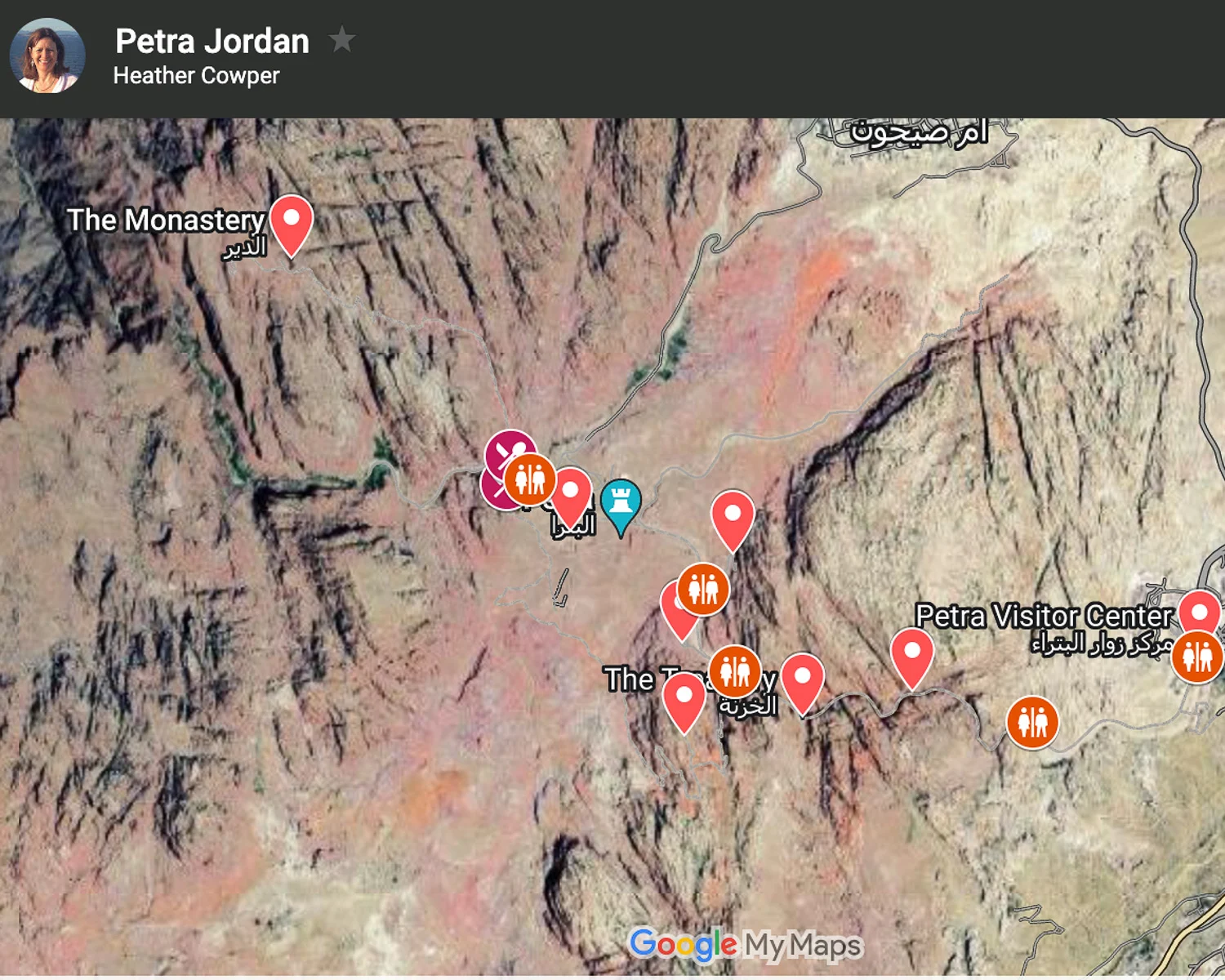
FAQ for Petra
Because there’s so much to consider when planning to visit Petra, we’ve written a separate article with helpful advice: Visiting Petra in Jordan – the ultimate travel guide. This covers in more detail all our tips, such as how to get there, when to go, ticket prices, weather, avoiding scams, animals rides and what to wear.
However, we’ve also given a shortened version of some of these tips in the Frequently Asked Questions for Petra below.
Where to stay in Petra
We recommend staying in the lower town of Wadi Musa, to be close to the entrance to Petra. You’ll also find a range of cheaper hotels and lots of restaurants in the upper town which is 15 minutes walk up the hill. Taxis are available outside the Visitor Centre, to run you between the lower town and upper town, if you don’t want to walk.
Below are some recommended hotel options in the lower part of Wadi Musa.

Esperanza Petra – A good budget hotel with rooftop restaurant in the lower town of Wadi Musa (we stayed here)

Petra Guest House Hotel – A mid range hotel with famous cave bar located next to the Petra Visitor Centre

Mövenpick Resort Petra – A luxury hotel with swimming pool that’s opposite the Petra Visitor Centre
How do I buy tickets for Petra?
Tickets for Petra are sold at the Petra Visitor Centre, the price is 50JD for 1 day, 55 JD for 2 days and 60 JD for 3 days. Make sure you take your passport with you as you need it to purchase tickets.
Before you arrive in Jordan, you should also investigate the Jordan Pass. The Jordan Pass includes the cost of your tourist entry visa and ticket to Petra, as well as free entry to some other attractions in Jordan.
You can buy the Jordan Pass online before you travel and the cost varies depending on how long you want to stay at Petra. A Jordan Pass for 1 day in Petra is 70JD, for 2 consecutive days at Petra is 75 JD and for 3 consecutive days at Petra is 80 JD.
Since the cost of the tourist entry visa is 40 JD, you should save at least 20JD if you buy the Jordan Pass and possibly more if you use it to visit multiple attractions.
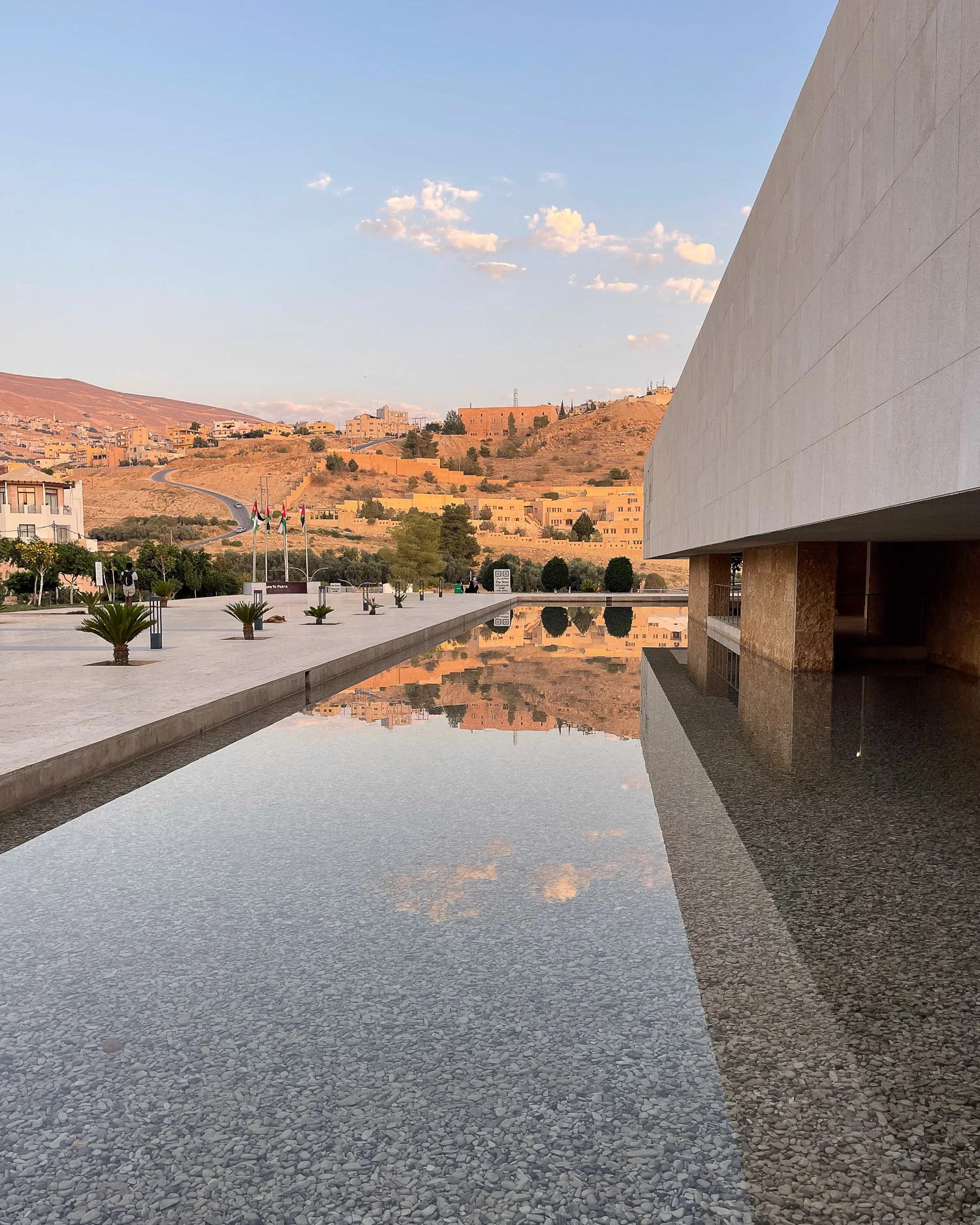
Can I take a tour to see Petra?
If you are an independent traveller and don’t have your own car, a tour that includes Petra could be a good option. Here are a few that we recommend.
3 day tour of Jordan from Amman – This tour includes an overnight stay and visit to Petra. The second night is spent in a desert camp at Wadi Rum, with a visit to the Dead Sea on the way back to Amman.
2 day tour of Jordan from Amman – This tour includes half a day visiting Petra, with an overnight stay and visit Wadi Rum and a quick stop at the Dead Sea.
Petra full day tour from Amman – For those with very limited time, this day trip from Amman is a good option, although bear in mind the drive is 2.5 -3 hours each way, so this will be a long day.
Petra full day tour from Aqaba – This day trip from the Red Sea resort of Aqaba allows for a 3 hour tour of Petra, so you’ll only get to see a few highlights.

Need help to design your dream holiday? We’ve partnered with UK travel advisor Luxeco Holidays to create your personalised itinerary
How long do I need to visit Petra?
We recommend 2 days as the optimum time to see Petra. This will allow you to visit the main highlights as well as some less visited gems, and hike some of the easier trails. If you only have 1 day at Petra, you should start early and expect a long day, if you want to get the best from this huge and impressive site.
We’ve offered suggestions for detailed 1 and 2 day itineraries earlier in this article.
What to wear for Petra?
- Choose clothes that respect the local Muslim culture, with covered knees and shoulders for both men and women.
- A head covering is not required for tourists, even if the local Bedouin typically wear them. However there’s plenty of opportunity to buy a traditional checked red and white keffiyeh scarf and be shown how to tie it.
- In spring and autumn, temperatures can vary widely during the day, so dress in layers.
- The sun can be strong at any time of year, so use a hat and sunscreen.
- You’ll need suitable footwear for the rocky and uneven terrain, so trainers or hiking shoes are ideal.
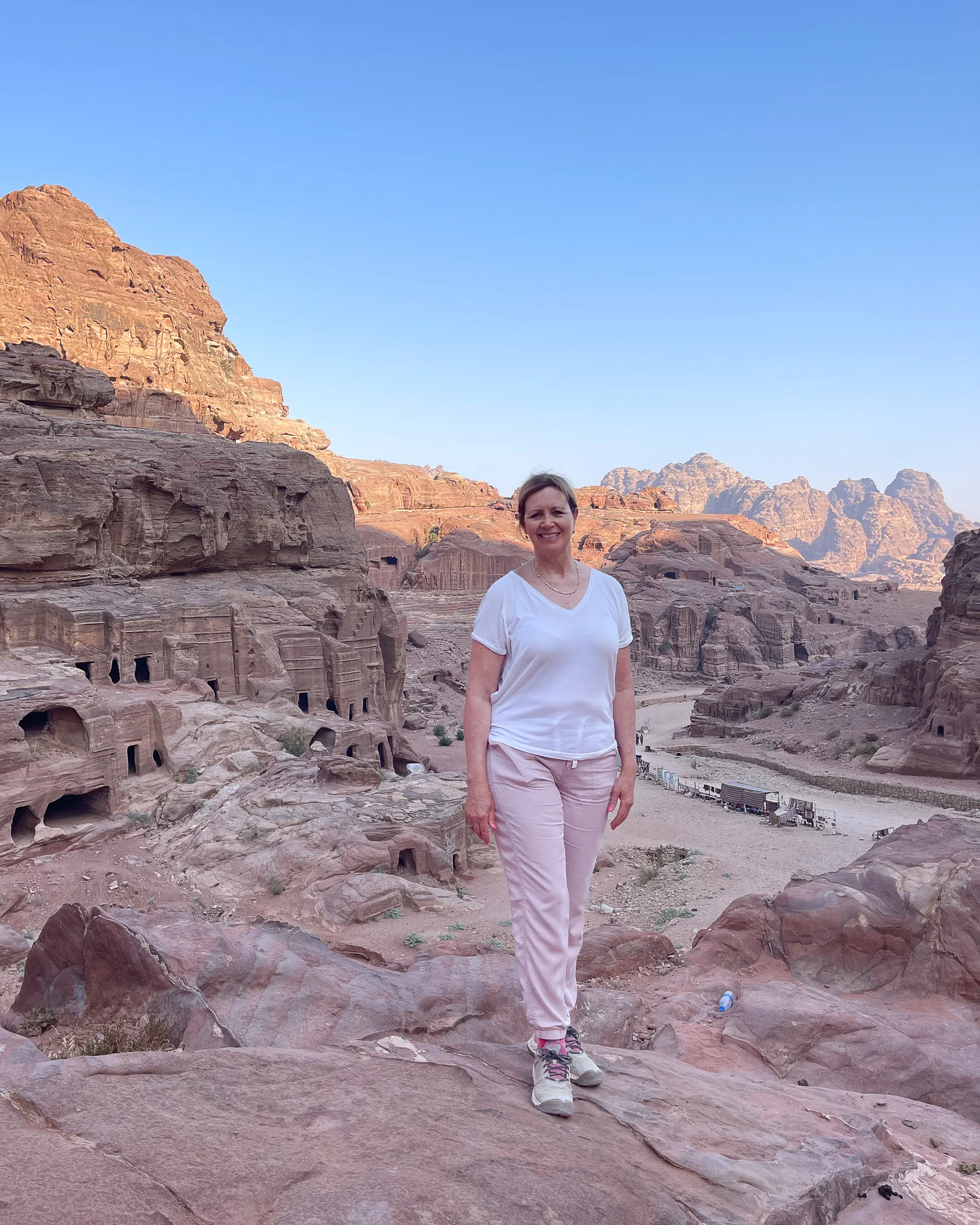
What facilities are there in Petra?
- Free public toilets are available in several places throughout the Petra site.
- There are two main restaurants in the Basin area serving food. Numerous stalls that will sell you tea, water or other soft drinks. At least you should pack water and snacks to keep with you. Most hotels can also provide a picnic.
- There are wifi hot spots in a few places, mainly the same locations as toilets.
- If you are taken ill, assistance is available from the Visitor centre and the police checkpoint by the Basin restaurant.
Is Petra safe?
We felt very safe at Petra and in Jordan in general, since the country has a very low crime rate. Petra is the country’s flagship tourist site, which is well managed and has tourist police within the site.
Jordan, while a stable country, is unfortunately surrounded by neighbours where conflicts and wars may flare up. You should always check your Government’s advice on travel in the region.
The main things you need to watch out for are over-pushy animal handlers and Bedouin keen to sell you souvenirs or drinks. Everyone has to make a living, so just be polite and make sure you agree a price you feel is fair before accepting a service. Women should also be aware of attention from young local men, and respect local norms of modest dress and behaviour.
You should also be conscious of natural hazards, such as the strength of the sun and sudden rain that creates flash floods. There are rocky paths that are unfenced and clifftop viewpoints with a sheer drop below.
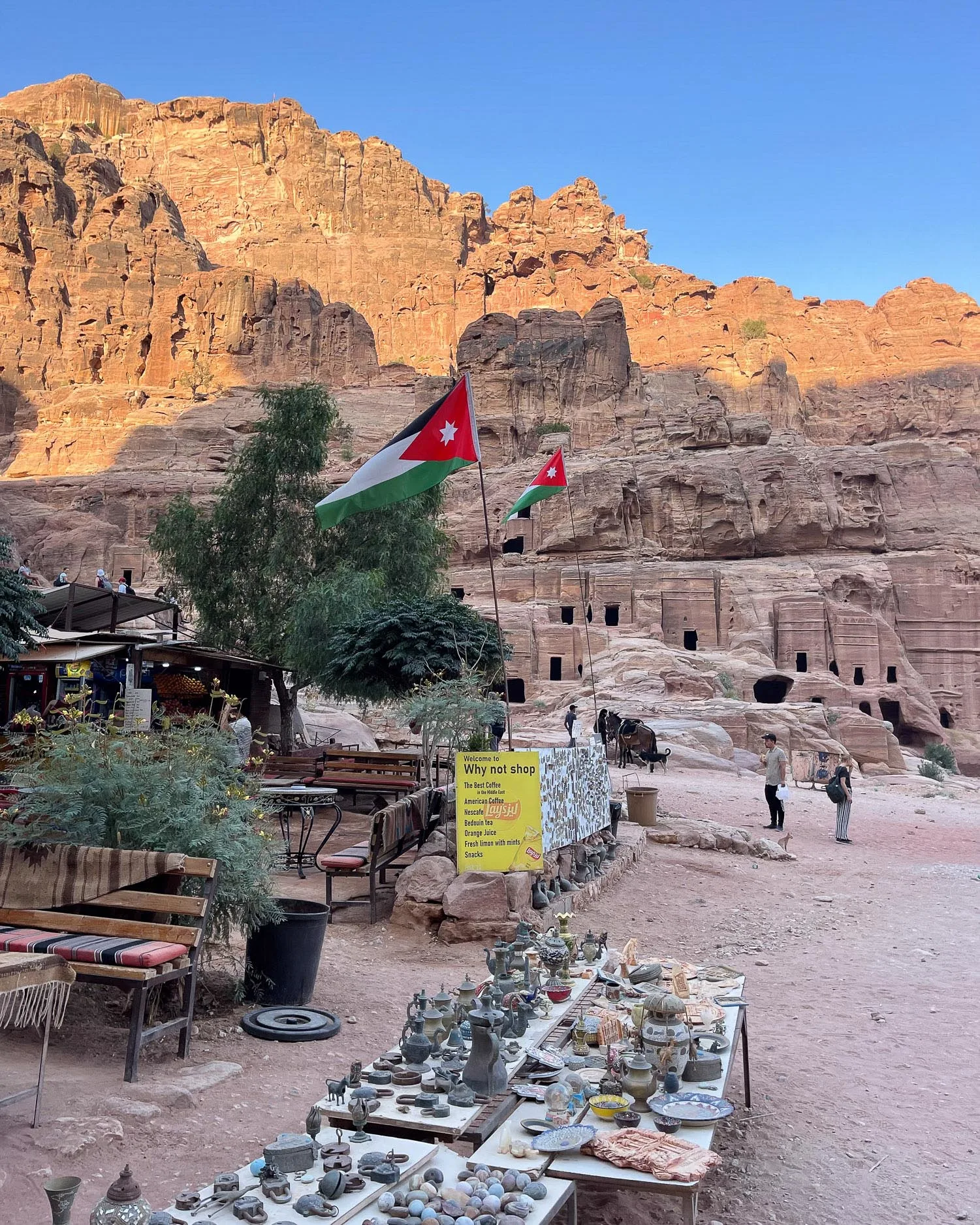
Getting around Petra
- Most people get around the site on foot, although there’s a lot of walking in Petra and the Main Trail is 8km long.
- Animal rides, by camel, horse, horse-drawn carriage or donkey are available in both directions between the Treasury and the Basin Restaurant. You can also hire a donkey to take you up some of the steeper trails.
- Golf buggy style Club Cars are available at the Visitor Centre to take you to and from the Treasury
- Horse rides are available from the end of the Siq, to take you back to the Visitor Centre. This is included in your ticket but a tip is expected.
- If you have limited mobility, we recommend engaging a guide and seeking their advice on the different transport you could use to see the main sites within Petra.
For more advice on animal rides, and our thoughts on this contentious topic, read our article: Visiting Petra in Jordan – the ultimate travel guide
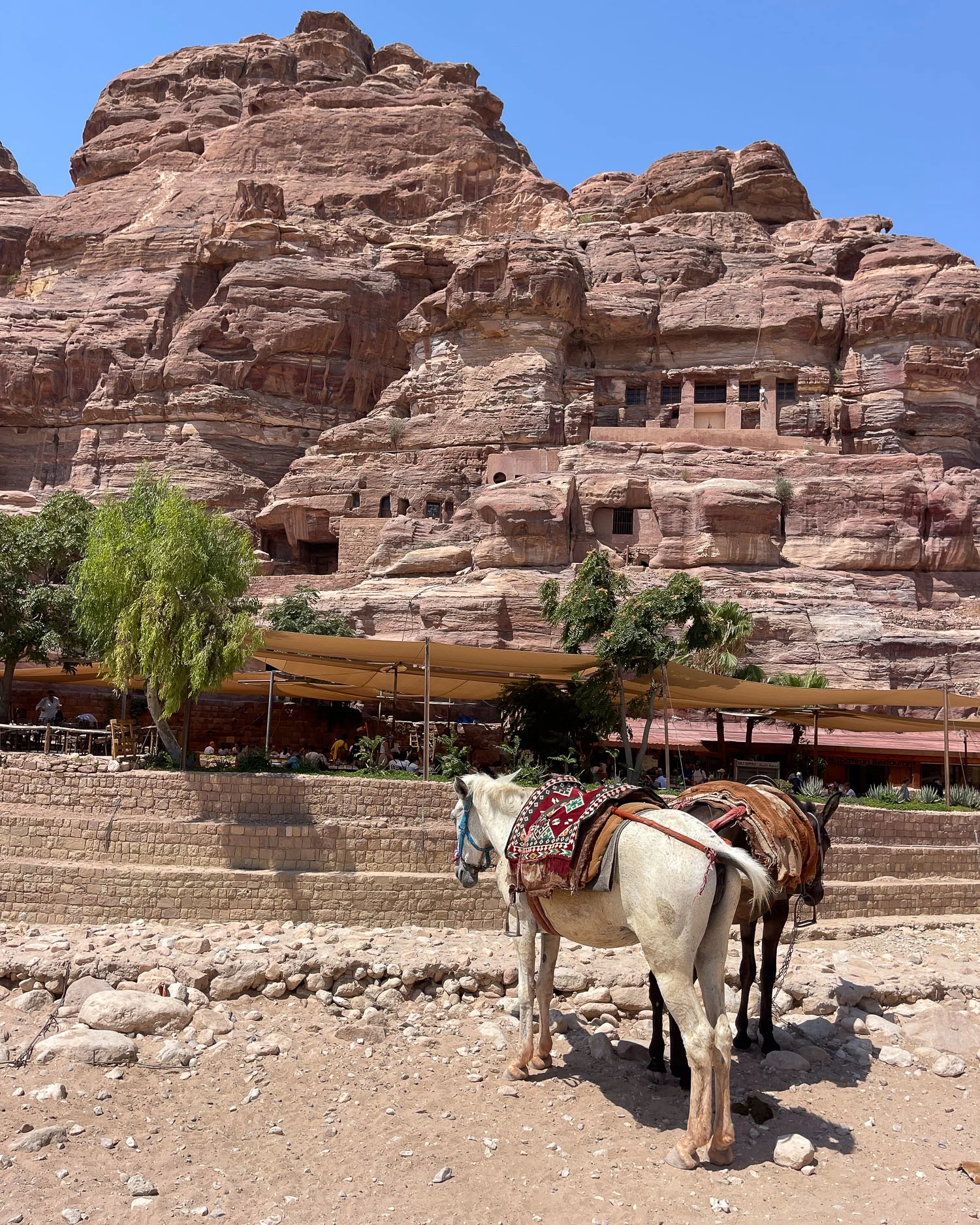
Getting to Petra
Petra is located in the south west of Jordan, 230 km (3 hrs drive) from the capital of Amman in the north or 130 km (2 hrs drive) from the Red Sea resort of Aqaba to the south.
Most international travellers fly into either Amman or Aqaba. They then visit the Petra archaeological site as part of a circular tour of Jordan, visiting tourist sites such as Amman, Petra, Wadi Rum, Aqaba and the Dead Sea.
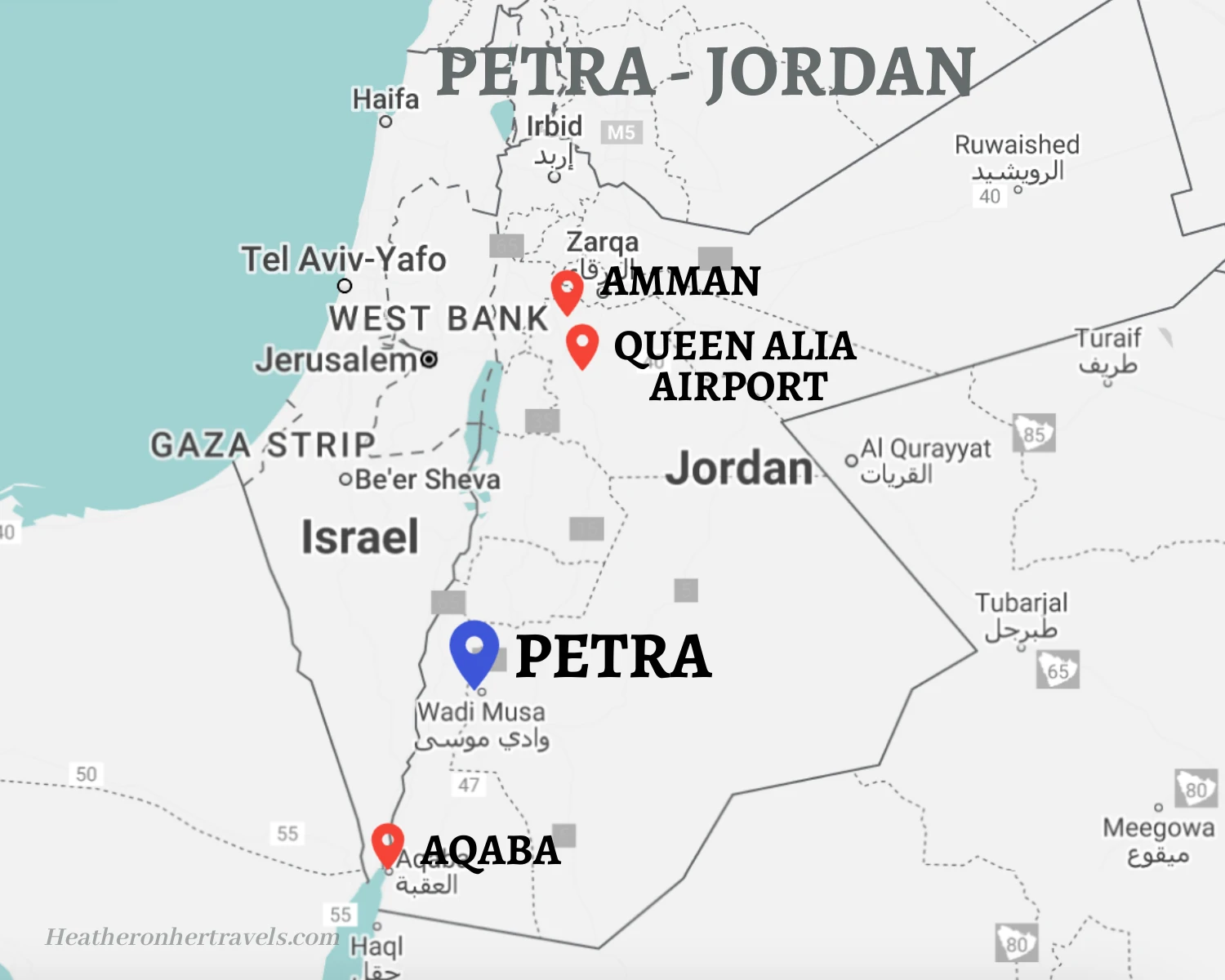
If you visit Petra independently, you can easily reach Wadi Musa, the town that serves Petra, in a number of ways
- Hire a car and drive yourself from Queen Alia International Airport close to Amman, from Aqaba or from other tourist locations
- Take the bus with JETT. There is one bus a day in each direction between Amman and Petra or Aqaba and Petra
- Take a taxi transfer, which can be arranged by your hotel from any of the main cities or tourist locations.
For more detail on transport options, read our article: Visiting Petra in Jordan – the ultimate travel guide
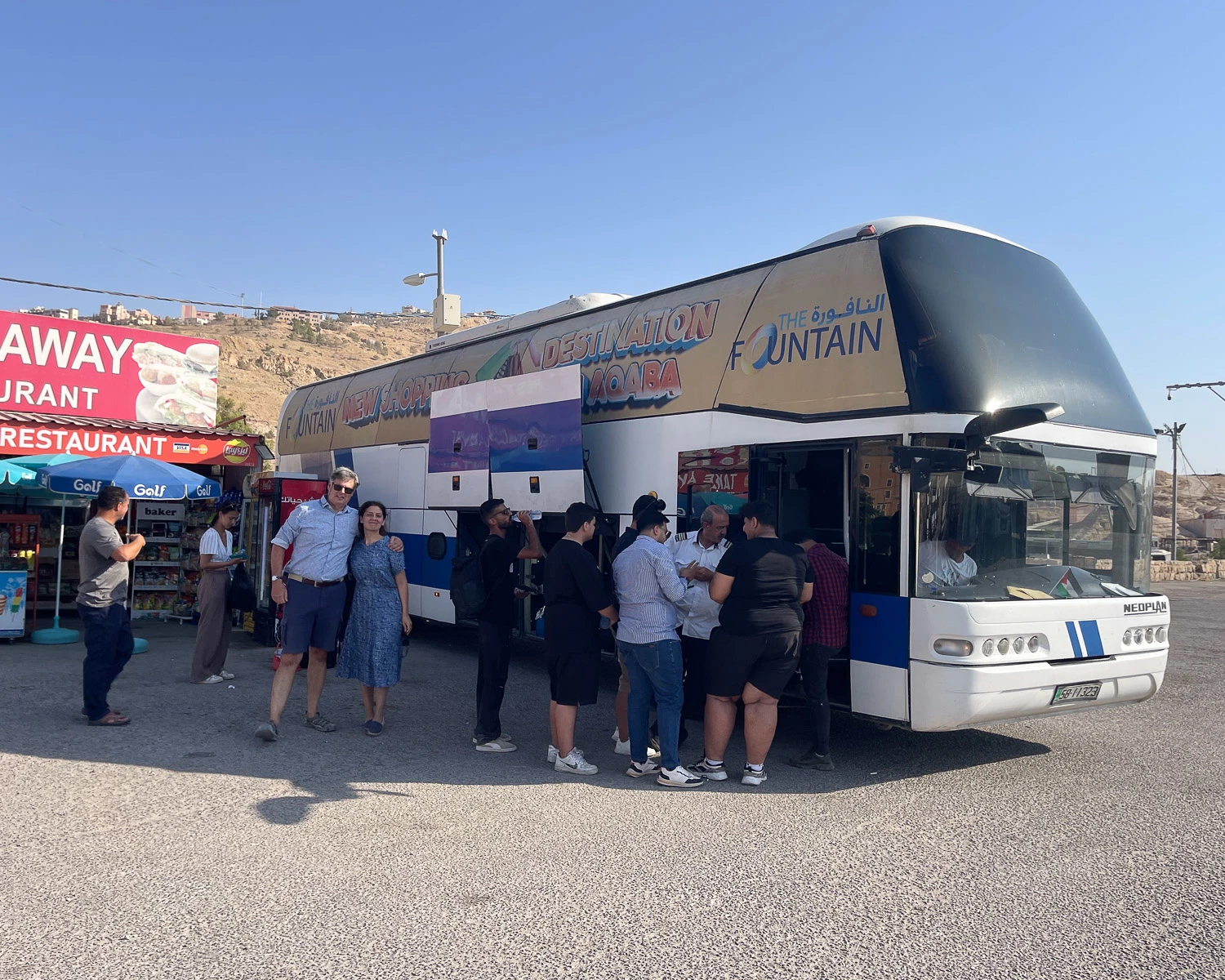
More information to plan your trip
You’ll find more information to plan your trip on the following official tourism websites
- Visit Petra Official Tourism Website
- Visit Jordan Official Tourism Website
- Jordan Pass Official Website
Read Next
Check out my ultimate travel guide to visiting Petra in Jordan
Guide Book for Jordan
We found it extremely useful to have a guidebook to Jordan. Signage at the top sites like Petra can be limited and hiring a guide can be expensive. We recommend and used the Lonely Planet Guide to Jordan.

Need a guidebook for Jordan? We recommend the Lonely Planet Jordan Travel Guide
You may also enjoy
- Eight things to see in Siwa Oasis in Egypt
- St Anthony’s Monastery of Qozhaya in Lebanon
- Things to do in Casablanca, Morocco – 5 of the best reasons to visit!
Pin it!
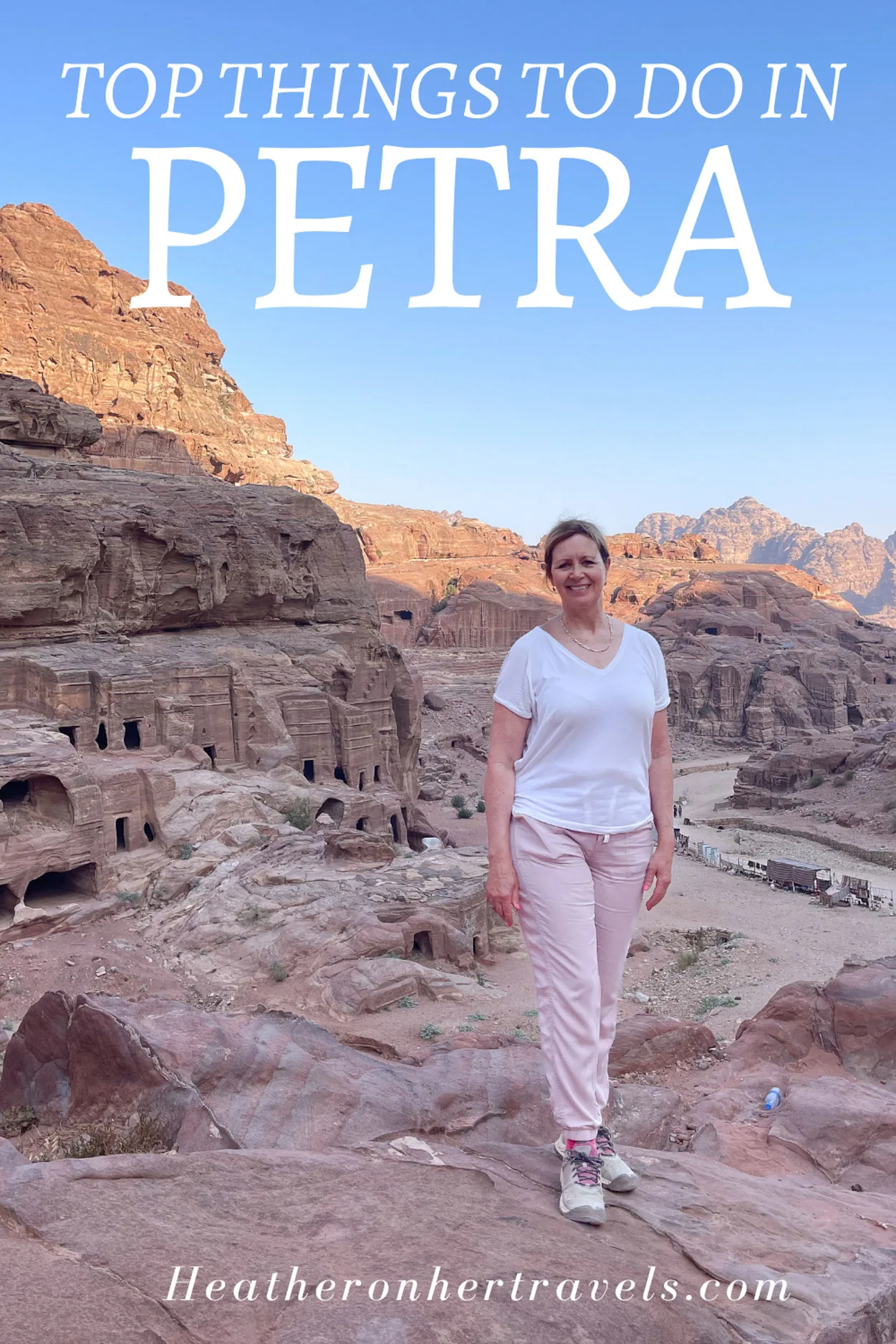
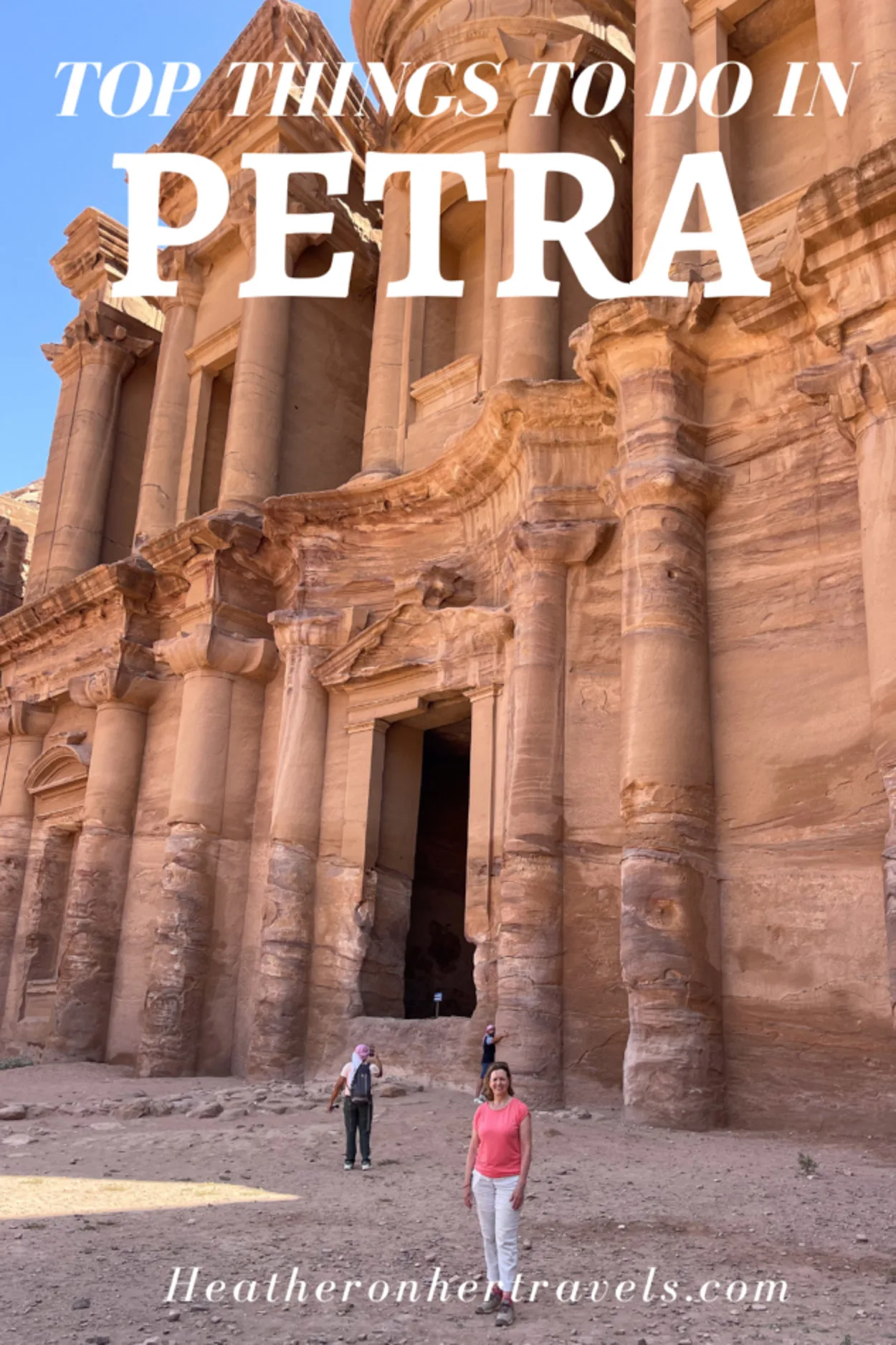
This article is originally published at Heatheronhertravels.com

